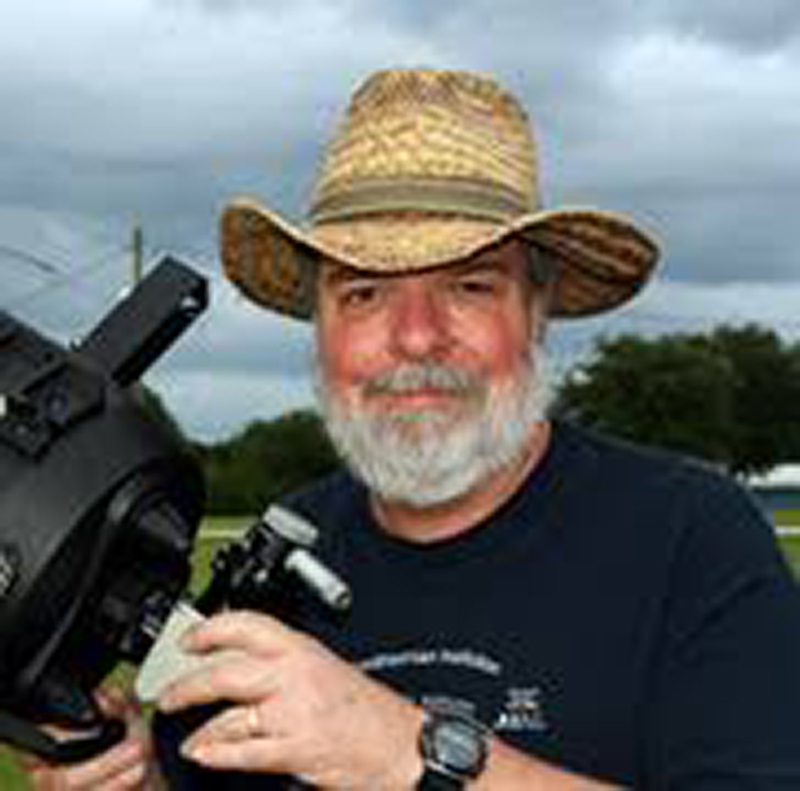The constellations are key when learning how to navigate your way around the night sky.
These star patterns can be used to star-hop to various targets, including planets, stars and other deep-sky objects, but constellations also split the celestial sphere into neat sections, enabling the night sky to appear a little less daunting for beginners.
In all, there are 88 formally-recognised constellations, although it wasn't always that way.
Up until the early 20th century, constellations were relatively unstandardised, until in 1922 the International Astronomical Union (IAU) agreed on a defined set of 88 star patterns that are the constellations we know and love today.
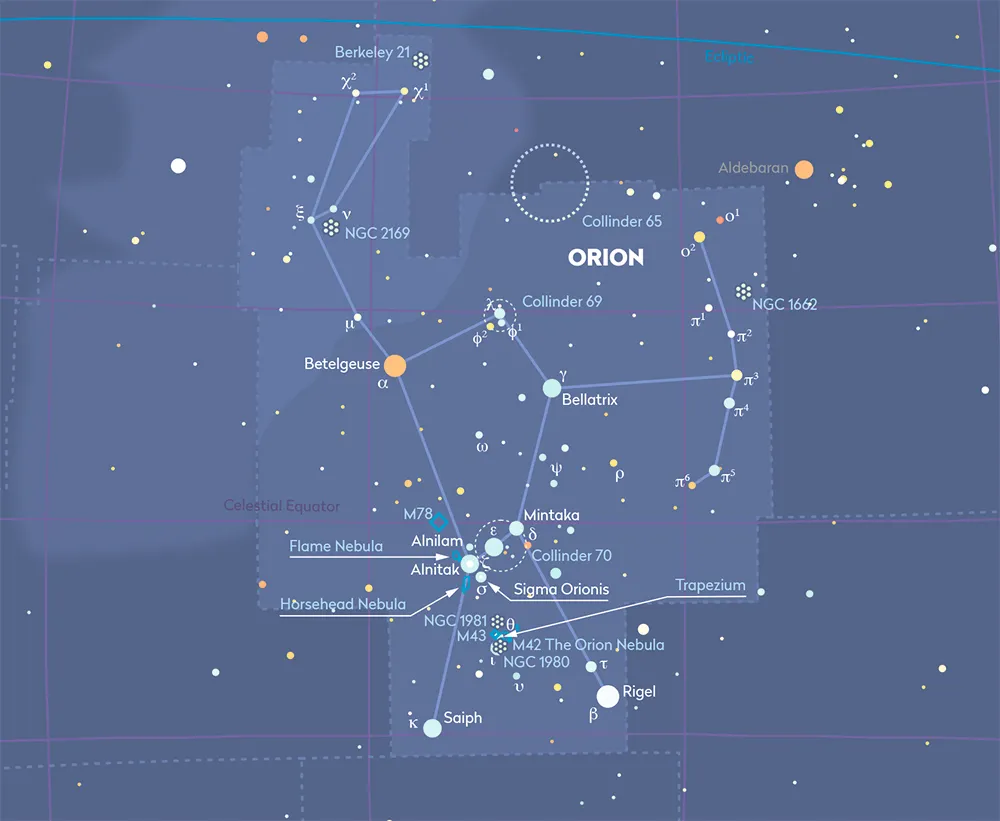
In 1925, the IAU agreed upon the boundaries surrounding those 88 constellations, meaning that every section of the night sky fell within the region of a recognised constellation.
This is why a planet, star, galaxy or nebula may be said to be found within a specific constellation, even if it's not actually located within the marked star pattern itself.
In this guide we'll reveal some of the best constellations visible in the night sky from urban locations, which means that no matter where you are in the northern hemisphere, you should be able to enjoy many of the targets on this list.
We've also selected some of the best deep-sky objects that can be found within those constellations, giving you incentive to delve deeper into each one with binoculars or a telescope.
As this is a guide intended for use by city stargazers as well as those lucky enough to live under more remote, dark skies, we'll start with a word on urban astronomy.
Find out which constellations are visible all year round in our guide to circumpolar constellations.
Observing constellations from urban environments
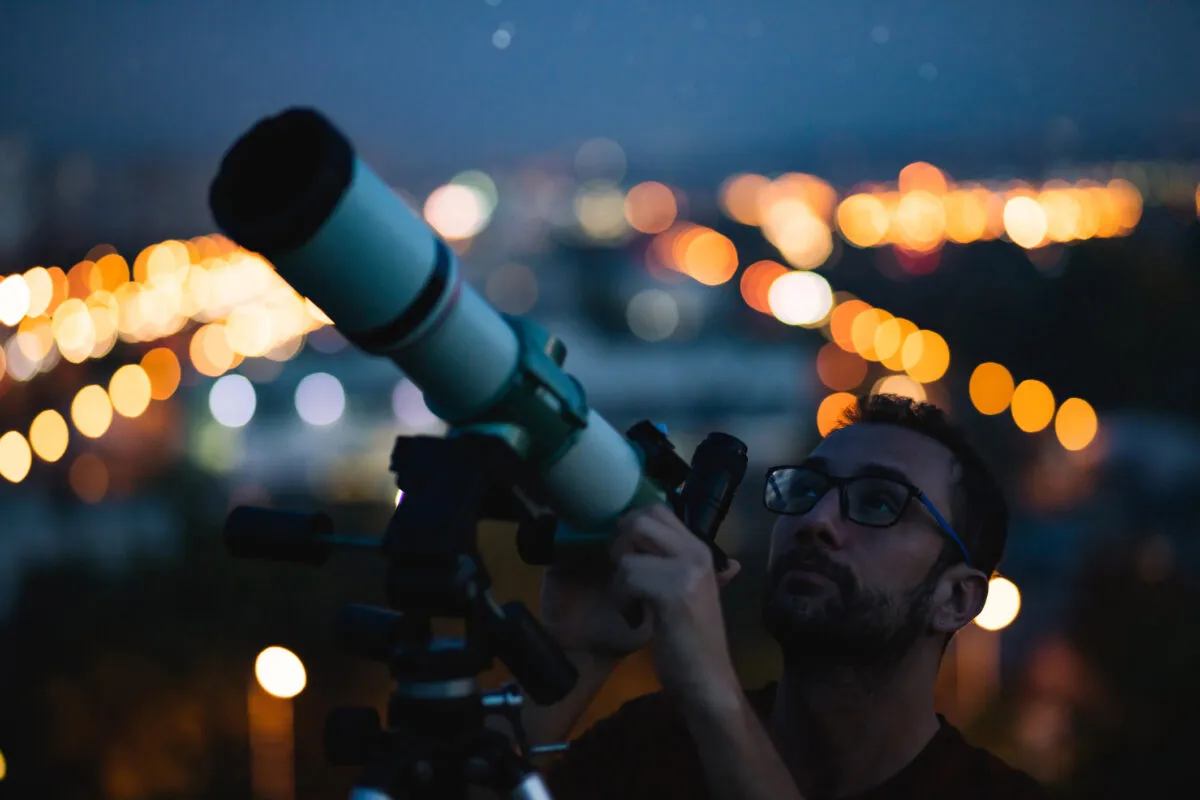
Urban astronomy is not for the faint-hearted, but persevere and you will find a wealth of celestial treasures that await discovery, even under bright night skies.
Many deep-sky objects are visible even in brightly lit urban areas.
Take open star clusters, nests of thousands of newborn stars, deep-sky objects which are the least harmed by light pollution.
More tightly packed globular clusters are very old and light pollution takes its toll on them.
While many are visible in the city with smaller aperture telescopes, most are just round smudges with no individual visible stars.
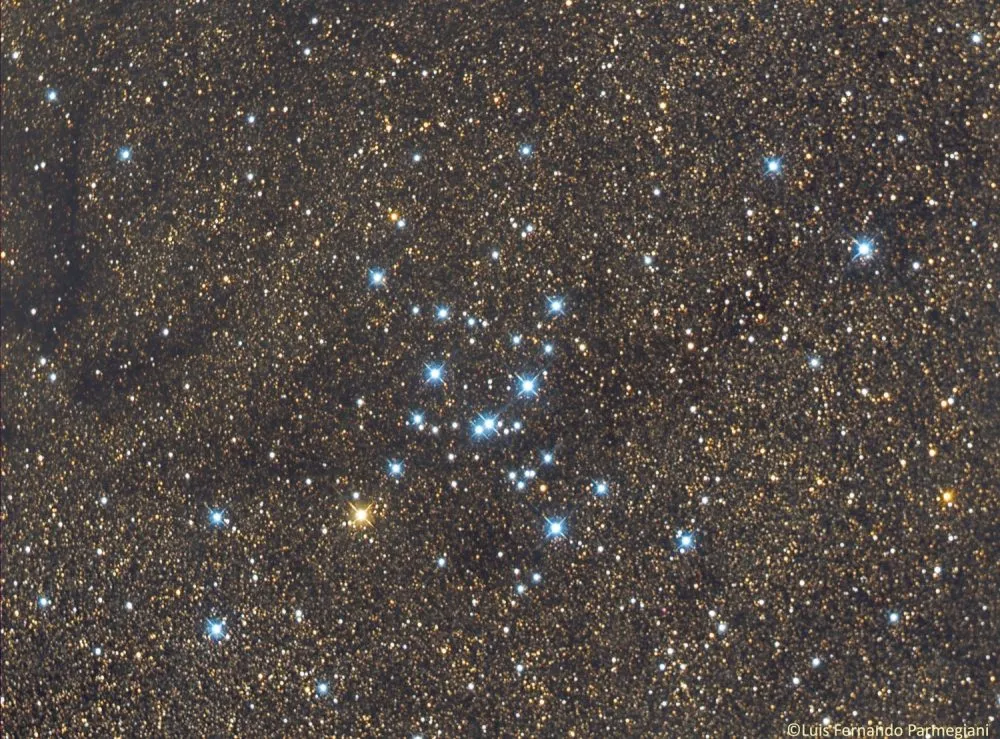
Galaxies can be challenging for urban observers to see. This doesn’t mean you can’t see them, you just won’t see much detail.
But diffuse nebulae are the objects most harmed by light pollution; even with a high-quality light-pollution reduction (LPR) filter screwed onto the eyepiece, dimmer emission nebulae can be a challenge to see.
Planetary nebulae are not as harmed by light pollution. If they are tricky it’s because they are difficult to distinguish from stars.
For more advice, read our guide on how to stargaze from a light-polluted city.
Equipment for city astronomy
Telescope
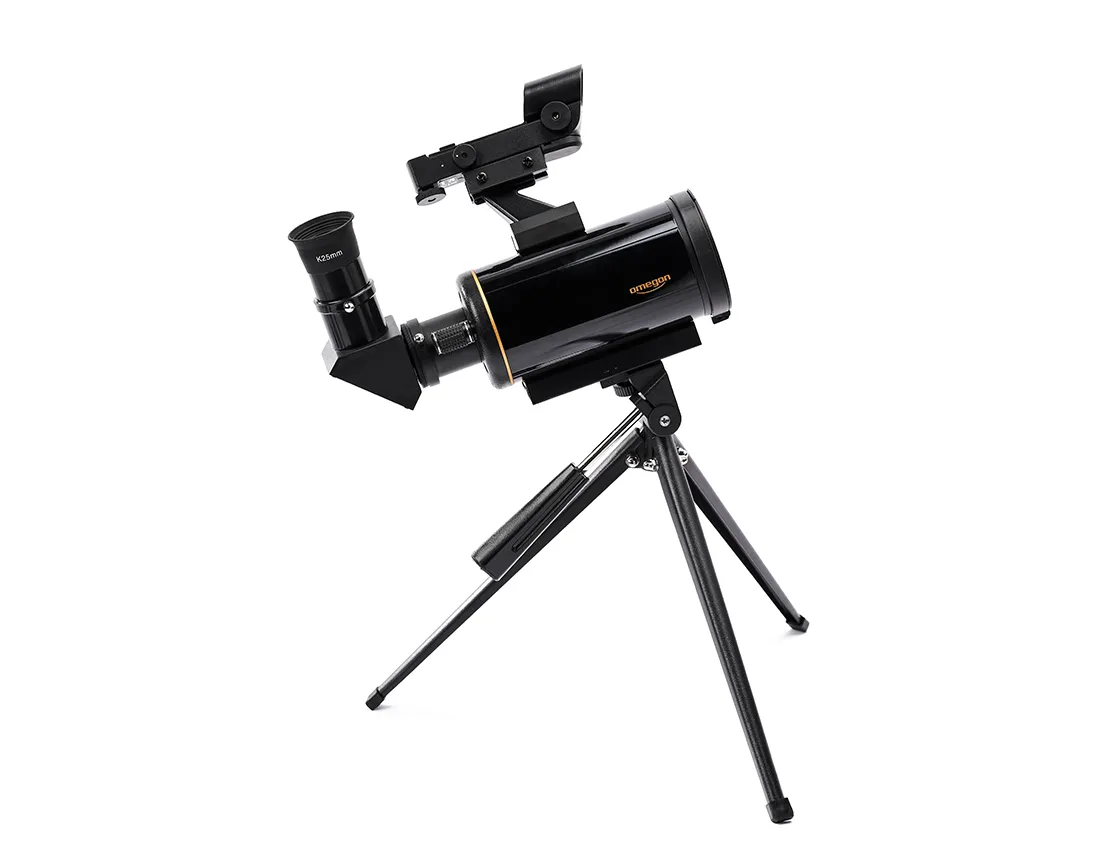
The most important characteristic of a telescope used for deep-sky observing from any site is aperture – the size of its light-collecting lens or mirror (the ‘objective’).
The superior light-gathering power of a larger telescope is even more important in the city.
From a light-polluted area, you’ll need one with a light-collecting lens or mirror with a diameter of at least 200mm.
Inexpensive Dobsonian reflecting telescopes are a good balance between price, performance and portability.
However, a 250mm Dobsonian is almost as affordable and portable, and the extra aperture makes a difference.
Mount
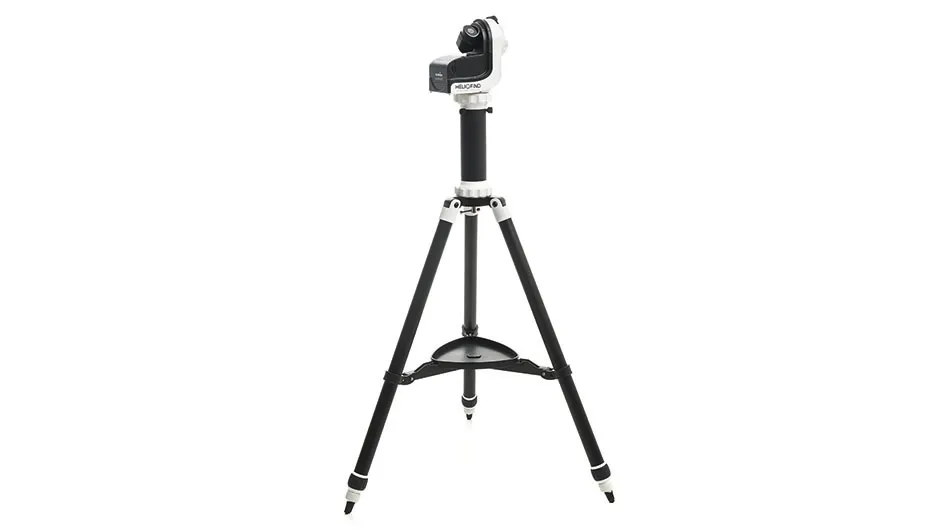
When it comes to mounts, new observers will find any altaz mount less complicated to use than an equatorial mount.
A Go-To mount is useful in urban areas: just enter the ID of a deep-sky object into its computer hand control and the scope will move to it.
Light pollution reduction filters
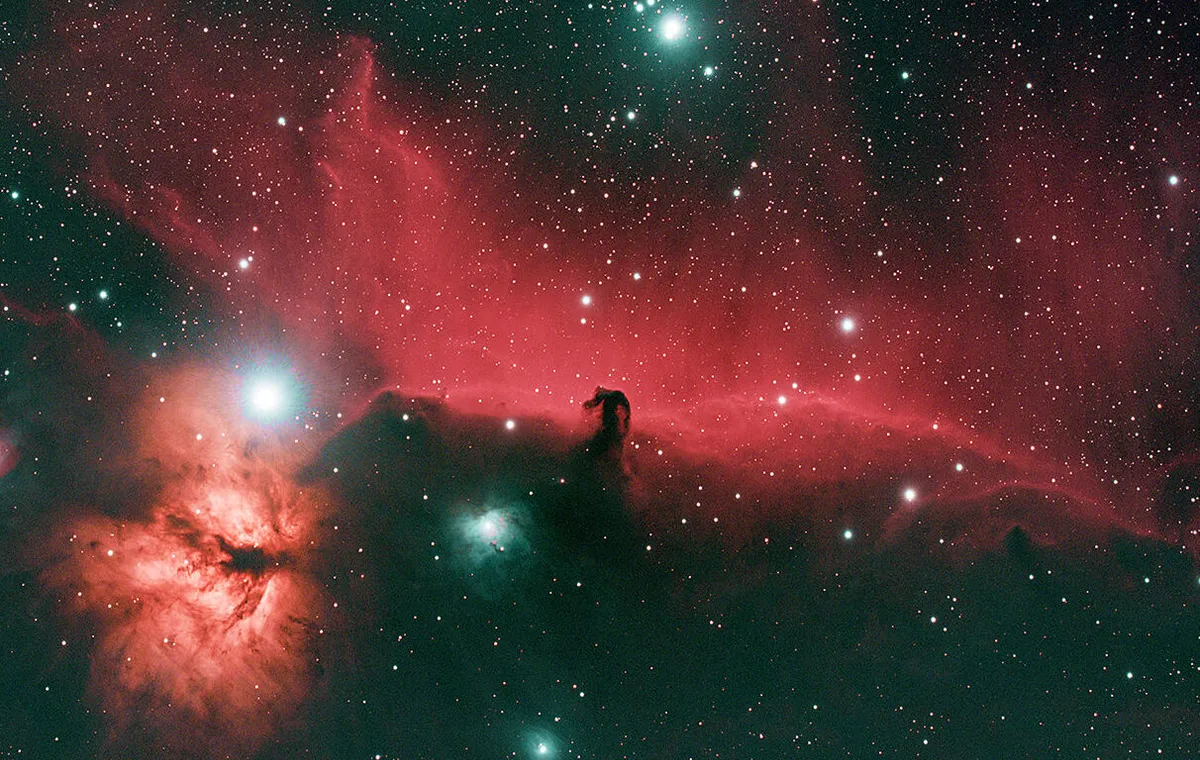
LPR filters can also help, but don’t expect even the most expensive one to pull Orion’s dim Horsehead Nebula out of an orange sky.
LPR filters only work on diffuse and planetary nebulae, and they are useless for galaxies and star clusters.
While they block certain light wavelengths, including those of incandescent, sodium and mercury vapour streetlights, the light of the stars is in the same range of wavelengths.
Since galaxies and star clusters are made up of stars, they are dimmed by LPR filters rather than enhanced.
Tips for urban astronomy
Use averted vision
Averted vision involves looking at objects out of the corner of the eye. By looking to the side of a faint object, you can make it appear brighter and more detailed.
Tap the telescope
Moving objects are generally easier to see in the night sky from a city. If a celestial target is invisible, you can gently tap the telescope tube so it vibrates.
Block ambient light
Turn off any nearby lights, shield the telescope from lights, or drape a dark cloth over your head and eyepiece to allow your eyes to become more dark-adapted.
Now you're ready to go, let's begin our tour of some of the best constellations to see throughout spring, summer, autumn and winter.
Spring constellations
Cancer, the crab
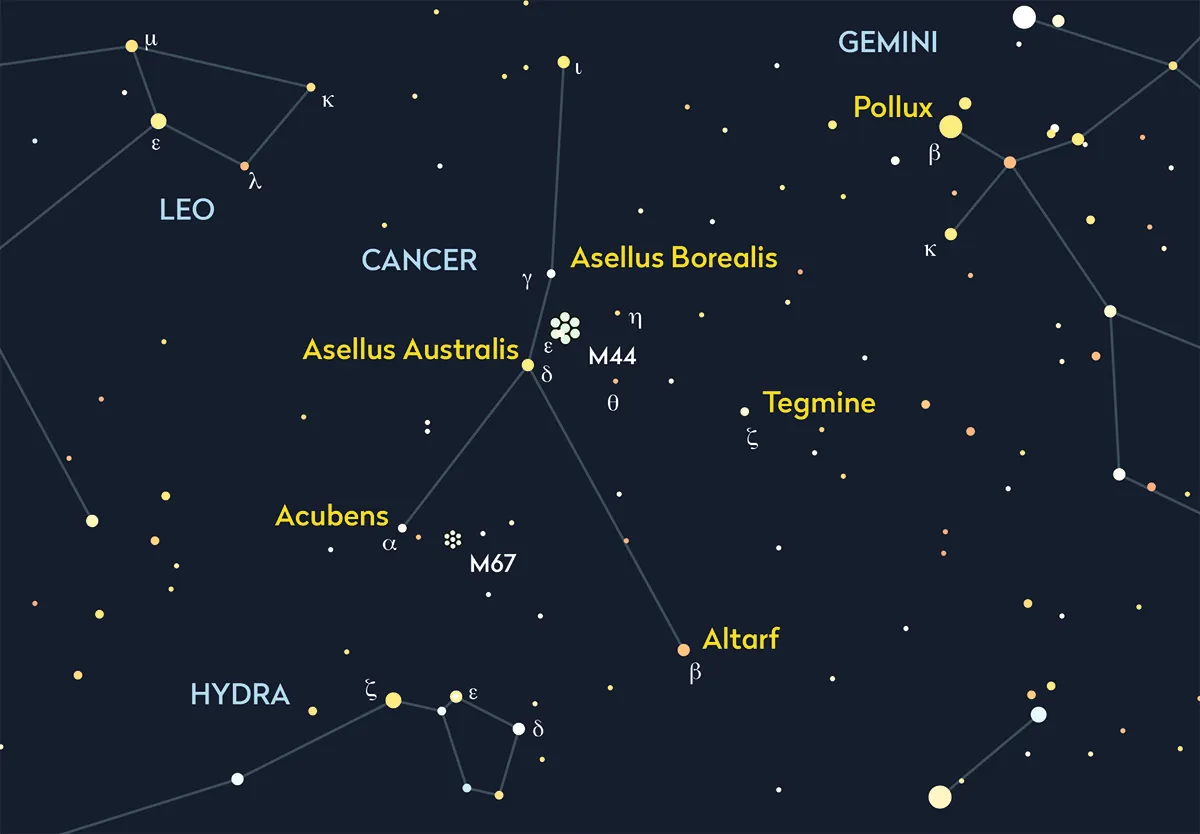
Open star cluster M67 (mag. +6.9, 30’ across) is located in the eastern part of Cancer, 1° 44’ west of mag. +4.2 star Acubens (Alpha (α) Cancri).
While most open clusters are young, M67 is old – between 3 to 5 billion years.
It may not be a spectacular sight, but it is visible from urban and suburban locations and is well-framed in a medium-power eyepiece.
M44, (mag. +3.1, 1° 10’ across), is located near the centre of Cancer’s stick figure.

Also known as the Beehive Cluster, from dark locations M44 is visible as a hazy patch with the naked eye, with 20 stars glowing at mag. +8.0 or brighter.
The brightest, Epsilon (ε) Cancri, is nearly visible without optical aid at mag. +6.3.
M44 is not as impressive in a telescope as you might expect. With a diameter of 1° 10’, it’s too large to fit in the field of view of low power eyepieces in all but the smallest scopes.
For more advice, read our guide to the constellation Cancer
Leo, the lion
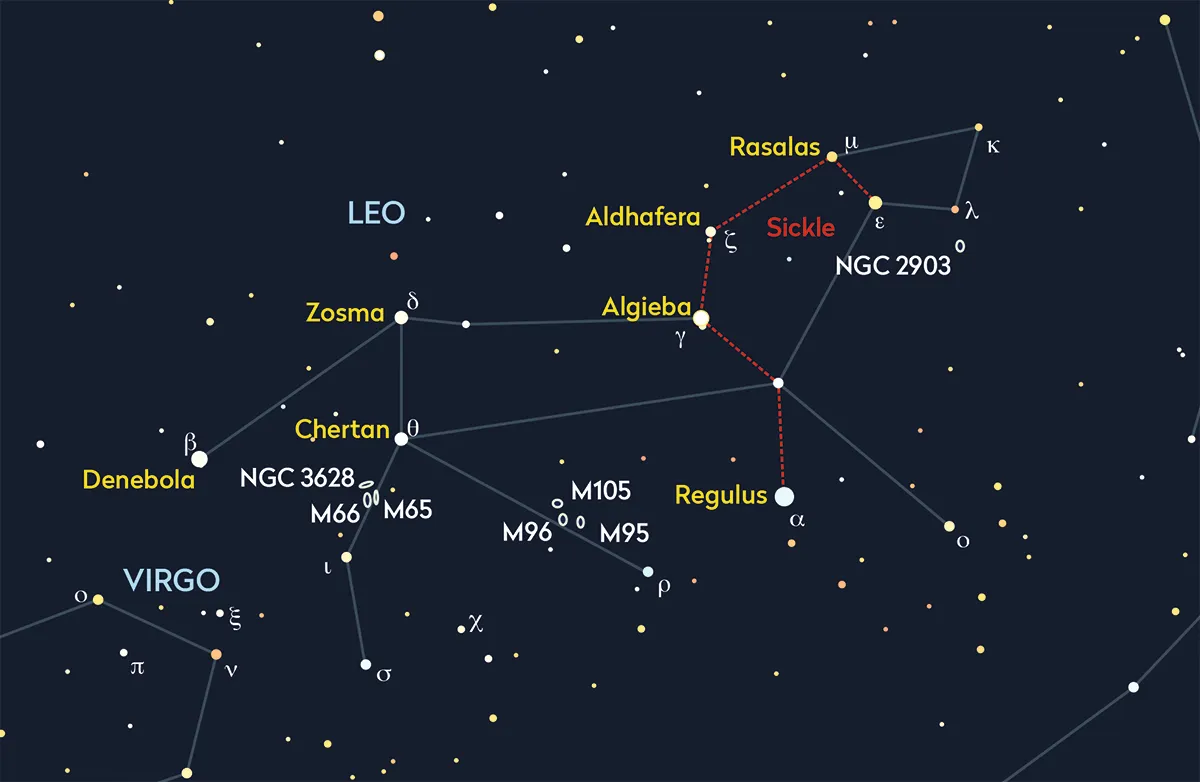
Leo’s galaxy pair, M65 and M66, are both bright enough to shine through even badly light-polluted inner city skies.
The more western and dimmer of the pair is galaxy M65 (mag. +10.5, 8’42” x 2’27”).
M66 (mag. +8.9, 9’6” x 4’12”) is visually brighter than its companion, despite being larger in size.
A view through a 300mm telescope will reveal a little detail, but an increased aperture won’t make a big difference in heavy light pollution – the real improvement comes with darker skies.
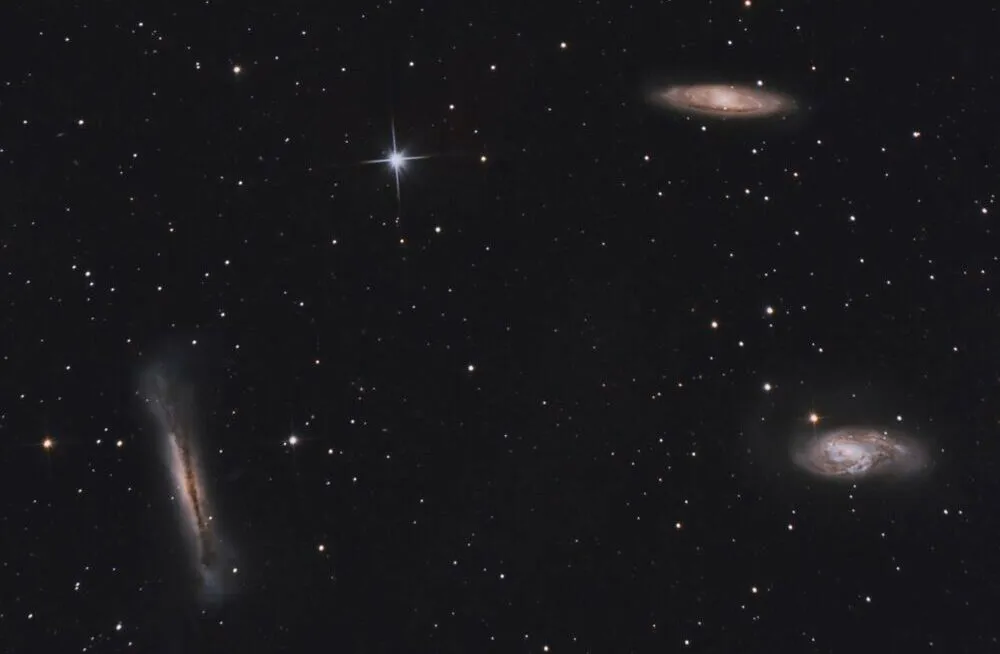
In a more suburban location, instruments with an aperture of 250mm or larger can reveal spiral detail in M66, while magnifications of 200x or higher can show hints of mottling on M65’s disc.
A third, dimmer, nearby galaxy is NGC 3628 (mag. +9.5, 10’34” x 2’32”), which makes up the ‘Leo Triplet’ with M65 and M66.
From a suburban area it is easier to see with a 250mm telescope, and on a good night you can see why it is called the Hamburger Galaxy, because an equatorial dust lane slices through its disc – the ‘bun’.
For more advice, read our guide to the Leo constellation.
Ursa Major, the great bear
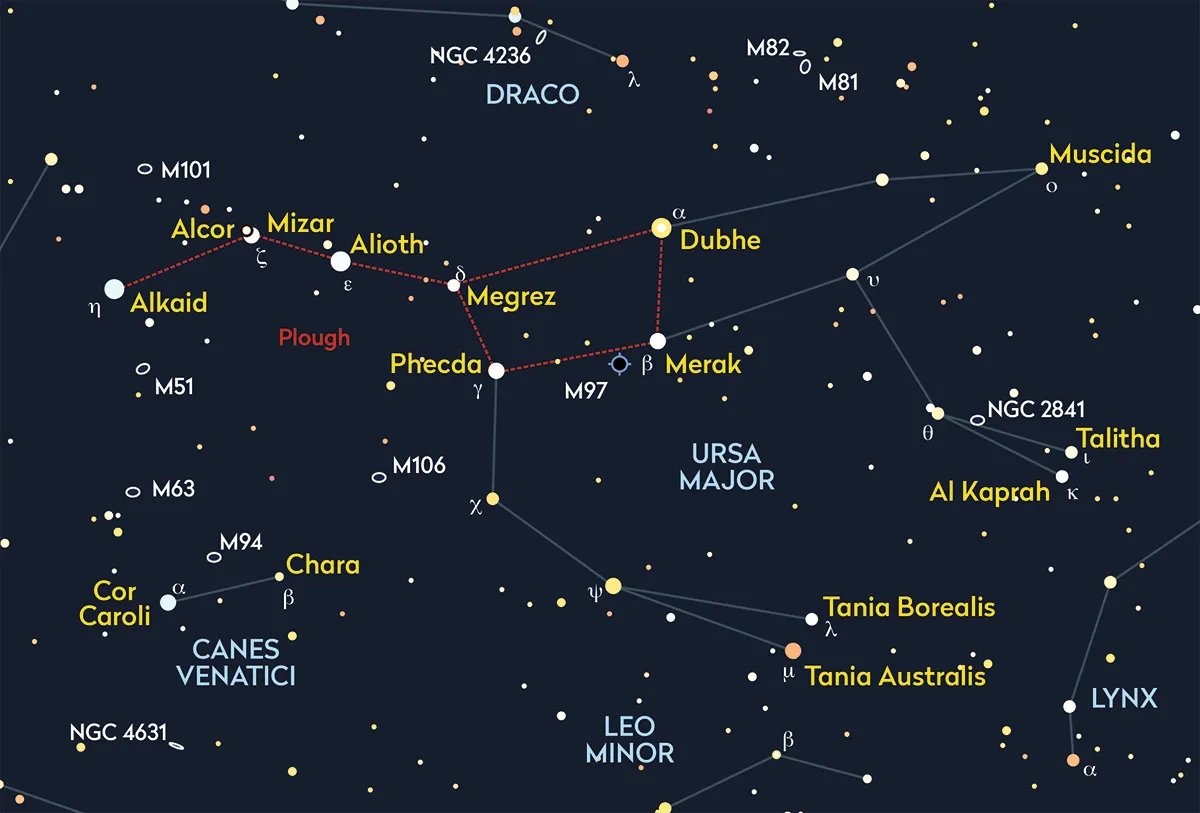
Ursa Major is home to the famous Plough asterism. But it is far more than that, as it contains some stunning galaxy targets.
M82 (mag. +8.4, 11’12” x 4’18”) is possibly the best galaxy in the northern sky for city observers, because of its favourable magnitude and size.
Nicknamed the Cigar Galaxy, it is so-called because of its elongated, lens-shaped disc.
An even better name might be the ‘Exploding Cigar Galaxy’, because it’s crossed by bright and dark lanes and is throwing off huge clouds of gas.
Some of these features are visible even to city-bound telescopes.
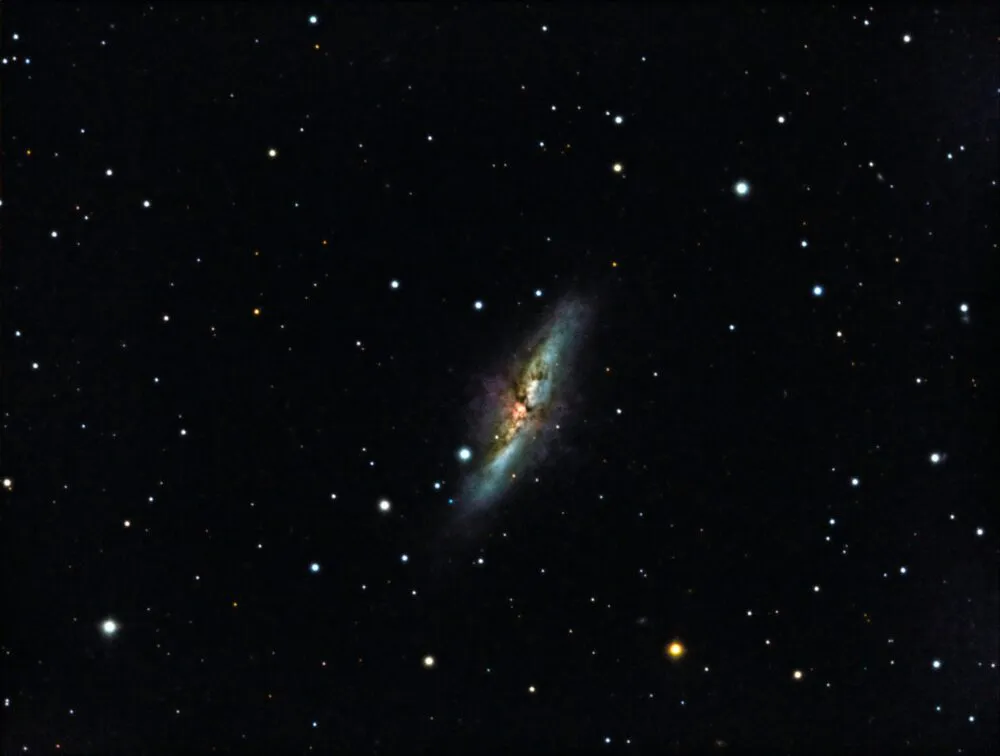
M82 is not actually exploding, it is undergoing massive bouts of star formation and other effects caused by an encounter with a nearby galaxy, most likely M81.
Its gas and dust have been compressed and hordes of new stars are being born across its disc.
M81 (mag. +6.9, 26’54” x 14’6”) is also known as Bode’s Galaxy – after Johann Elert Bode, the German astronomer who discovered it in 1774.
As its orientation is between face-on and edge-on, its surface brightness is high, and it is easy to see the bright centre of M81 in a small telescope under a light-polluted sky.
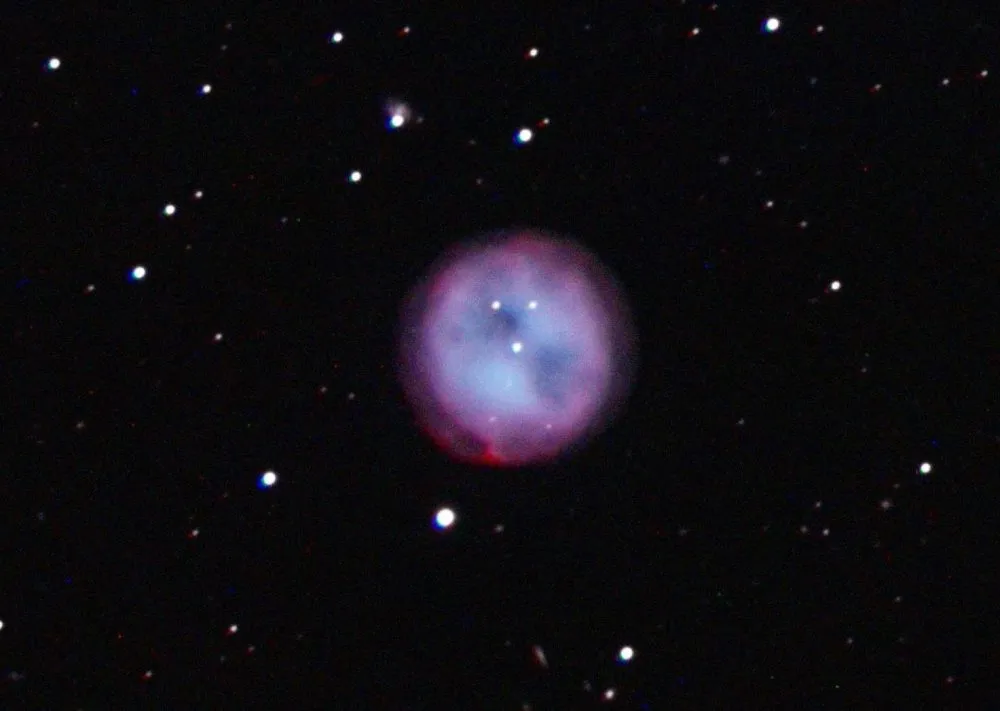
In Ursa Major, you can also look for M97 (mag. +9.9, 3’24” x 3’18”), the Owl Nebula, just below the Plough asterism.
It’s a large, round, planetary nebula with two dark spots that represent the Owl’s eyes.
Light pollution takes its toll on nebulae; while M97 is not overly dim or large, you will need an OIII (Oxygen) filter to see it if you are using a 300mm telescope in the city or further out in the suburbs.
Canes Venatici, the hunting dogs
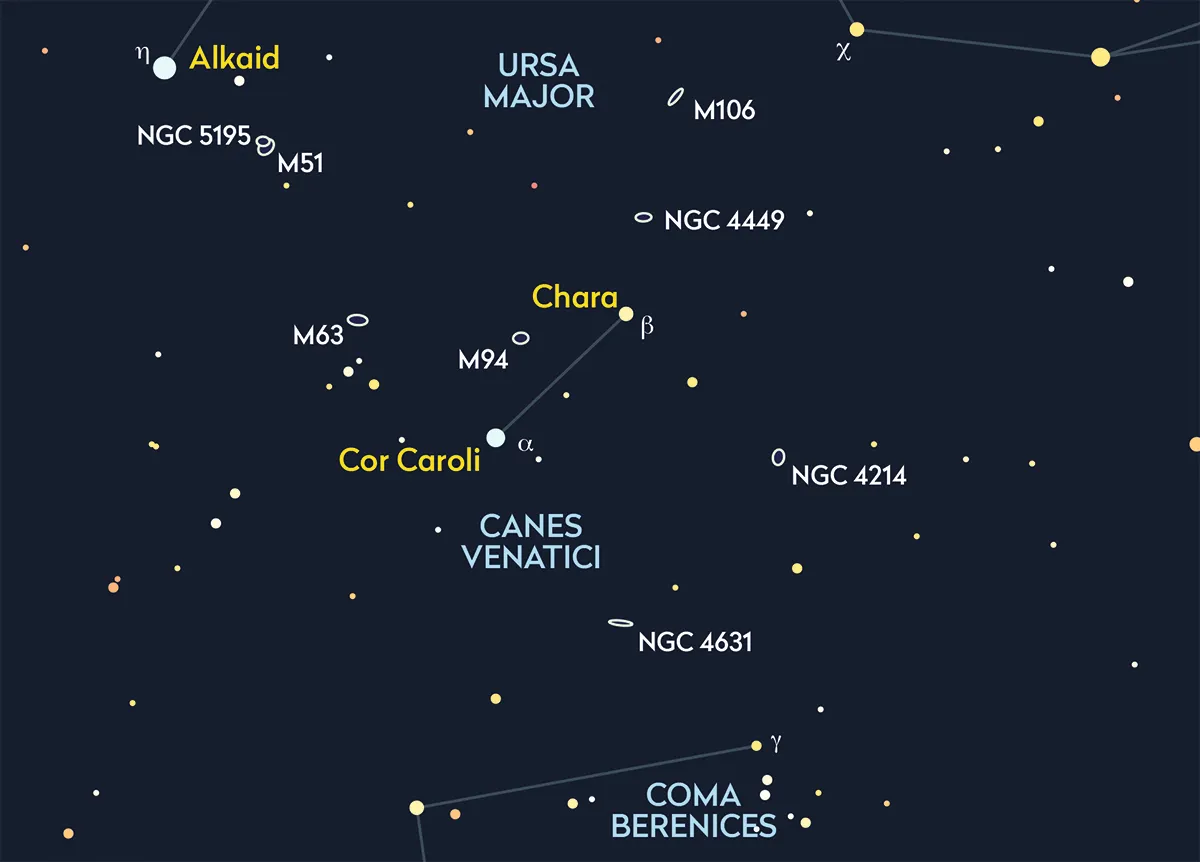
M51 and its smaller companion galaxy, NGC 5195 (combined mag. +8.1, 11’12” x 6’54”) are known collectively as the Whirlpool Galaxy.
Low surface brightness, caused by the orientation of M51, means it can be tricky to see, but it is always detectable.
M51 is located just over the Ursa Major–Canes Venatici border, 3°51’ north of the bright star Alkaid (Eta (η) Ursae Majoris), the ‘end’ star in the Plough asterism.
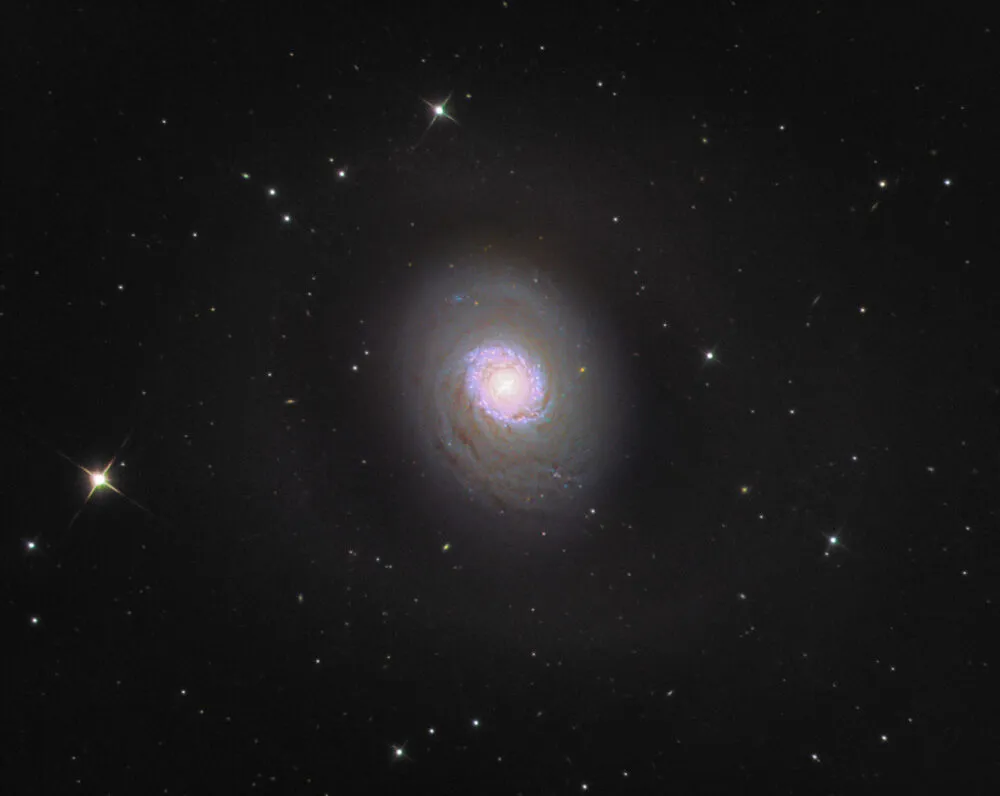
M94 (mag. +8.2, 11’12” x 9’6”) is a spiral galaxy, located halfway along and 1 arcminute northeast of a line drawn between the stars Chara (Beta (β) Canum Venaticorum) and Cor Caroli (Alpha (α) Canum Venaticorum).
It is so bright and prominent that it is visible on the poorest nights, thanks to an intense bout of star formation in its inner regions that results in a central area less than 1 arcminute in diameter that shines intensely.
For more advice, read our guide to Canes Venatici
Coma Berenices
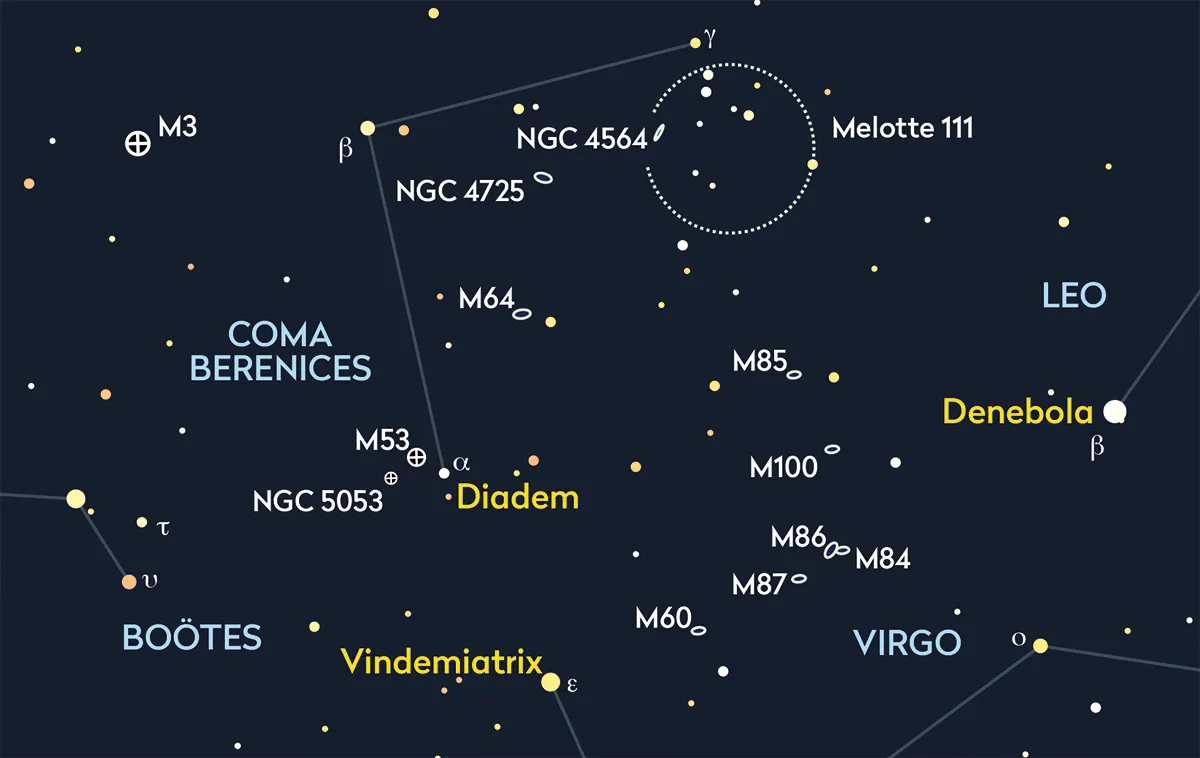
M64, the Black Eye Galaxy (mag. +8.6, 10’42” x 5’7”) is one of the most beautiful objects in the northern sky, despite its unimpressive specifications.
From the city it can be observed with a 100mm reflector, but there will be no hint of the dark patch of dust near its centre that earns it its Black Eye moniker.
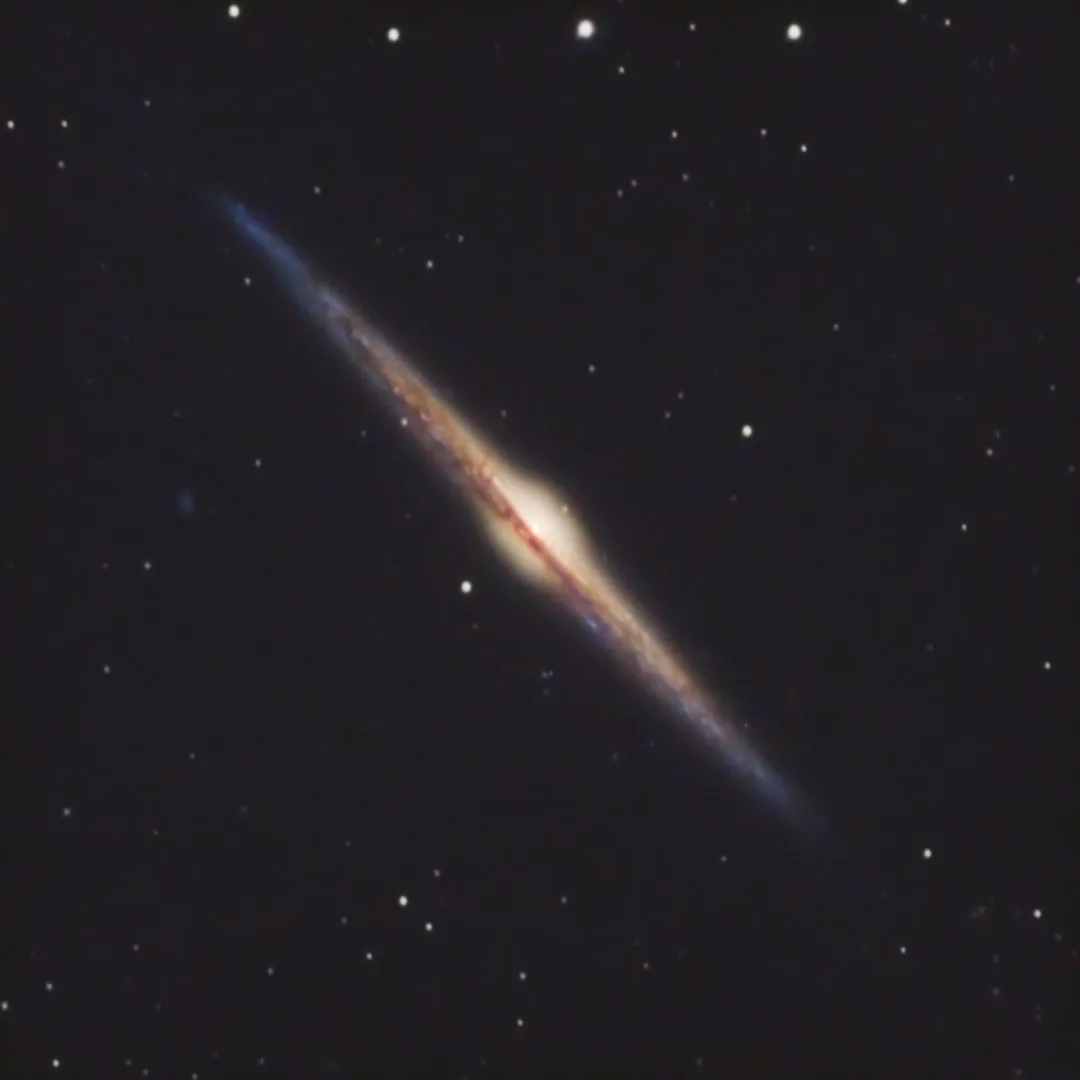
NGC 4565 (mag. +10.4, 15’54” x 1’) the Needle Galaxy, has a dim magnitude value that is offset by its shape – edge-on, with a long, thin, needle-like disc.
Its thin body keeps its surface brightness high.
M100 (mag. +9.3, 7’24” x 6’18”) is a face-on spiral galaxy. It’s not large and its surface brightness is low due to its face-on orientation.
A good night can show some hints of detail, while a 12mm eyepiece at 150x magnification can show mottling.
One of Coma’s best objects is M53 (mag. +8.3, 13’ across). An attractive globular cluster, it’s easy to see from a city with a 150mm telescope.
For more advice, read our guide to Coma Berenices
Virgo, the Virgin
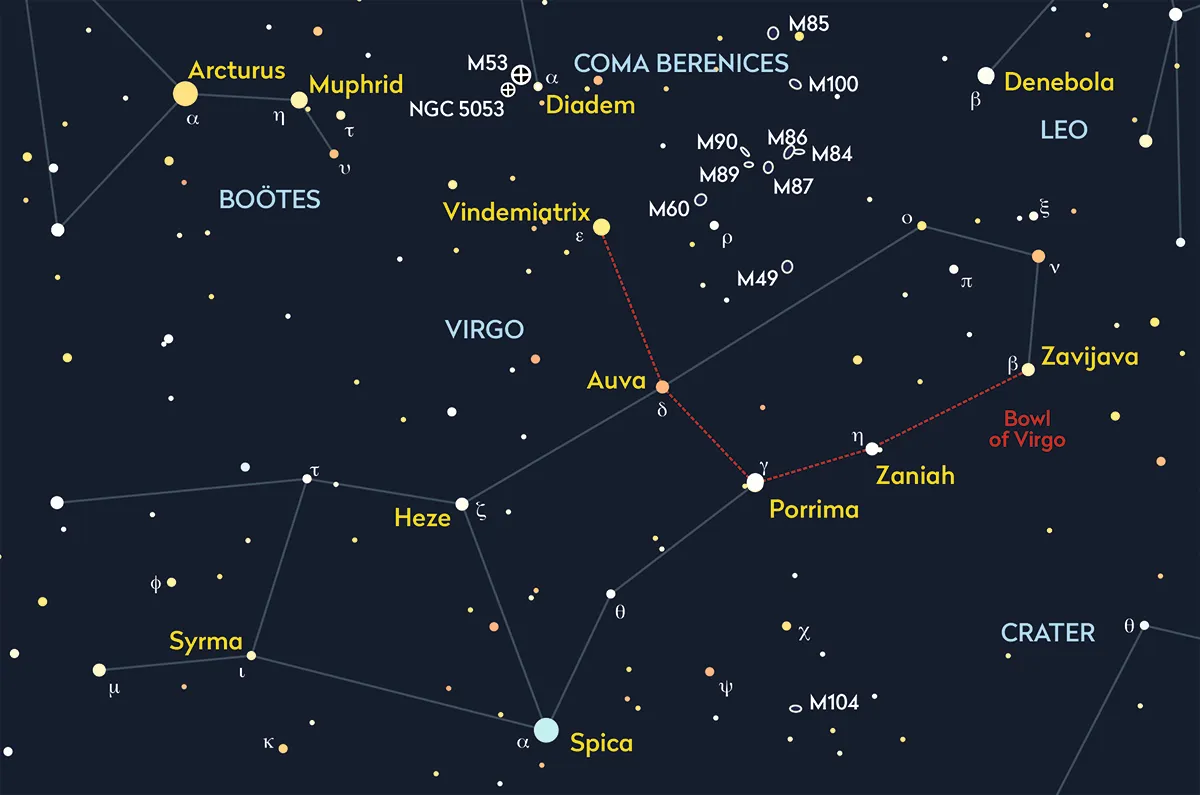
In the constellation of Virgo, the Virgin, we begin with M90 (mag. +9.5, 9’30” x 4’24”), an attractive intermediate inclination galaxy.
It has a bright, large core surrounded by a slightly dimmer, dusty central region set in a still dimmer disc that features prominent spiral arms.
Bear in mind, however, that from a city, even with a 300mm telescope M90 may be a disappointing compared to its neighbours.
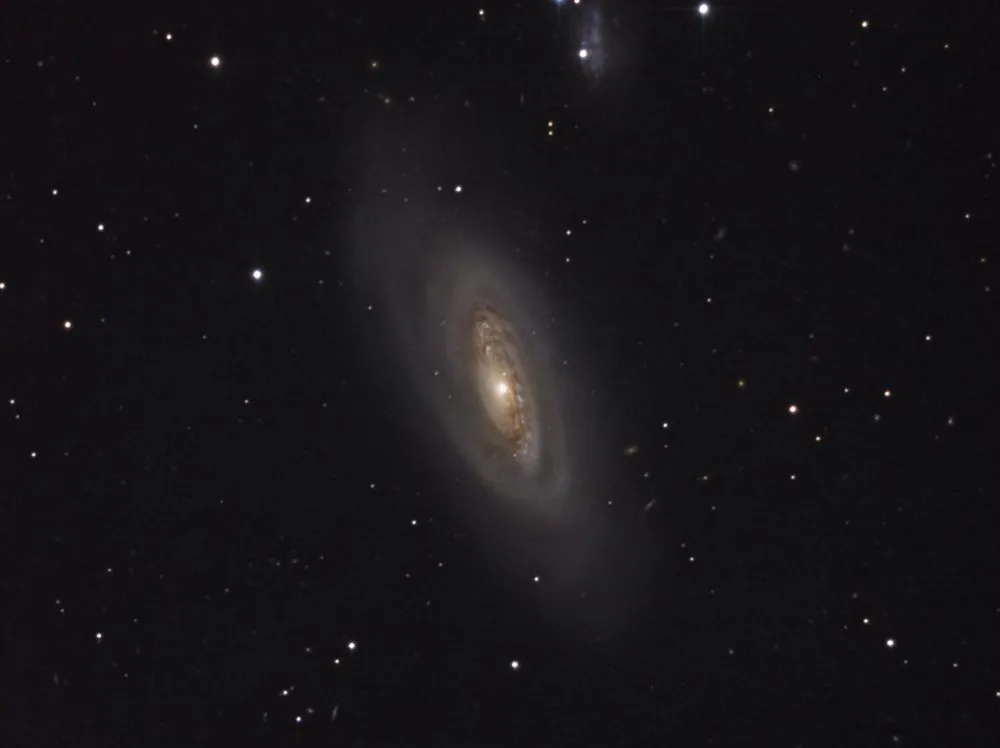
Not far from M90 is M89 (mag. +9.8, 5’6” across), which is a perfectly round elliptical.
In the city, with a 300mm telescope, the galaxy is bright with a star-like nucleus. In the suburbs, M89 is an easy catch for a 100mm refractor.
M84 (mag. +10.1, 6’30” x 5’36”) is a giant elliptical galaxy, without spiral arms or any visual details beyond a brighter central region.
Detail or not, in the eyepiece this galaxy is a wonder.
You’ll know that you’ve hit on M84 because of the presence of another, slightly dimmer, elliptical galaxy in the field, M86 (mag. +9.2, 8’54” x 5’48”).
This galaxy is only 17 arcminutes to the west, so it’s easy to fit the two into the field of an eyepiece with 150x magnification, which is a good power to use in Virgo if you’re observing from a city.
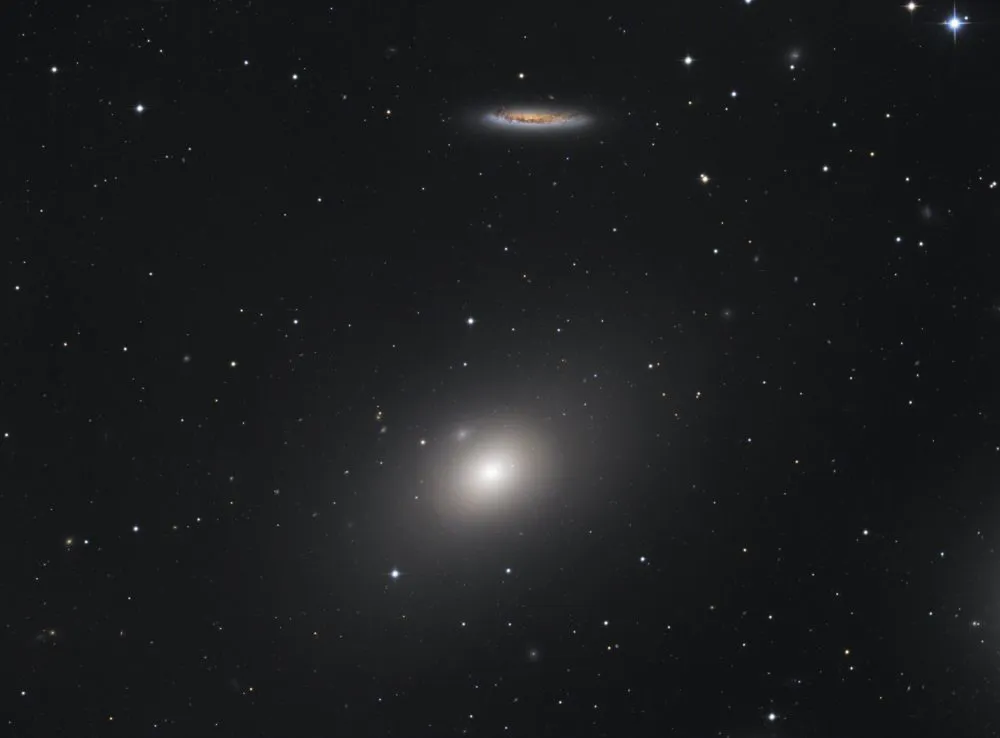
Looking at M86’s magnitude, you would expect it to be noticeably brighter than its companion.
However, it actually appears dimmer than M84, as it is more elongated (although it looks round, visually).
The easiest galaxy to see in the constellation of Virgo is probably M86, but it’s closely followed by the huge elliptical galaxy M87 (mag. +9.6, 7’12” x 6’48”).
‘Huge’ doesn’t even begin to describe this monster, which has a mass of over a trillion suns.
Despite its gigantic size, in reality it’s only a bit larger than M86 in the eyepiece. It has a brighter magnitude, but always looks dimmer.
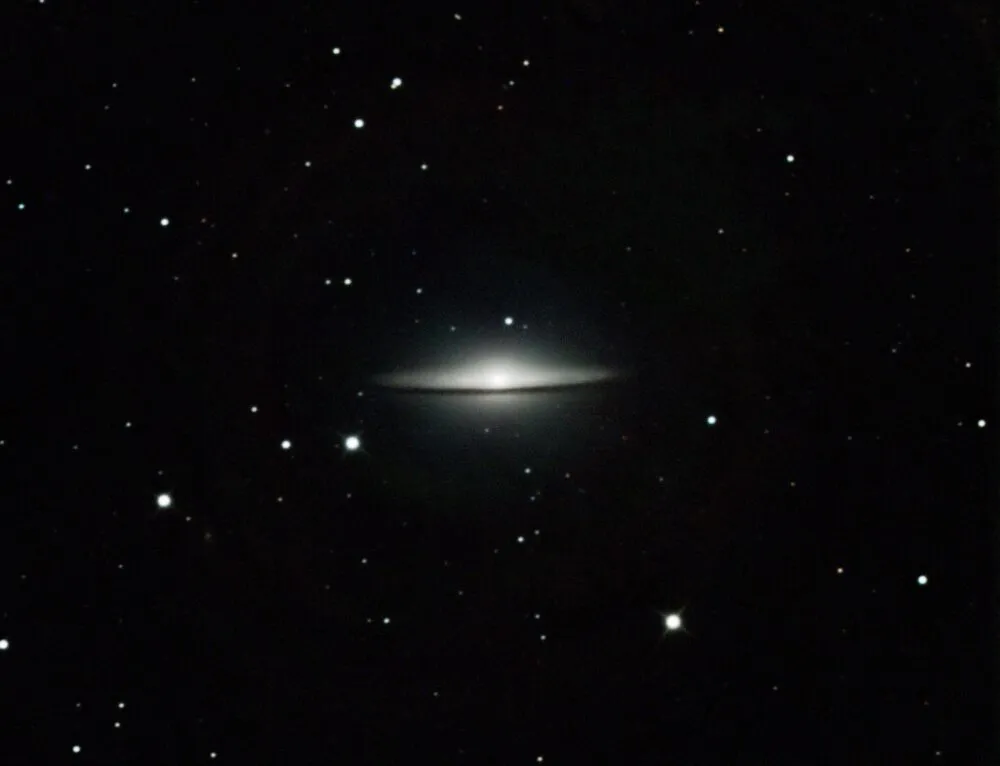
Finally, M104 (mag. +8.0, 8’42” x 3’30”) is the famous Sombrero Galaxy.
Located in the southeastern area of the constellation, it is away from the main body of the Virgo Cluster that lies between the ‘arms’ of the Maiden, within the arms of the ‘Y’ of Virgo’s stick figure.
In images, this edge-on galaxy features a prominent equatorial dust lane and a large central bulge that makes it look like a sombrero hat.
Summer constellations
Hercules, the hero
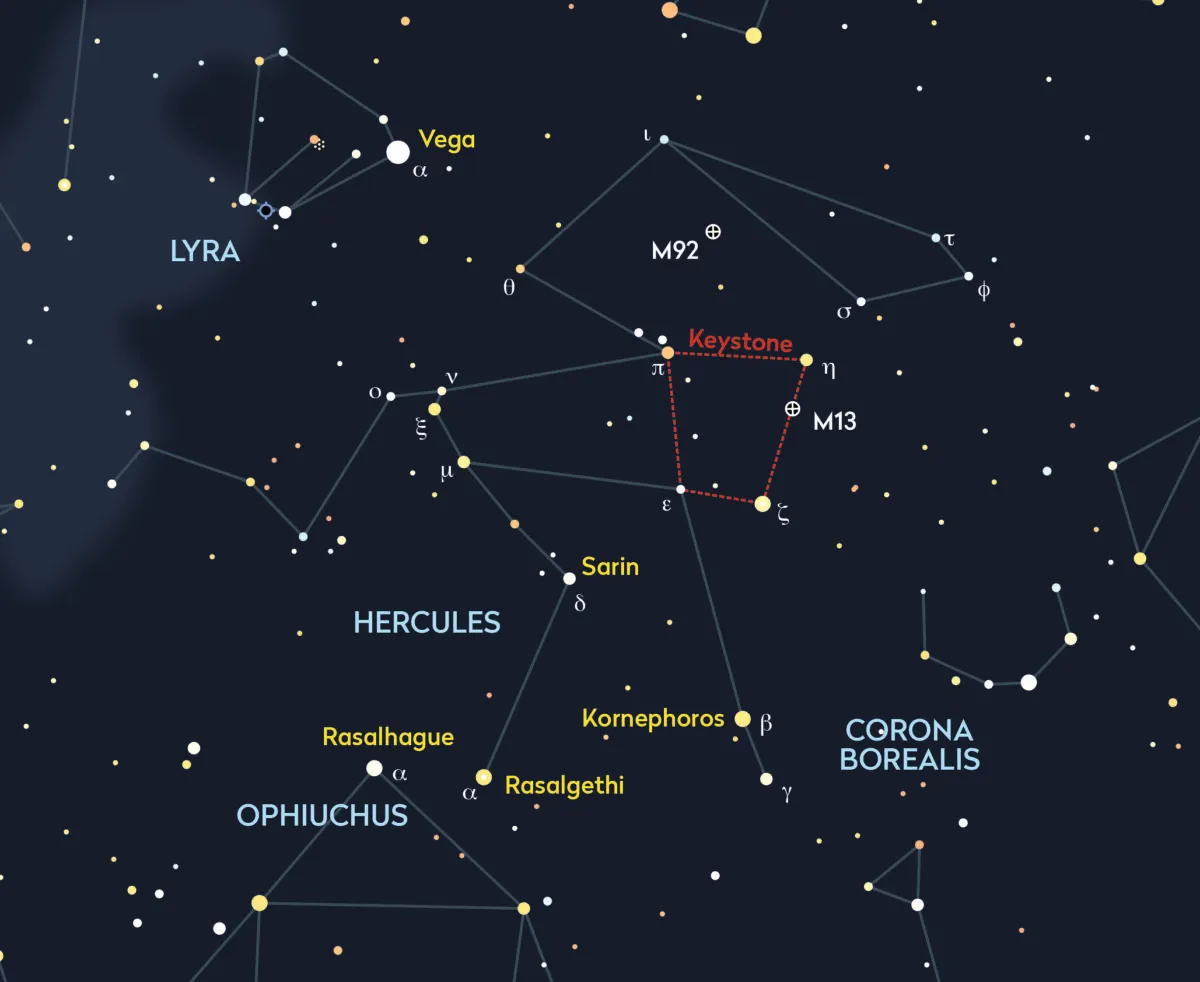
Hercules is awell-known home of stunning globular clusters.The constellation may be on the dim side, but its premier deep sky object, M13 (mag. +5.8, 20’ across) is not.
Even a beginner with a non-computerised telescope mount won’t have much trouble finding it, roughly midway between the line connecting the two westernmost stars of the Keystone – the lopsided square at the star-pattern’s heart.
But, while M13 is bright, it is also compact. A 200-250mm telescope turns this ‘smudge’ into a beautiful ball of stars in the brightest skies.
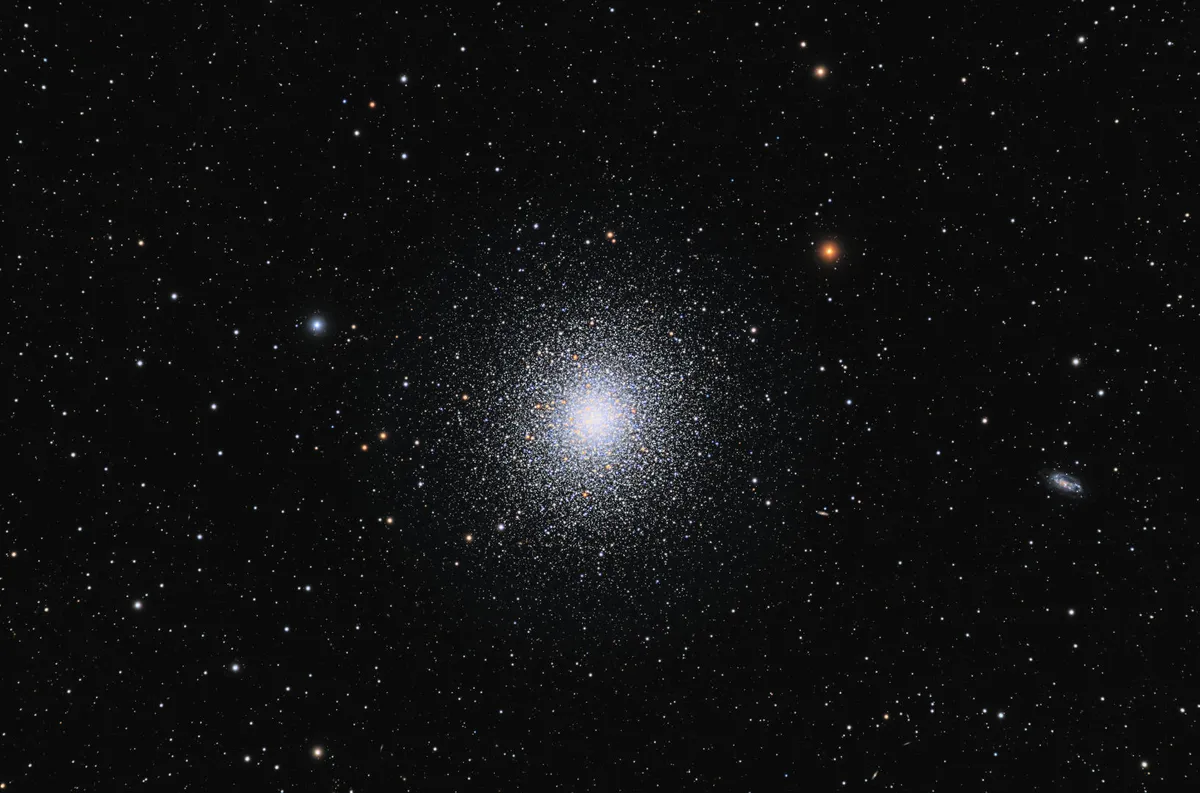
Another notable globular star cluster is M92 (mag. +6.4, 14’ across), which lies away from the Keystone in the northern part of the constellation.
While it is actually more tightly concentrated than M13, M92 seems easier to resolve – perhaps because the core isn’t as overwhelmingly bright as that of M13.
In a 130mm telescope from a suburban location, M92 can appear resolved almost to its centre on a dry summer’s evening when the air is steady.
For more advice, read our guide to the Hercules constellation
Lyra, the lyre
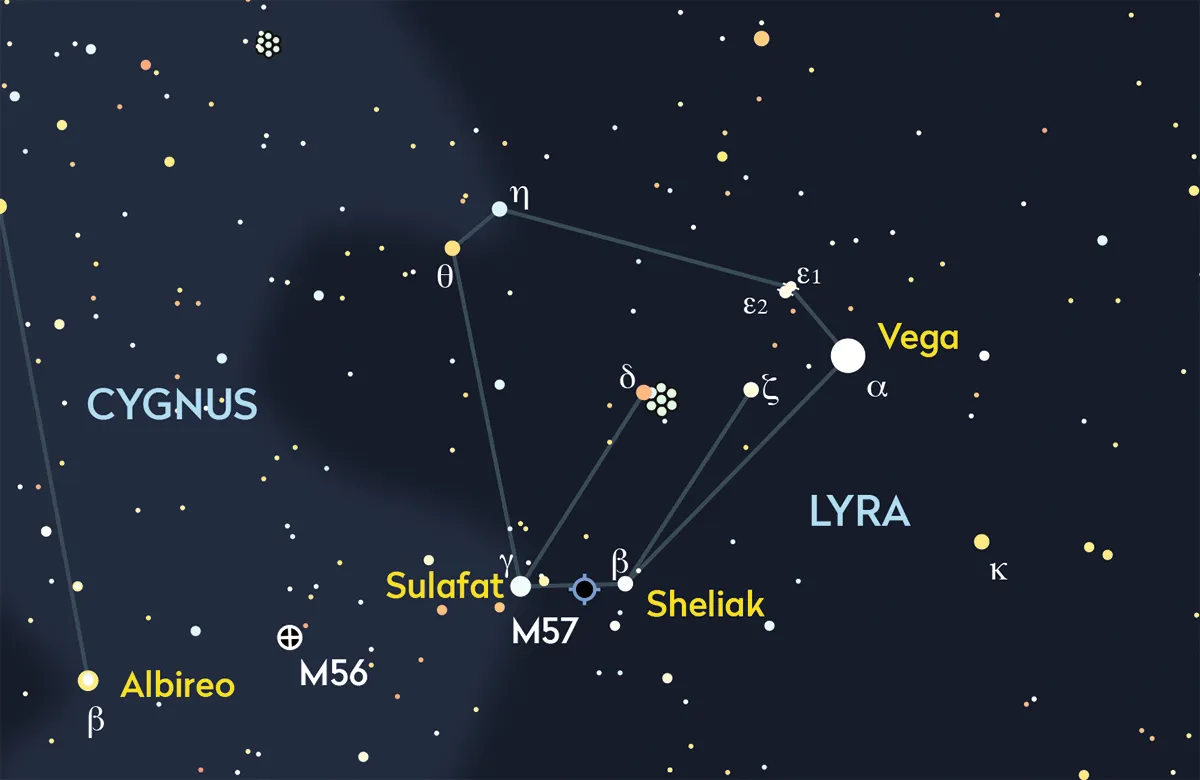
Even in the worst urban light pollution, M57 (mag. +8.8, 3’48”x2’24”), the famous Ring Nebula, is a good target for an 80-100mm telescope, but its shape only becomes evident with an aperture of 150mm or more.
A 250mm telescope shows brightness variations in its nebulosity and reveals a faint star embedded in the southwestern end of the ring’s disk.
The holy grail is M57’s central star, the white dwarf left over from the dead sun that created the nebula.
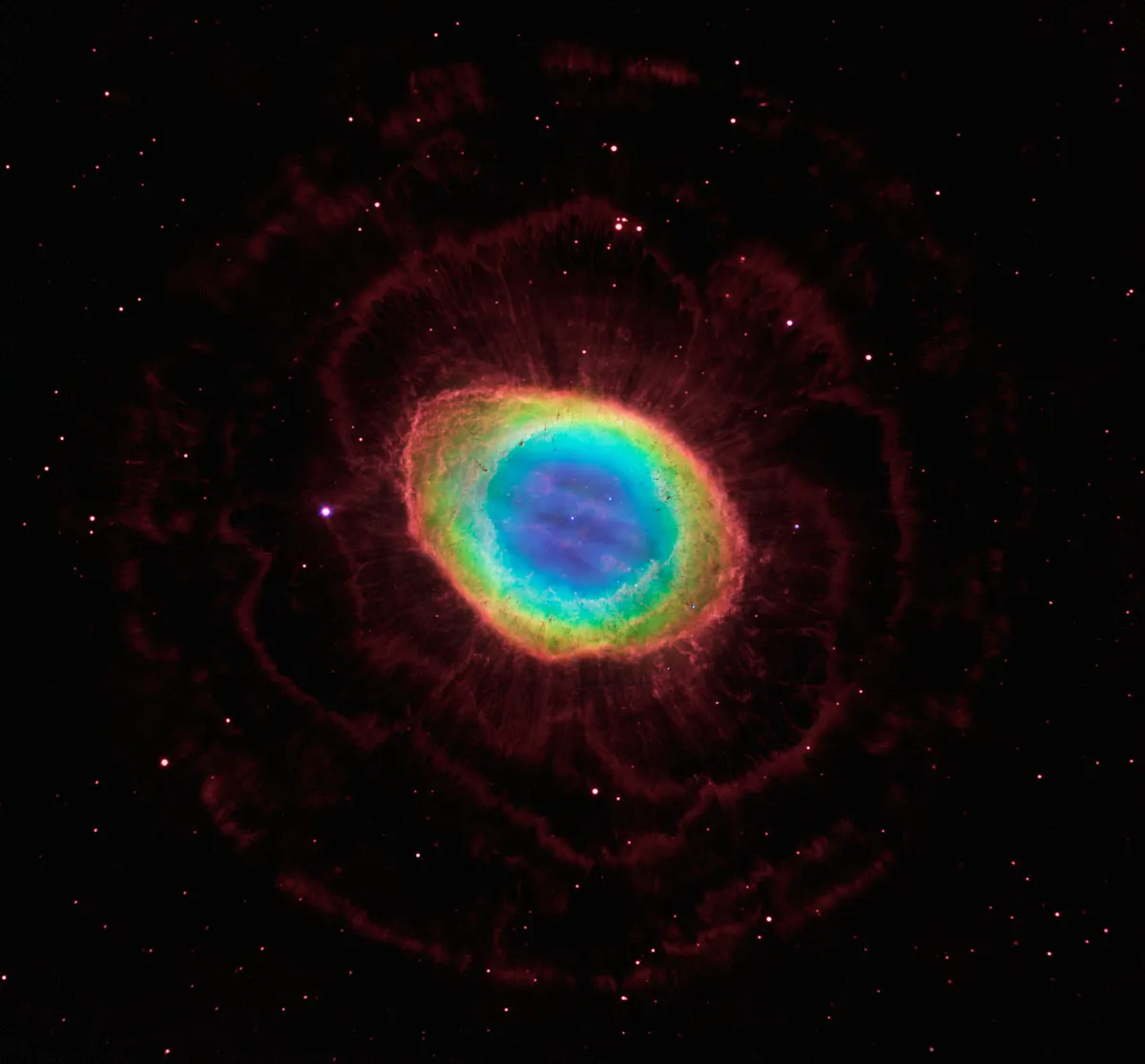
Globular cluster M56 (mag. +8.8, 8’48”), in the eastern part of Lyra near the border with Cygnus, is often overlooked.
Its small, dim stars are spread far apart, making it more like a rich but dim open cluster.
Lyra’s final urban wonder is not a deep sky object, but a multiple star, the famous Double-Double, Epsilon (ε) Lyrae, located 1°36’ northeast of Vega.
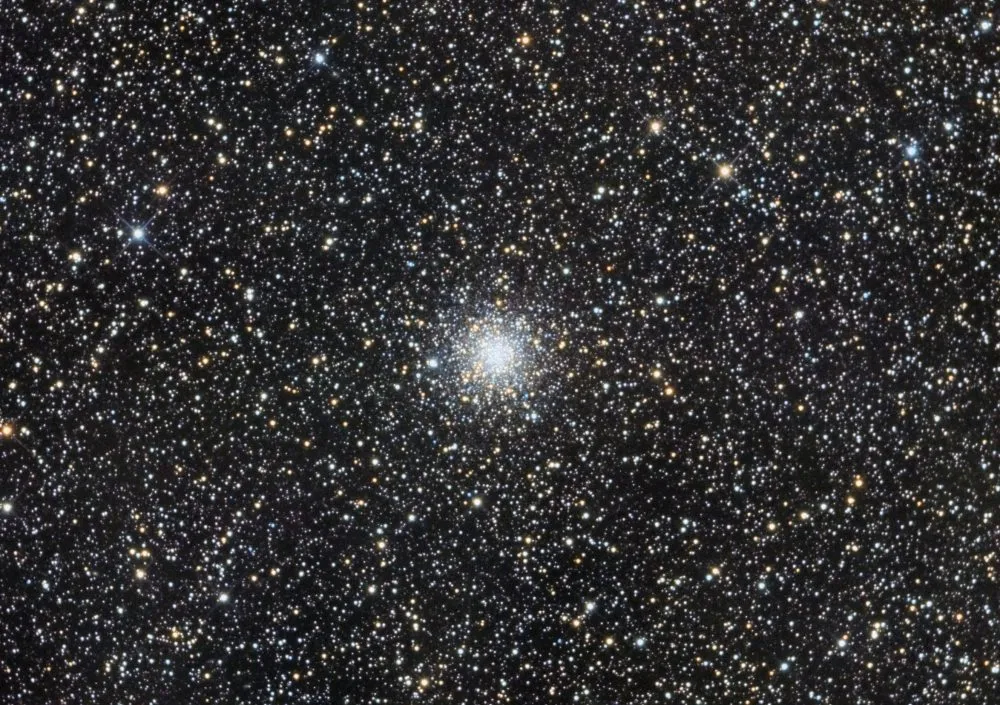
At low power an attractive double star is visible, two suns separated by a wide 208”.
Increase magnification to 200-250x, however, and both of the stars are revealed as doubles themselves.
The northernmost pair, ε1, is separated by 2.78”, while the stars of ε2 to the south are 2.4” apart.
Cygnus, the Swan
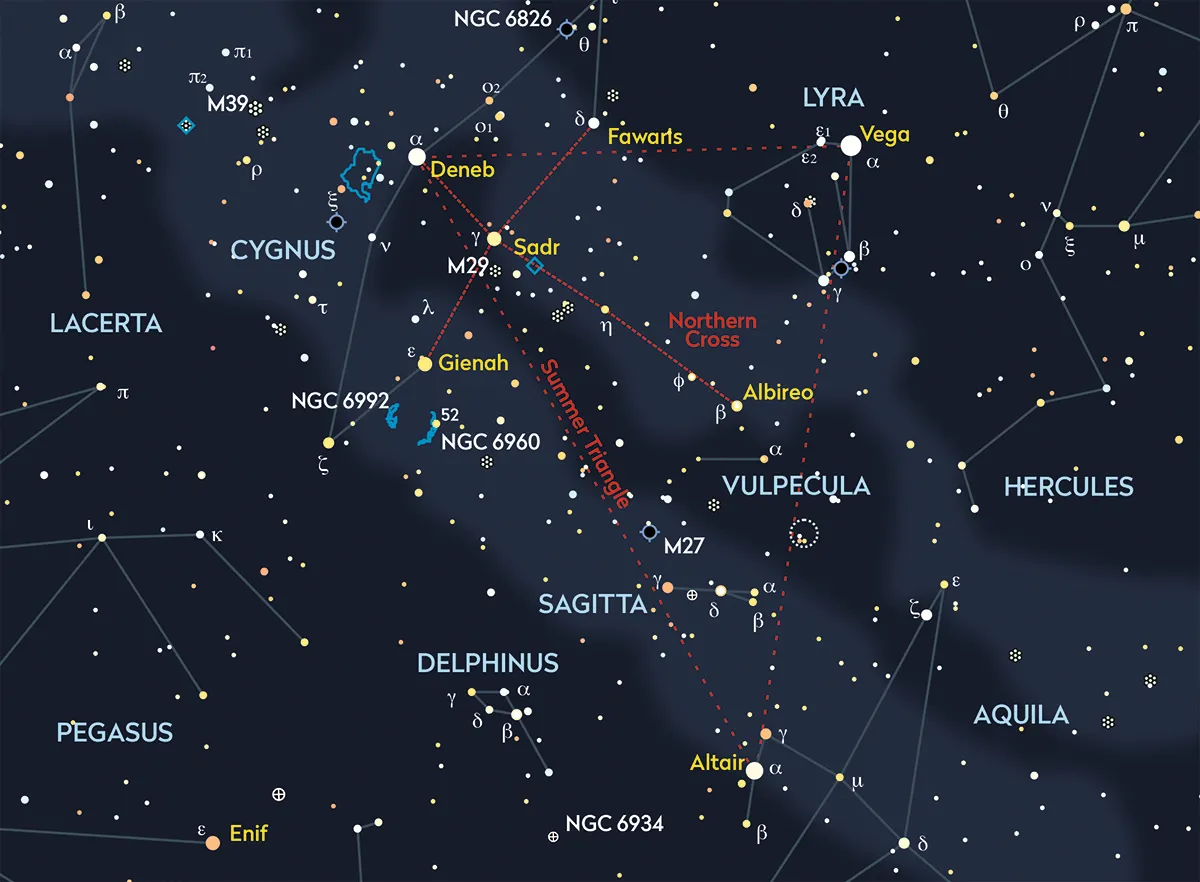
One of the best planetary nebulae, NGC 6826 (mag. +8.8, 8’24” across), the Blinking Planetary, is located not far from the tip of Cygnus’s western wing.
Even with a 100mm telescope, under light-polluted conditions it is impossible to see the round nebulae or its mag. +10 central star using direct vision.
But practice averted vision – looking off to the side rather than directly at it – and the round nebulosity around the star springs into view.
Alternate rapidly between direct and averted vision and the nebulosity blinks on and off.
Cygnus is home to two open star clusters. M29 (mag. +6.6, 10’ across) is located near the junction of Cygnus’ wings and body.
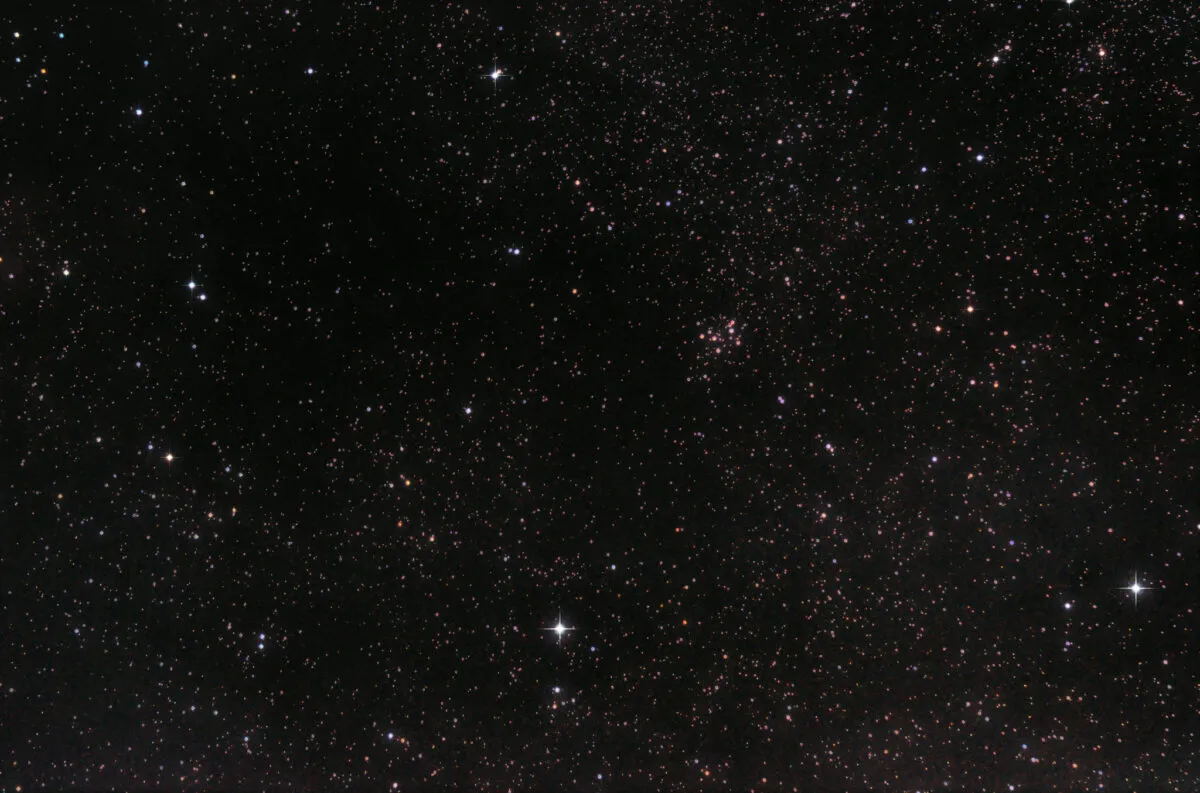
North of M29 by 14°50’, and well away from the body of the Swan, is M39 (mag. +4.6, 31’ across).
The legendary Veil Nebula (NGC 6992/6960) is two separate arcs of nebulosity, only visible with an OIII filter.
The first of the Veil’s two nebulous arcs, NGC 6960, often referred to as the Witch’s Broom Nebula, is easy to locate without a computer since this 3°30’ x 2°40’ streak of gas passes through a bright, mag. +4.2 star 52 Cygni.
Although the given magnitude for the Witch’s Broom is +7.0, its large size means its surface brightness is extremely low.
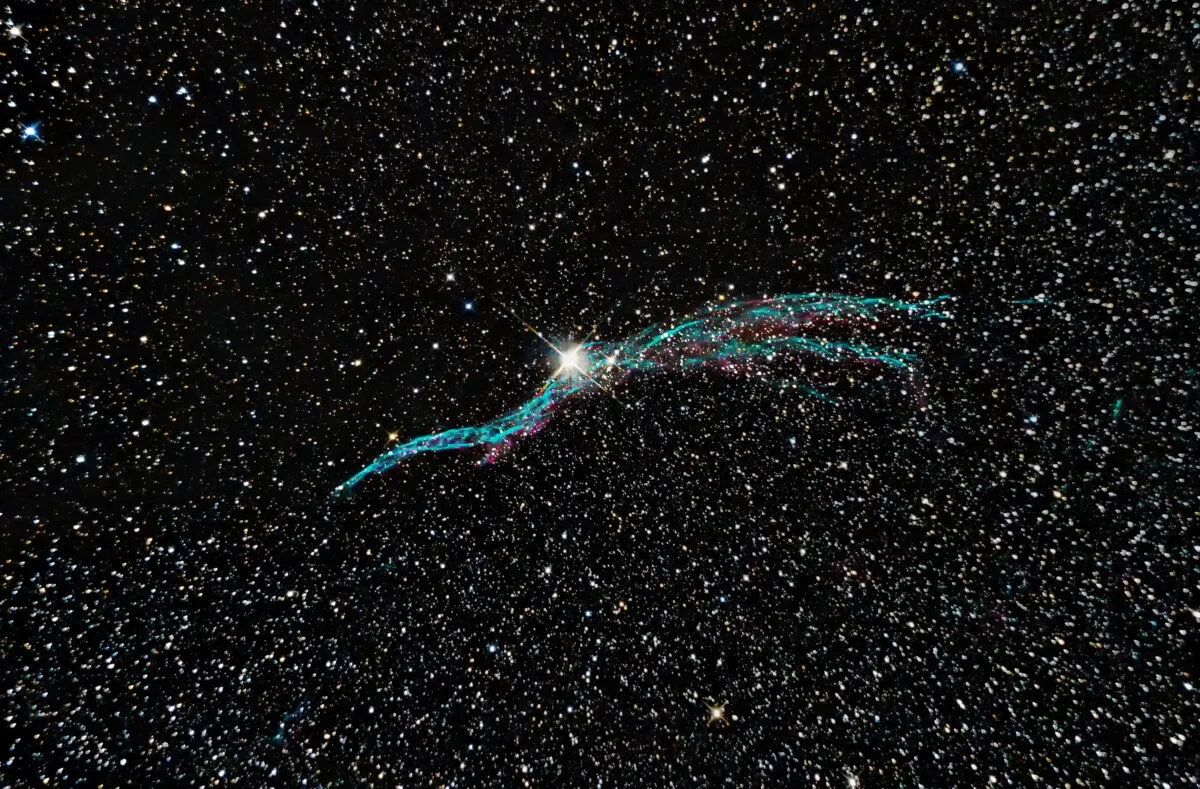
The other main component of the Veil, NGC 6992, forms a 3°50’ x 2°40’ arc, 2°30’ northeast of the Witch’s Broom.
This half of the Veil is referred to as the Bridal Veil Nebula thanks to its intricate, lacy structure. On a good night it can begin to give up significant detail to telescopes with an aperture of 250mm or more.
For more advice, read our guide to the constellation Cygnus
Vulpecula
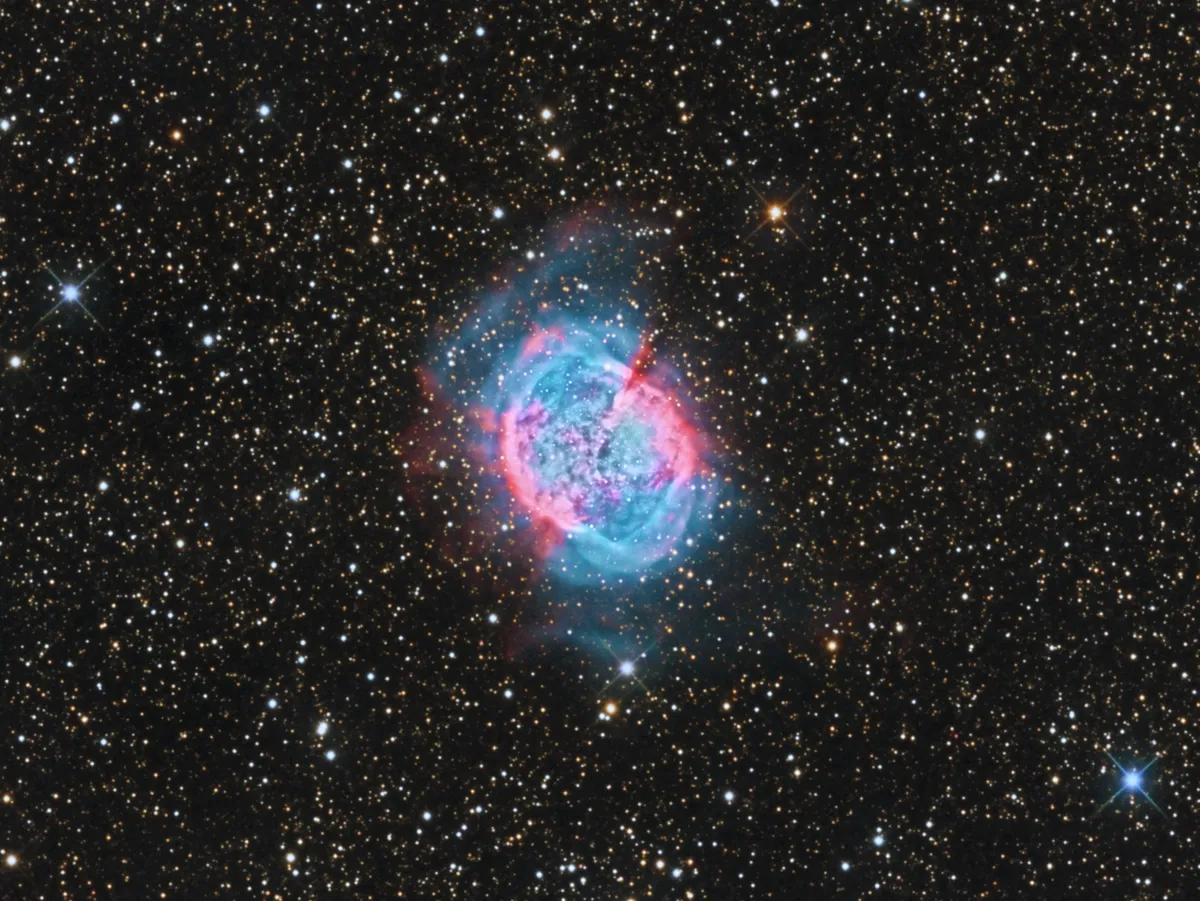
Vulpecula, the Little Fox, is unimpressive, but it is home to M27 (mag. +7.4, 8’ x 5’36”), the Dumbbell Nebula.
Not only is M27 bright and bold, it is large for a planetary nebula, making it one of the best for Northern Hemisphere observers.
Lower magnifications reveal substantial detail and make the Dumbbell a great target for smaller telescopes.
Delphinus, the dolphin
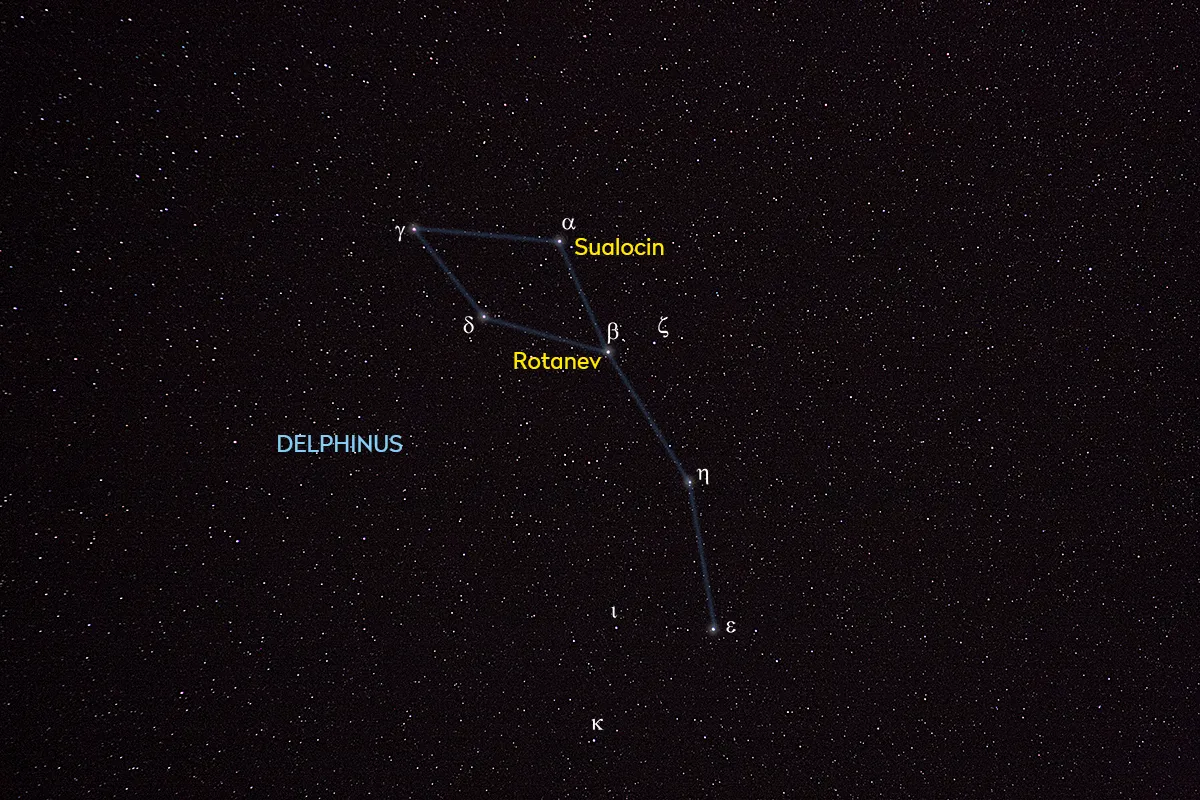
The main object of interest in the small constellation Delphinus, the Dolphin, is a globular cluster, NGC 6934 (mag. +8.8, 8’24” across).
Even with a 300mm telescope, it appears as an unresolved fuzzball, but it is set in a field rich with stars.
In the suburbs, a magnification of 187x begins to resolve individual stars around the periphery of the cluster.
Also take a look at Gamma Delphini, the dolphin's nose-tip, which seems to change colour depending on how you observe it.
For more advice, read our guide to the constellation Delphinus
Ophiuchus, the serpent bearer
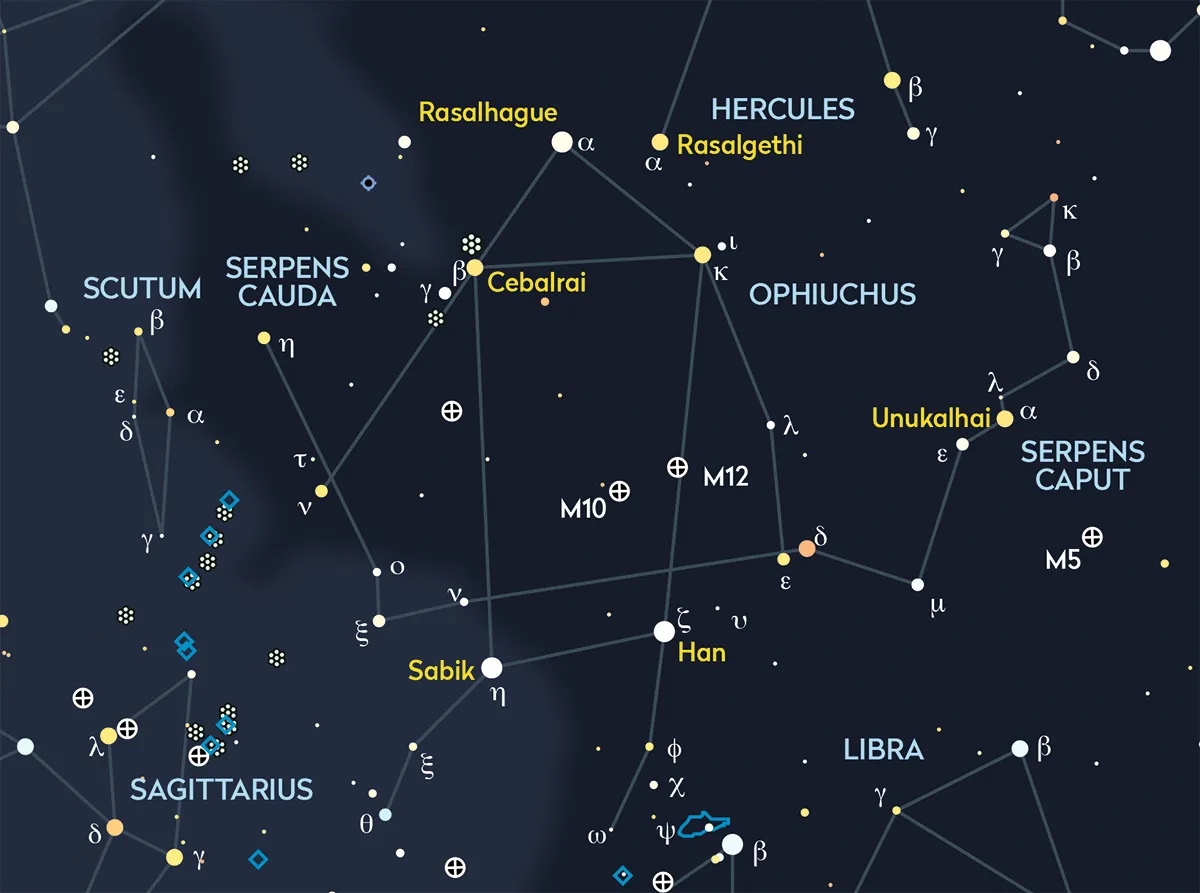
Once thought to resemble Asclepius the physician, Ophiuchus looks like a lopsided house drawn by a child. Nevertheless, there are wonders aplenty here.
Ophiuchus’s main attractions are globular clusters, beginning with the famed Twin Globs.
M10 (mag. +6.4, 20’ across) is a treat. With a 280mm telescope, it is resolved to its core and shows hordes of tiny stars.
M12 (mag. +7.6, 16’ across), which lies northwest of M10, is bright and compact, but fewer stars and a looser structure make it appear dimmer than the magnitude figure suggests.
For more advice, read our guide to the constellation Ophiuchus and the star Sabik.
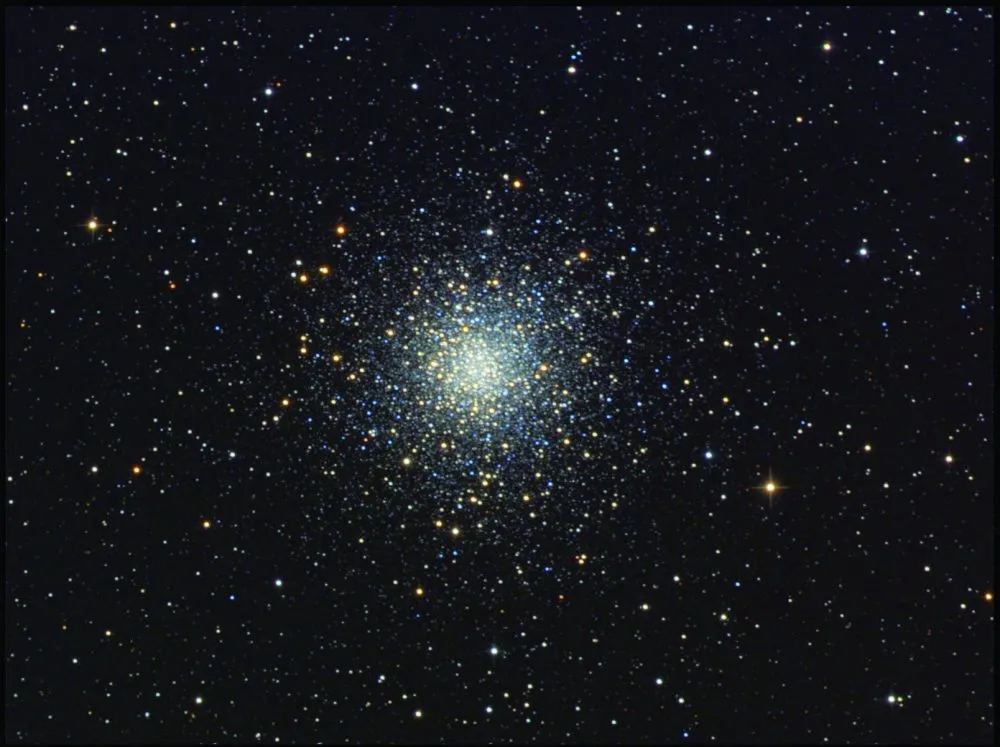
Serpens
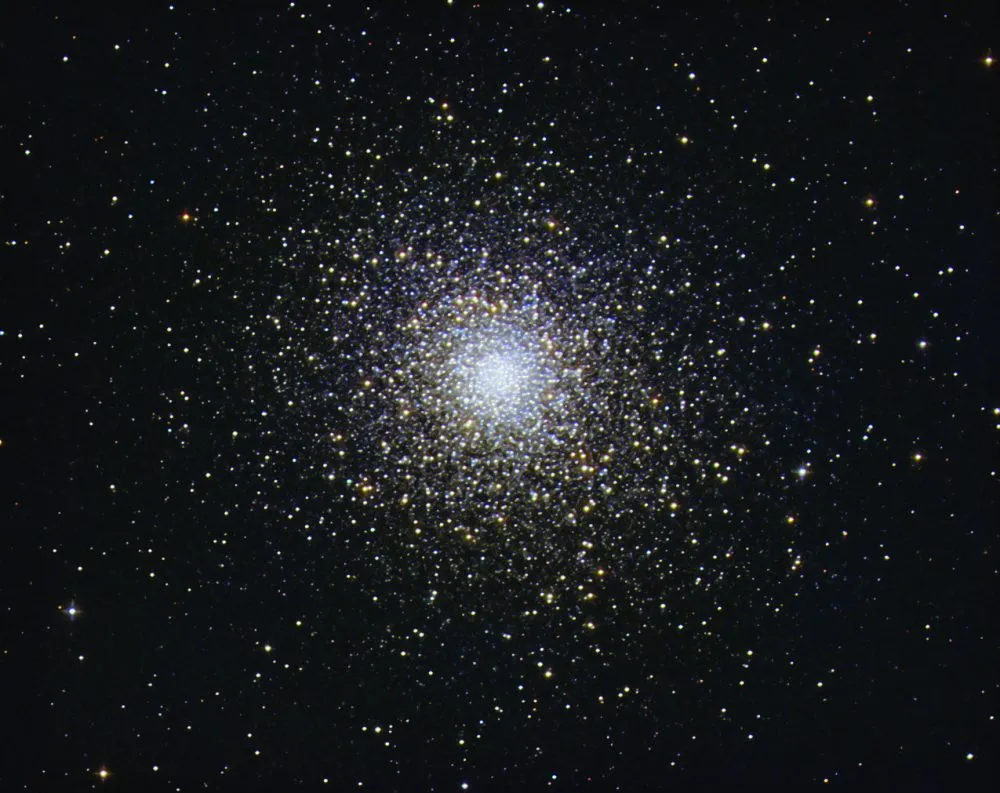
Serpens is actually two constellations, Serpens Caput (the head) and Serpens Cauda (the tail).
While the tail is far to the south and doesn’t hold much of interest, the head is a different story, containing one of the best globulars visible from northern latitudes: M5 (mag. +6.6 and 23’ across).
M5’s statistics alone hint at what a spectacle it is.
While it is slightly dimmer than M13 and its concentration is about the same, M5 is easier to resolve in any telescope, and is just visible with the naked eye under perfect conditions.
Scutum
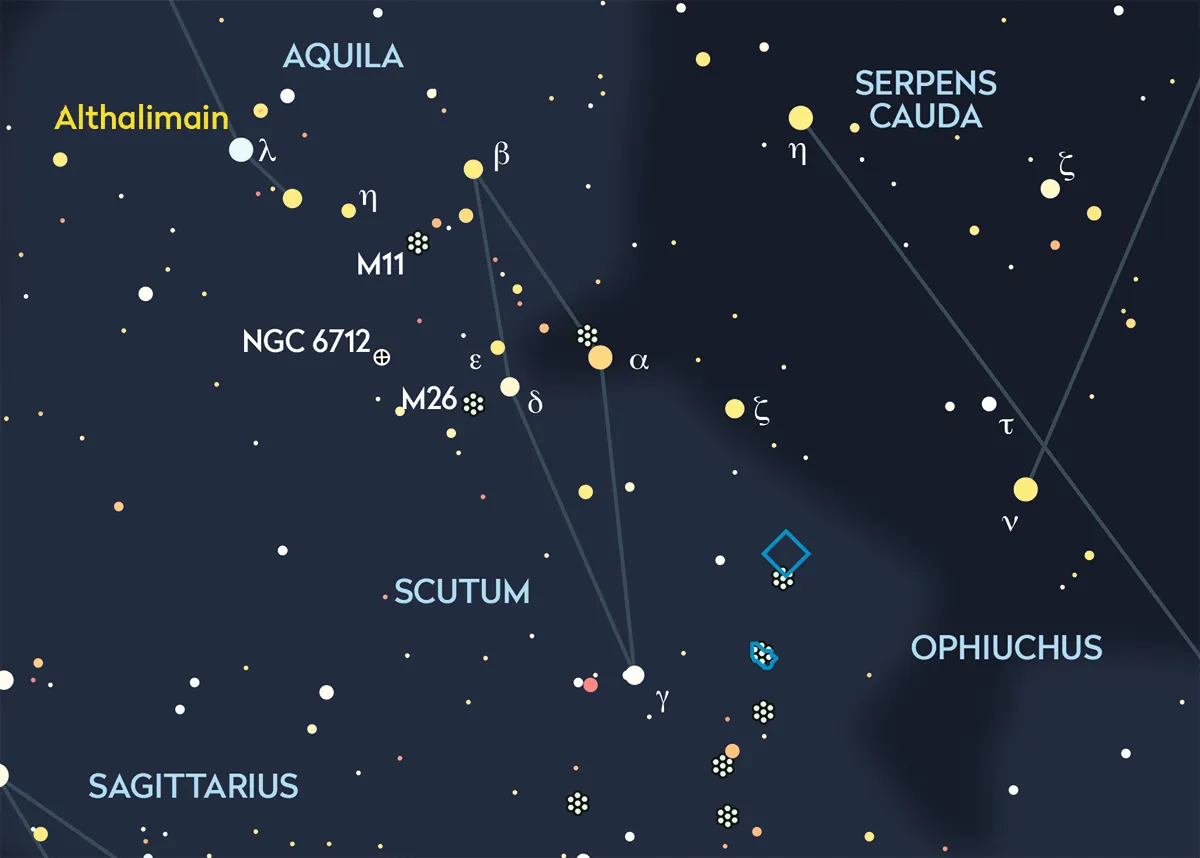
M11 (mag. +6.3, 14’ across), the Wild Duck Cluster, is a bright open star cluster.
As its surface brightness is high, it is easy to make out with a 75mm telescope under poor city skies.
Indeed, enough stars should be visible to make clear why this object is the Wild Duck – triangular in shape, suggesting a flight of ducks.
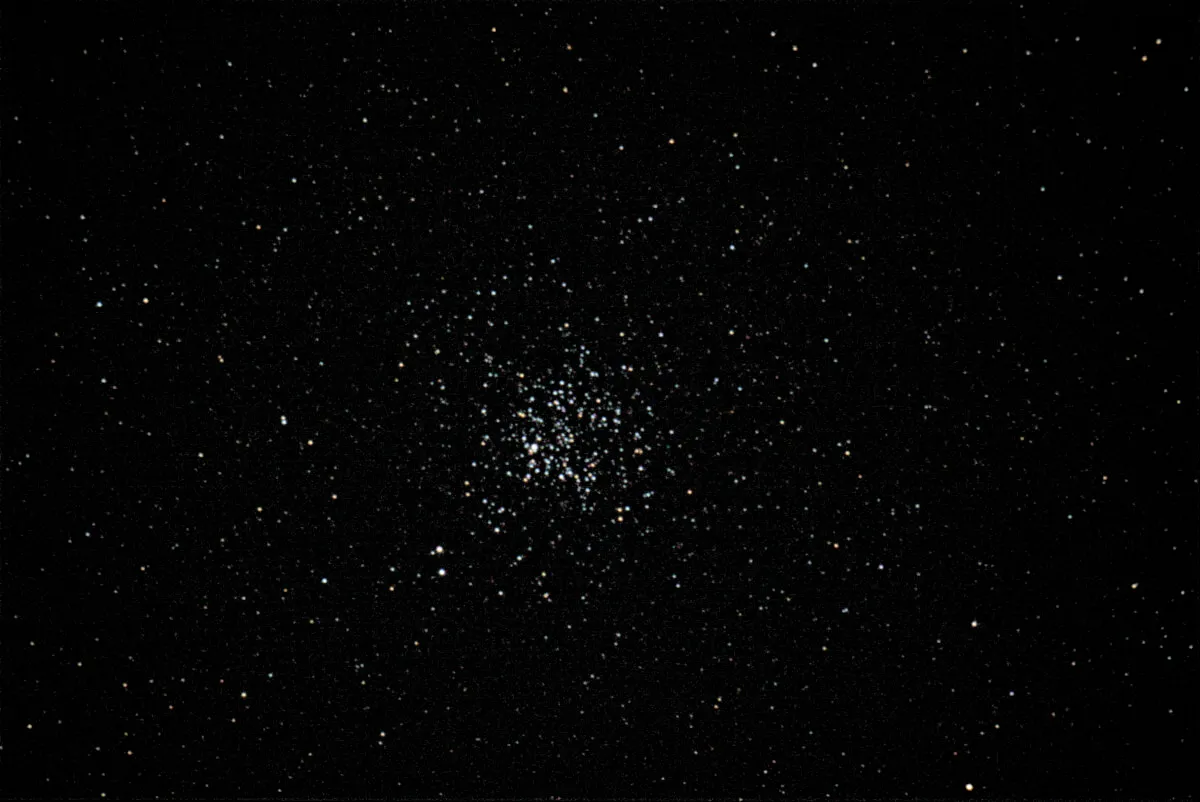
Scutum’s other Messier open cluster is M26 (mag. +8, 10’ across), a group of stars whose magnitude and size make it sound like a good catch.
However, it turns out to be a major disappointment. A 150mm telescope shows a scattering of at most 10 faint stars and one slightly brighter sun.
Globular cluster NGC 6712 (mag. +8.7, 2’30” across), just to the east of Scutum’s stick figure, isn’t anything special in itself, but the field it is set in is incredibly rich – packed with stars, it is almost difficult to tell where the outer stars of the cluster stop and background stars begin.
NGC 6712 is visible in the city, and a 300mm telescope may resolve some stars, but its beauty is reduced since the field is no longer as rich with suns as it is from darker skies.
Sagittarius, the archer
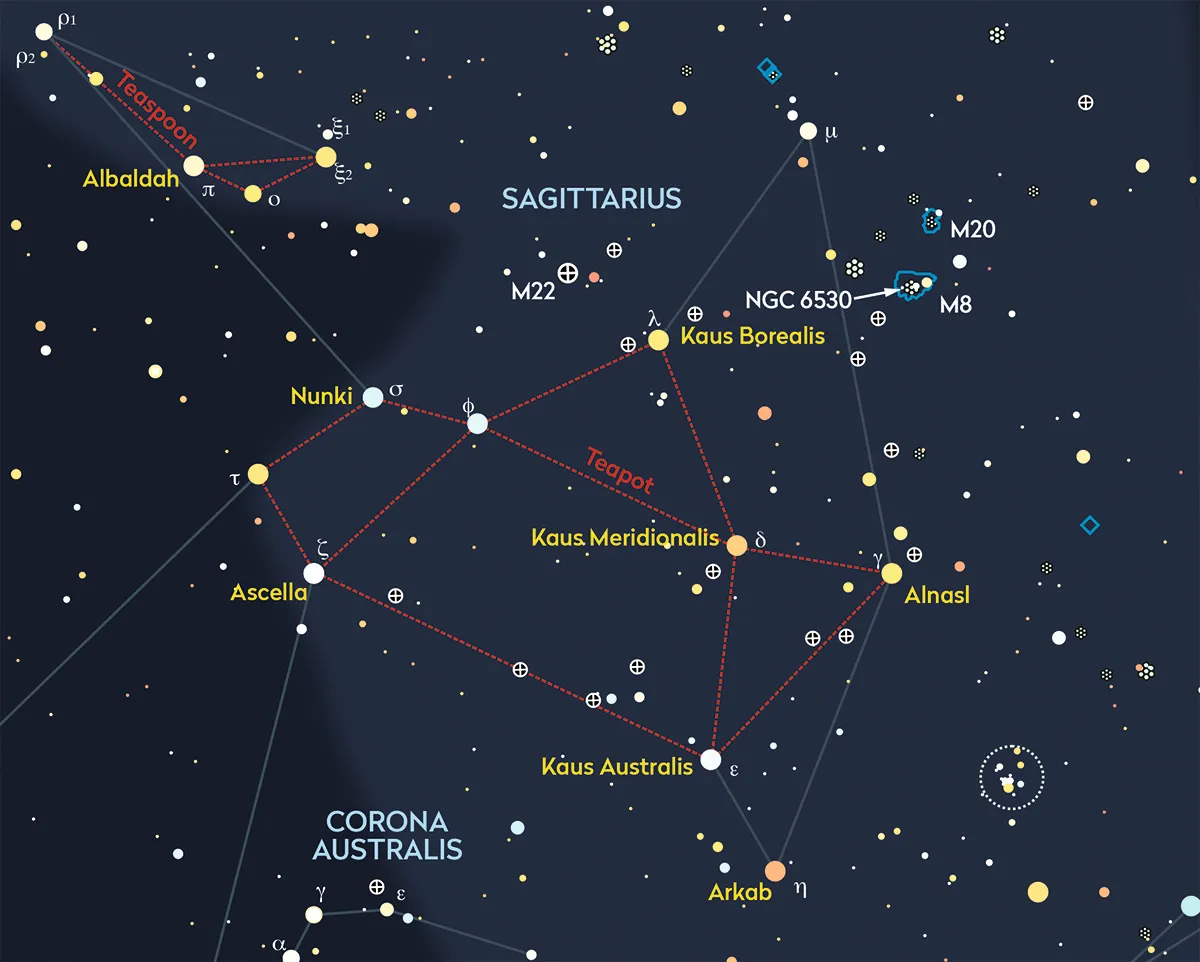
While the constellation doesn’t look anything like the centaur archer of mythology – it looks more like a teapot with a perfect lid and spout –it is home to some bright, legendary objects.
M22 (mag. +5.1, 32’ across), the Great Globular in Sagittarius, is an example of an object that makes a visit to the south of England worthwhile.
Its highest altitude from the latitude of London is less than 15°, but it is large and easily visible in smaller telescopes.
With a 280mm telescope its oval shape becomes evident and its loose central core becomes visible.
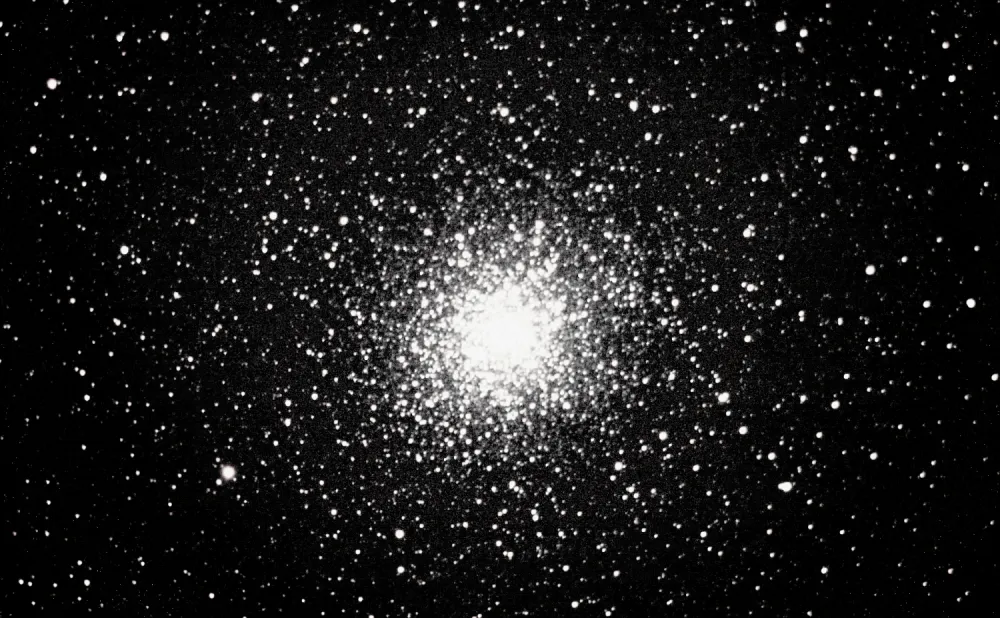
Elsewhere, the star cluster NGC 6530 is loose but attractive, and is composed of about a dozen bright stars.
It appears to be embedded in the nebulosity of M8, the Lagoon Nebula, but is thought to actually be a foreground object.
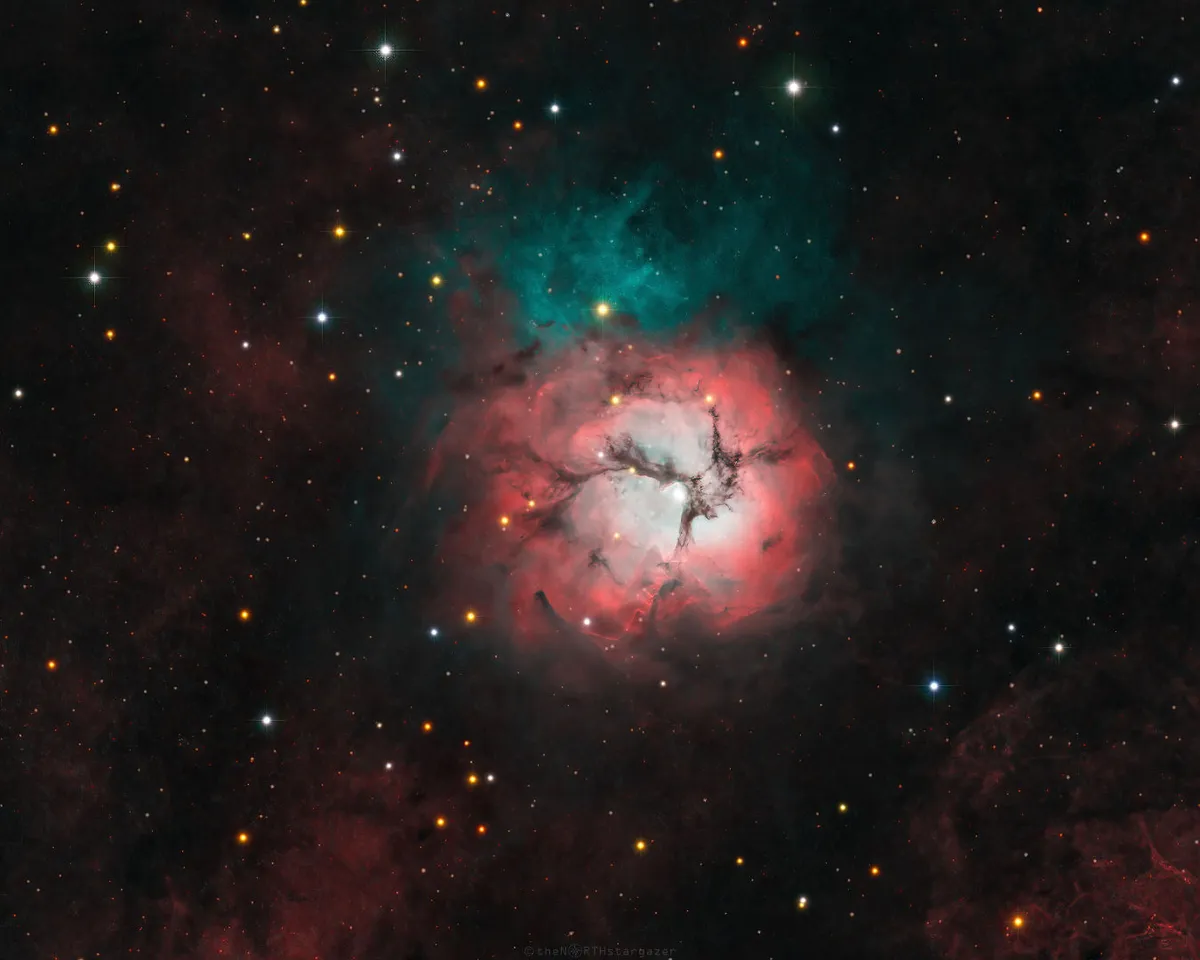
Sagittarius’s other famous nebula, M20 (mag. +6.6, 30’ across), the Trifid Nebula, is badly hurt by its low altitude.
Despite having a fairly high magnitude and being reasonably large, its faintness is due to the fact that some of the Trifid is reflection nebulosity, which is more difficult to see than emission nebulosity from light-polluted areas.
For more advice, read our guide to the constellation Sagittarius
Autumn constellations
Pegasus, the flying horse
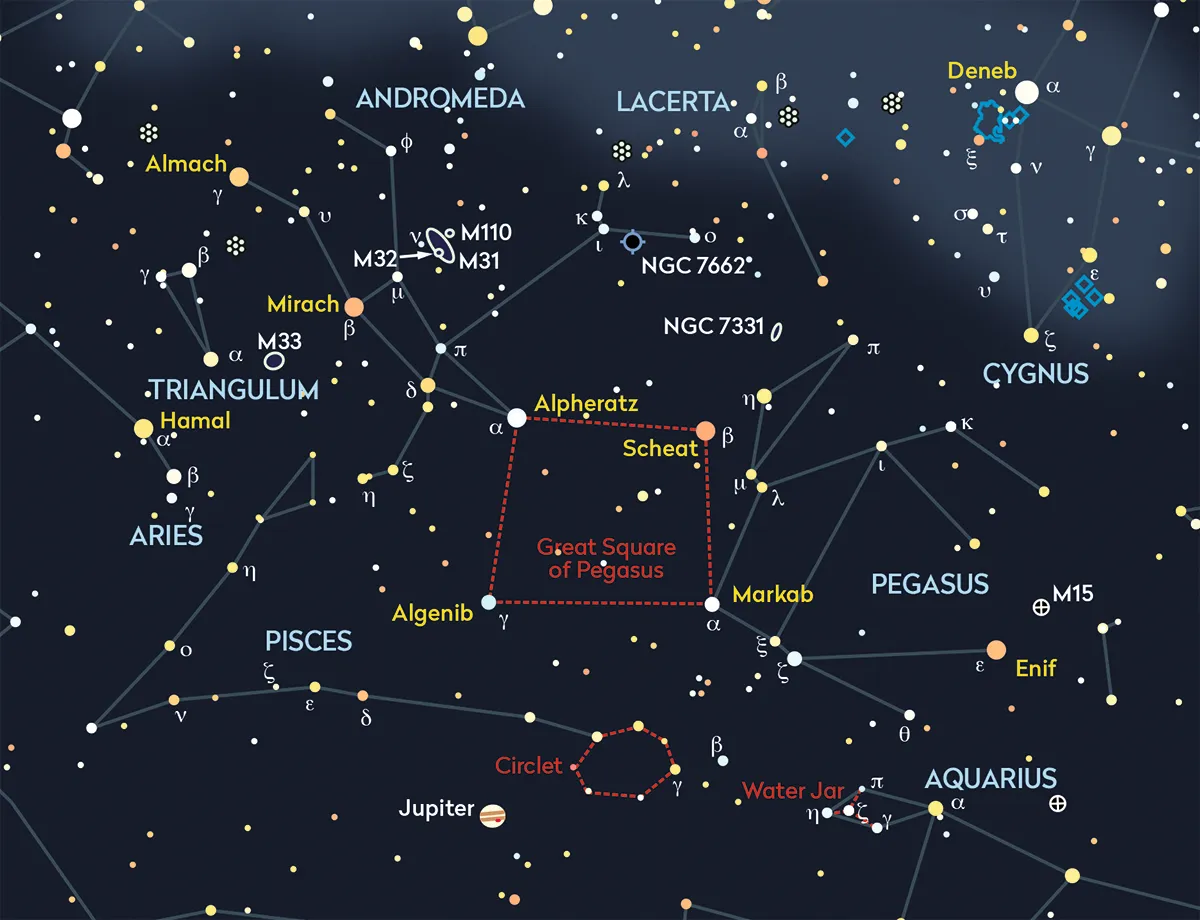
Pegasus’s Great Square – three bright stars in Pegasus, one in Andromeda – is easy to spot.
Extending from the Square’s southwest corner is a line of stars that represents the Horse’s neck and head, terminating in brilliant mag. +2.3 Enif (Epsilon (ε) Pegasi), Pegasus’s nose.
Just 4˚ northwest of this is target number one, globular star cluster M15 (mag. +6.3, 18’ across).
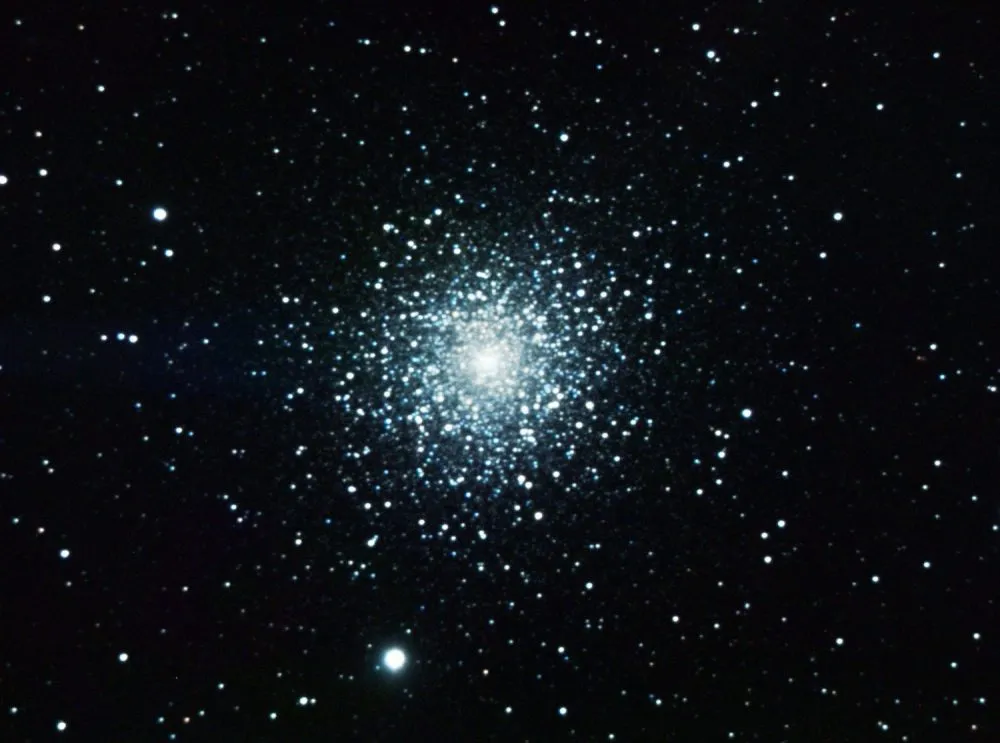
Although it’s easy to see, resolving its stars is difficult for smaller instruments.
In the city, what is visible depends on your telescope’s aperture: the larger the better.
The most impressive thing about M15 is its bright core.
Most groups of galaxies in Pegasus are faint, but spiral galaxy NGC 7331 (mag. +9.48, 10’10” x 3’42”) can be seen by urban astronomers.
Andromeda, the maiden

M31 (mag. +3.4, 3°9’ x 1°1’) is so bright it can be seen with the naked eye, even in the city.
Located 7˚30’ northwest of mag. +2.0 star Mirach (Beta (β) Andromedae), M31 is so large you’ll need binoculars or the widest field telescope.
In the suburbs, it’s possible to glimpse its spiral structure.
A 12-inch or larger reflector reveals a bright star cloud near its southwestern tip: NGC 206, an oval, 3’-long brightening of the galaxy’s nebulosity.
In suburban skies, 8-to 12-inch telescopes reveal one of M31’s many globular star clusters, mag. +13.8 G1, also known as Mayall 1.
Like the Milky Way, M31 has a number of smaller galaxies orbiting it.
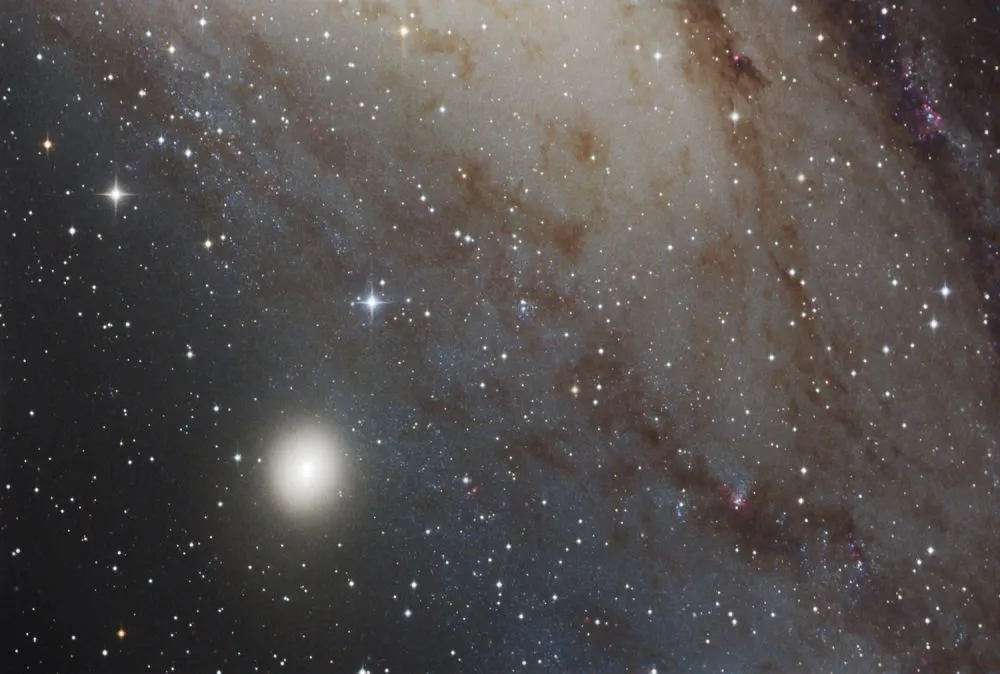
The brightest, M32 (mag. +8.0, 8’30” x 6’30”), lies 24’ south of its big sibling. It’s easy to see in 3-inch refractors in the city and in 50mm binoculars from darker sites.
M31’s other bright companion, M110 (mag. +8.0, 21’54” x 11’), is difficult to see with reflectors of 4-inch aperture, but easier to view with a 6-inch.
Finally, the outstanding planetary nebula NGC 7662 (mag. +8.3, 20” x 15”) is easy to see from the city, even in 3-inch refractors, if you use 200–300x magnification.
Triangulum, the triangle
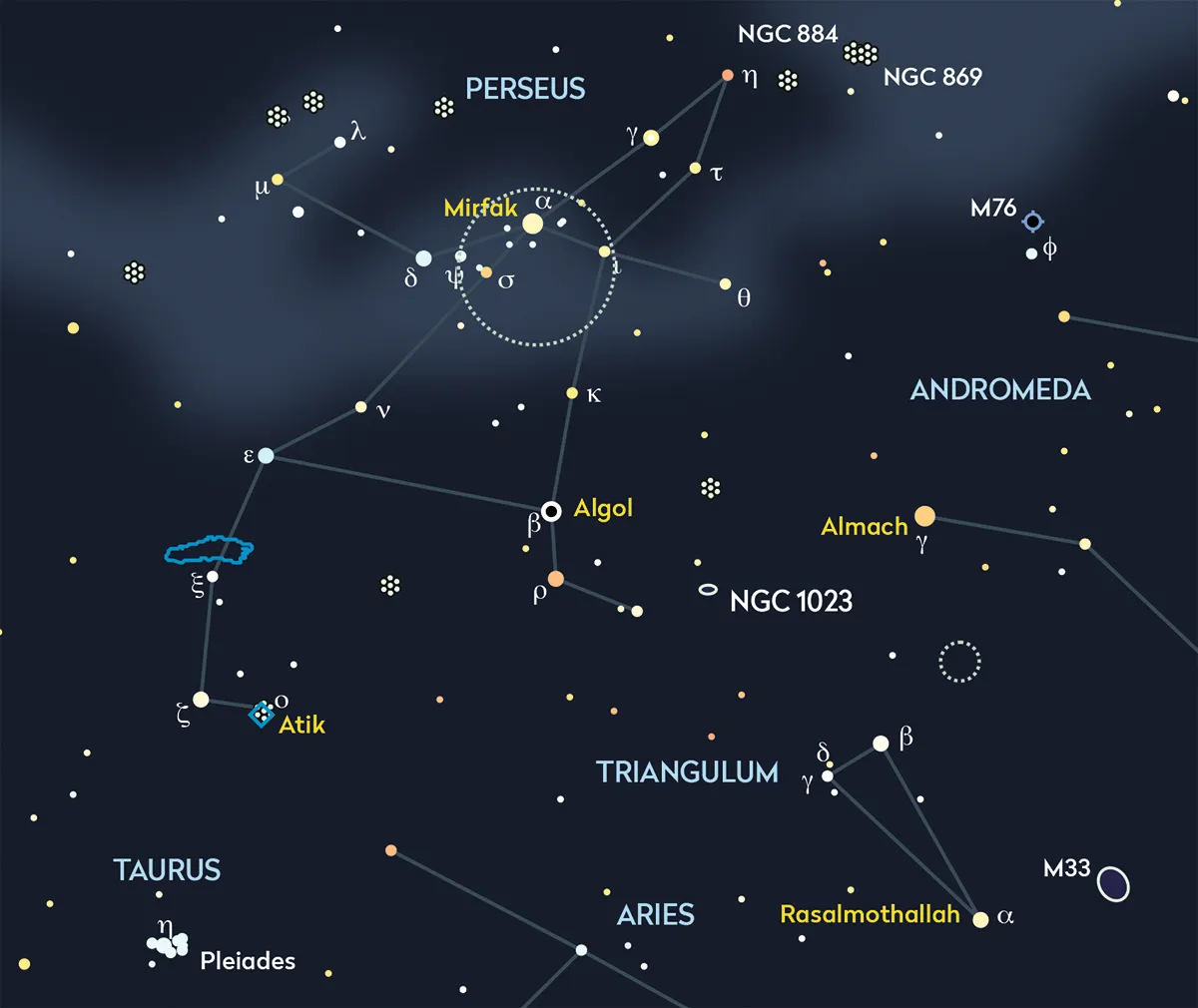
While its stick figure – a triangle of 3rd and 4th magnitude stars – doesn’t stand out, Triangulum should be visible in most urban skies if you know where to look and you’ve allowed it to climb high in the sky.
That’s more than can be said for the much larger constellation it lies next to, Pisces, the Fishes.
An attractive constellation from darker skies, Pisces’s member stars are mostly faint, near mag. +5.0, and thus the Fishes suffers in city skies and may be completely invisible.
The deep-sky objects it does contain are equally faint and difficult to realise from the city and suburbs.
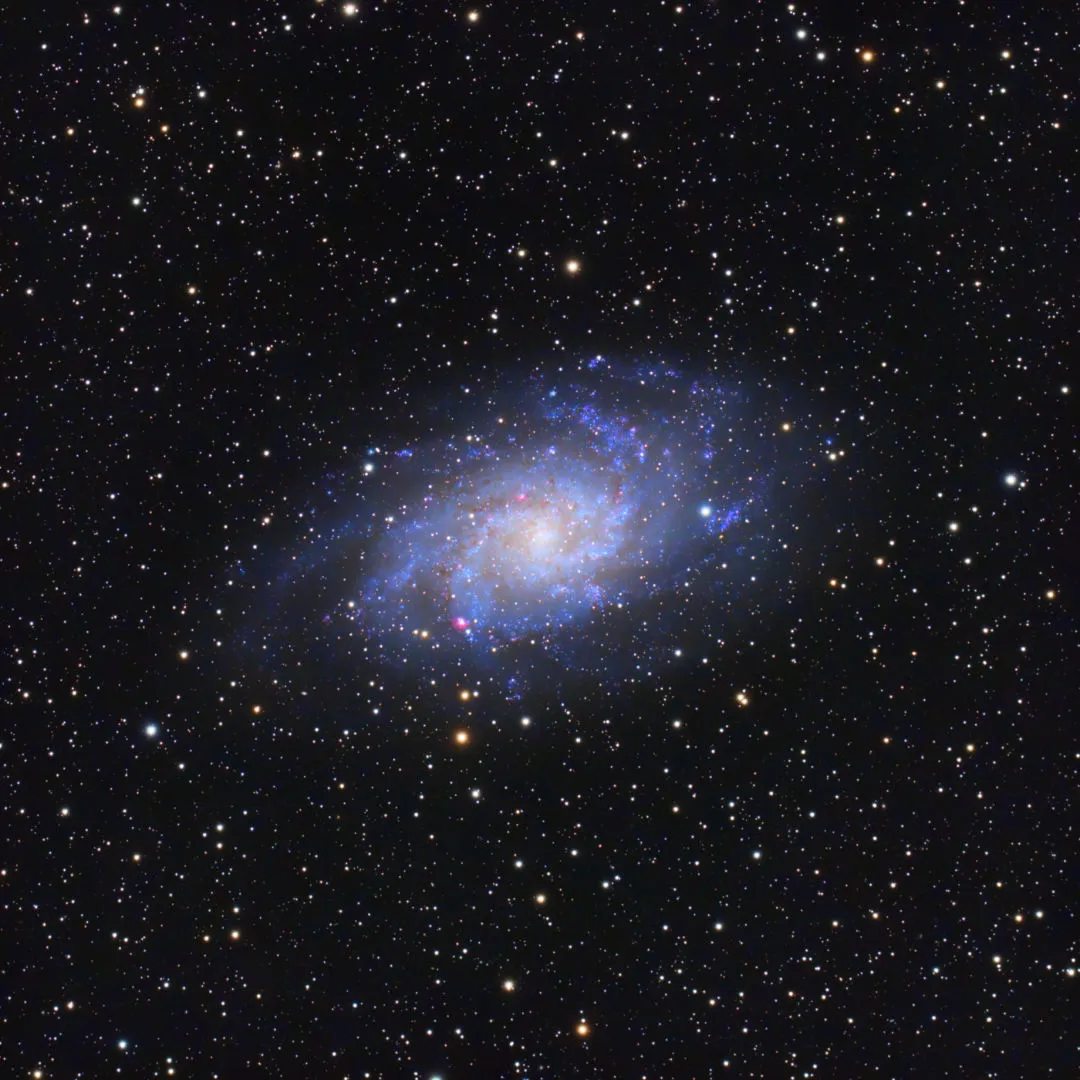
Triangulum, however, contains one of the most beautiful galaxies in the sky, M33 (mag. +5.7, 68’42” x 41’36”), the Triangulum Galaxy, with wide-open spiral arms and a near face-on orientation.
But it is difficult to see in the city and any moisture in the air will make viewing the spiral arms almost impossible.
A UHC-type nebula filter can help and may even reveal a small bright patch on the northeastern edge of the spiral, M33’s titanic nebula NGC 604.
For more advice, read our guide to the Triangulum constellation
Cassiopeia, the queen
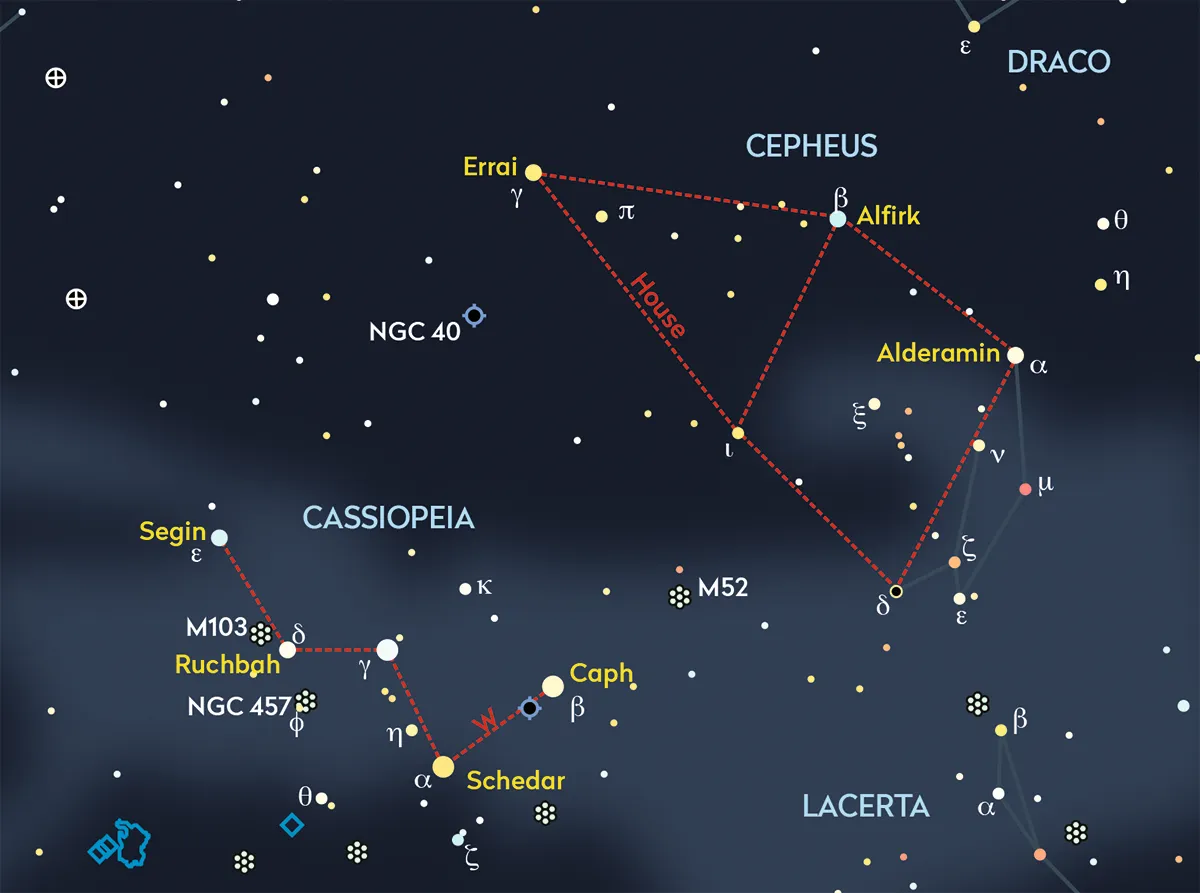
First up is an interesting cluster, NGC 457 (mag. +6.4, 20’ across).
Once you have it in the eyepiece, you’ll understand how it got its nickname, the ET Cluster.
This medium-sized group of stars forms a little stick figure with an upraised arm that seems to be waving across the lightyears.
The googly eyes, one of which is mag. +4.95 star Phi (φ) Cassiopeiae, do suggest a comical extraterrestrial.
There is a red star in ET’s right armpit that makes the cluster look even more attractive.
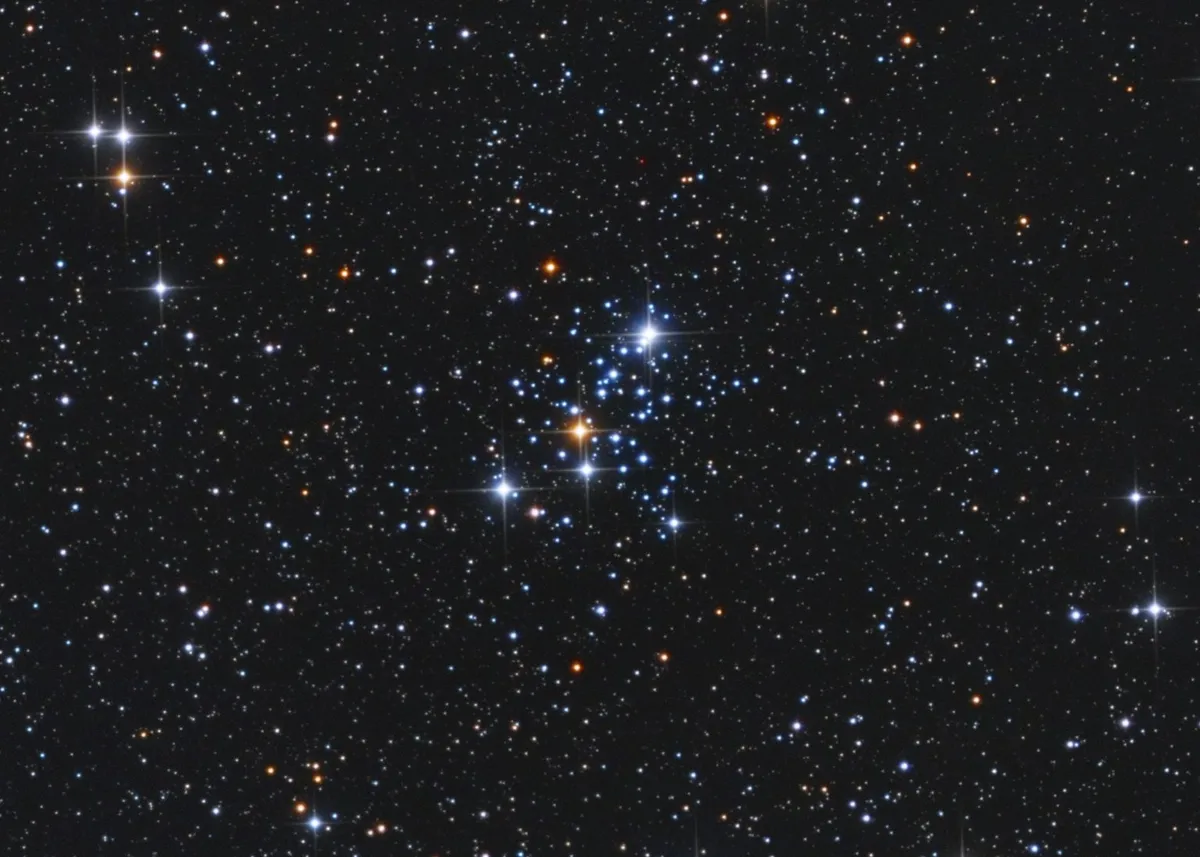
M103 (mag. +7.4, 6’ across) has 40 stars, but expect to see up to 15 from light-polluted areas, depending on aperture.
Luckily, M103’s few suns, which form an equilateral triangle, are scattered across a small area, so it looks rich in the eyepiece.
M103 is better from urban rather than dark sites, as out of the city the cluster melts into the star-rich background.
M52 (mag. +6.9, 16’ across), west of Cassiopeia’s ‘W’, is far better, showing as a larger, brighter and richer circle of at least 20 stars with a 3-to 4-inch refractor.
For more advice, read our guide to the constellation Cassiopeia
Cepheus, the king

The emission nebulae of Cepheus are a challenge for urban observers, but there is one good planetary nebula in the constellation: NGC 40 (mag. +10.9, 37” across), the Bowtie Nebula.
It’s formed by two arcs of material opposite each other around the mag. +11.6 central star, which form the tie’s knot.
The Bowtie’s magnitude sounds forbidding, but that is not a problem as it is small but bright.
Perseus, the hero

This constellation, which represents the hero of the Andromeda myth, is not only distinctive in urban skies, being blessed with numerous bright stars, it holds oneof the most beautiful deep-sky objects in the sky.
Perseus’s treasure is actually two objects, bright open star clusters NGC 869 (mag. +3.8, 30’ across) and NGC 884 (mag. +3.8, 30’ across).
Bold in a small telescope, they sit just 25’ apart.
This is the famous Double Cluster. NGC 869 shows 30 stars to a 2-inch refractor under most conditions, while NGC 884 looks slightly less rich and is also more noticeably elongated.
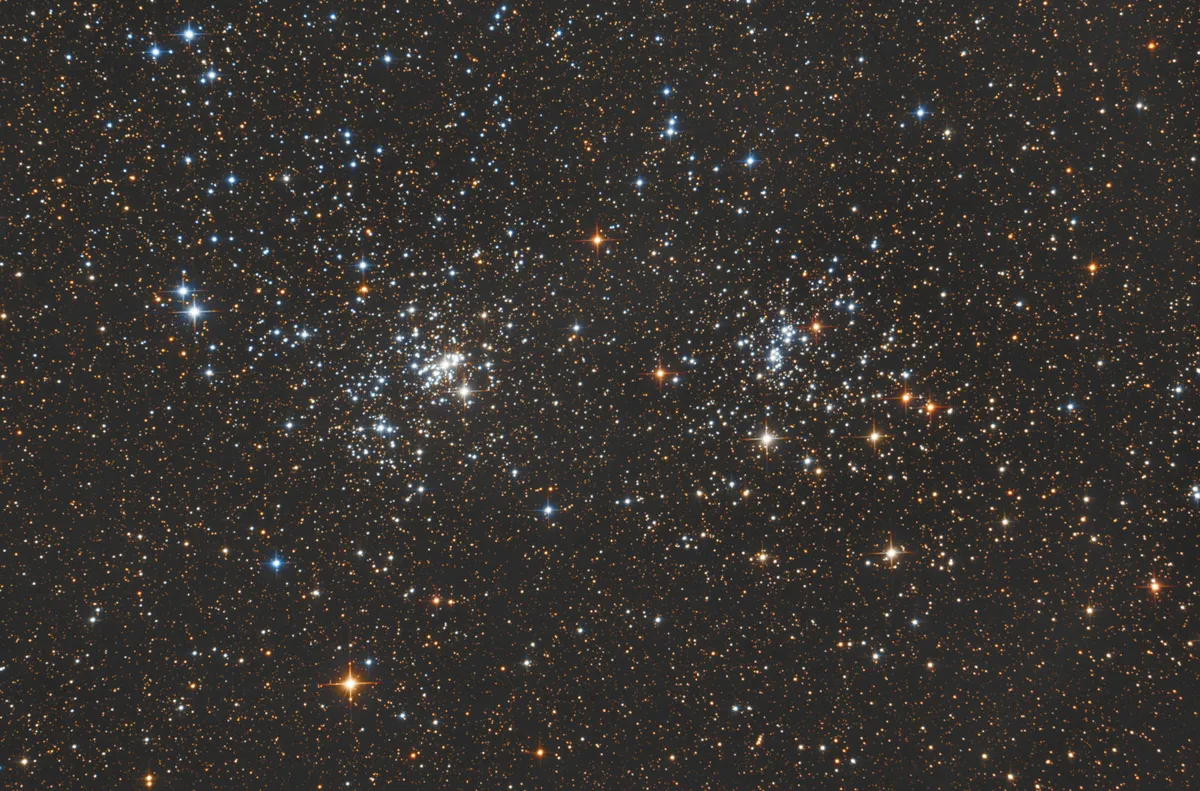
M76 (mag. +10.1, 3’7” x 2’3”), the Little Dumbbell Nebula, isn’t bright but it’s not large either, so its light is concentrated.
It actually looks more like a dumbbell than its more famous relative, M27, the Dumbbell Nebula.
With increased aperture, say a 12-inch reflector, M76 gives up more nebulosity and begins to resemble a rectangle rather than two round spots.
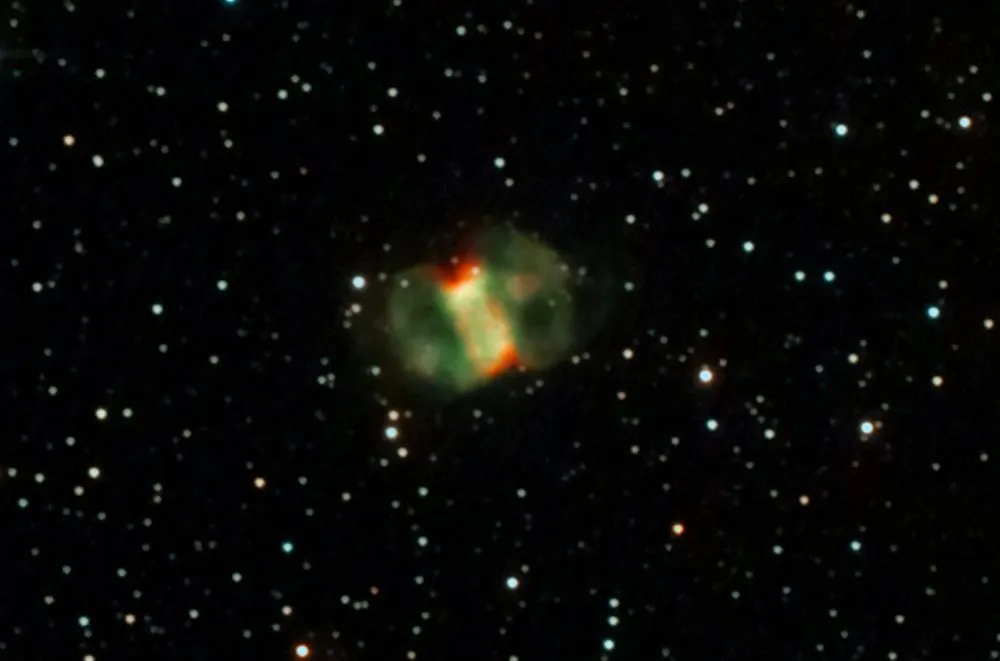
On the best nights, arcs of nebulosity connecting the two lobes become visible.
While the north of Perseus is a place of open clusters, the southern half is littered with galaxies.
Most are beyond the range of urban astronomers with small telescopes, except for one: lenticular galaxy NGC 1023 (mag. +10.2, 4’46” x 2’11”) shines through heavy light pollution and is visible with a 4-inch refractor.
Aquarius, the water bearer
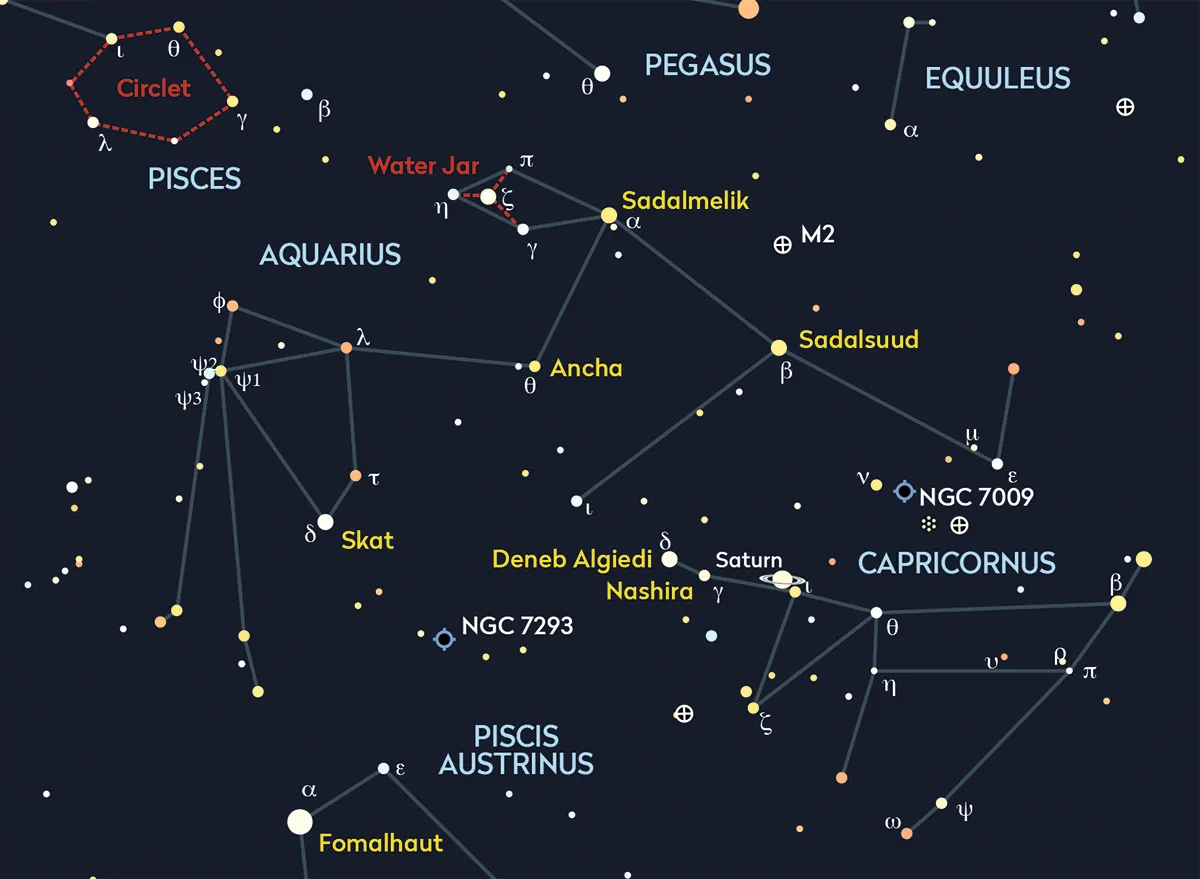
M2 (mag. +6.3, 16’ across) rivals the best globular star clusters of autumn.
In the city, it takes reflectors of 10-inch aperture to resolve the many stars ringing the bright core, but even a 4-inch version provides tantalising views.
NGC 7009 (mag. +8.0, 41” x 34”), the Saturn Nebula, was given its nickname by its discoverer Sir William Herschel in the 18th century.
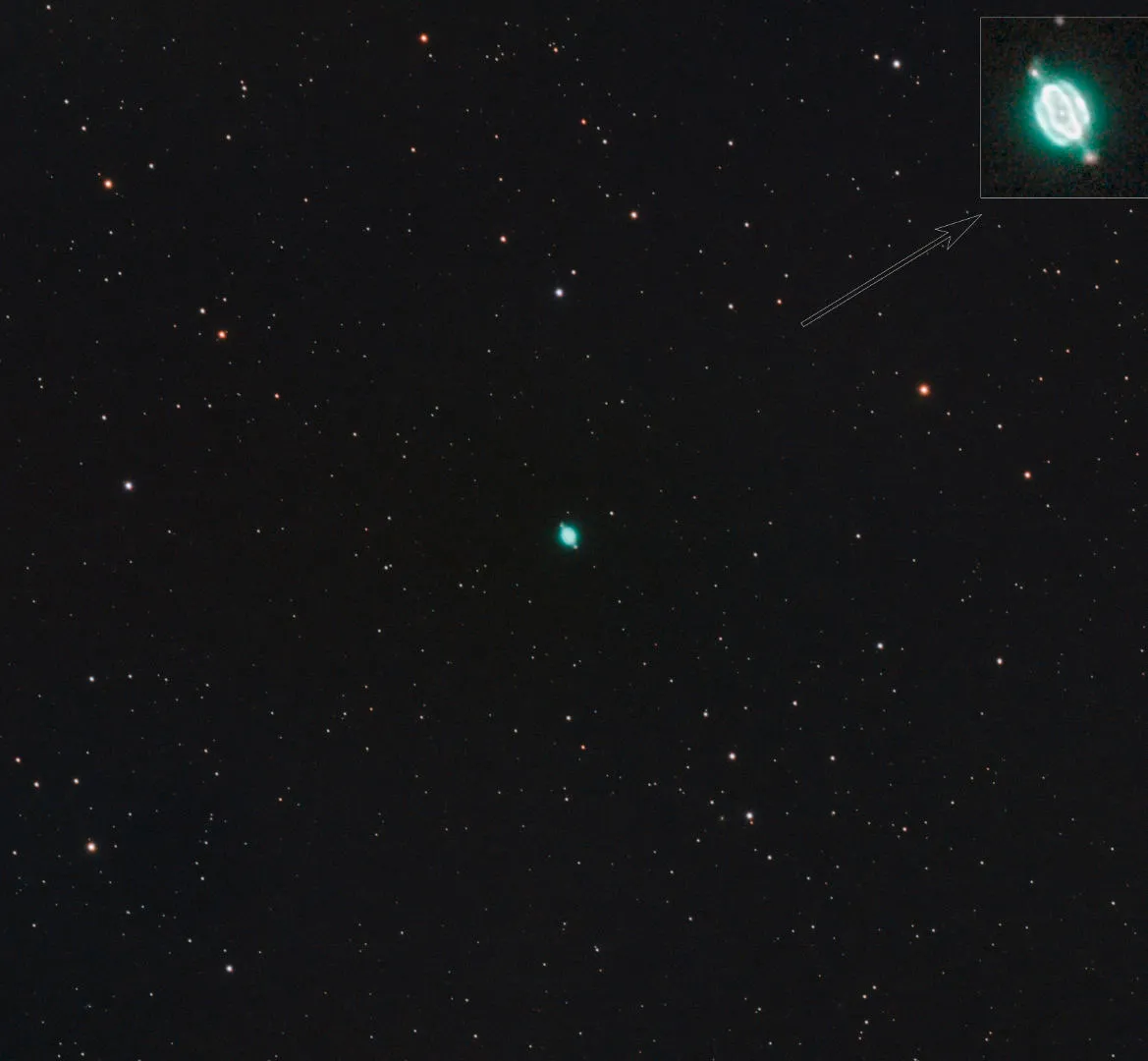
With enough aperture and magnification, it does look a little like Saturn when its rings are edge-on.
NGC 7293 (mag. +7.6, 25’ across), the Helix Nebula, is a great ring of nebulosity that is worth viewing.
An OIII filter shows the nebula’s dark centre and averted vision reveals mottling in the ring and hints of the streamers that give the Helix its name.
Cetus, the whale
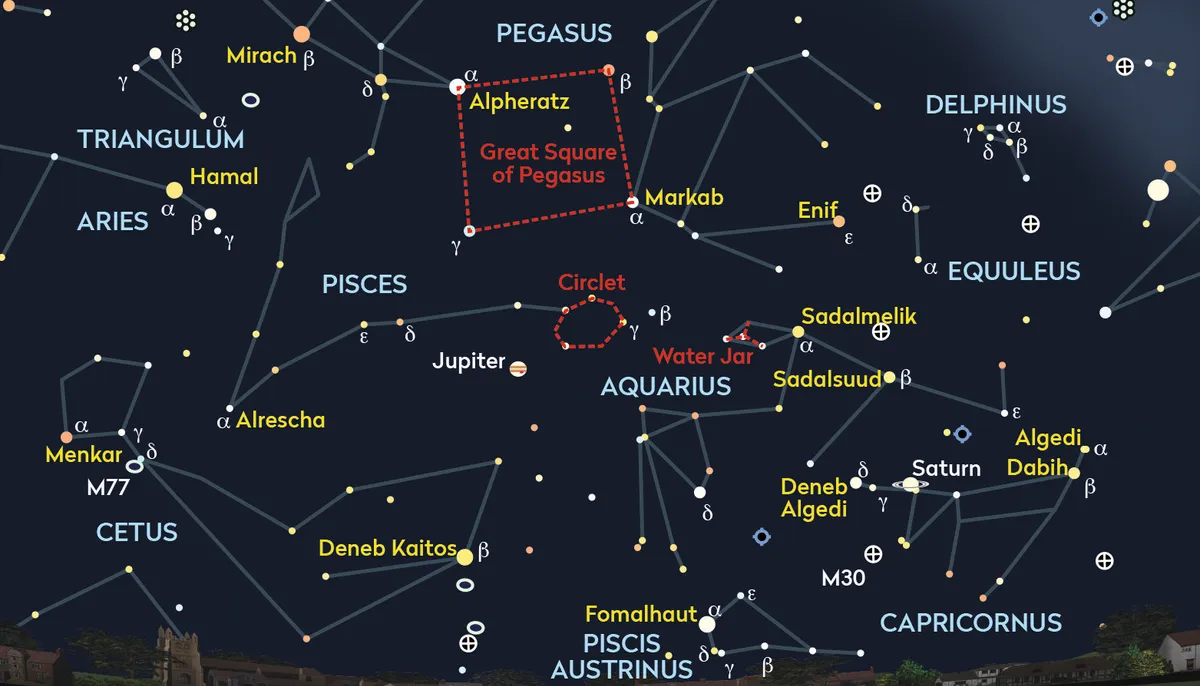
Cetus lies close to the horizon, although the area that contains M77 (mag. +8.8, 7’ across) is slightly higher.
M77 is a Seyfert galaxy, meaning it has a very bright core due to a massive black hole at its centre.
In a 3- or 4-inch reflector, it shows a small, bright central region when using 100x magnification and upwards.
Capricornus, the sea goat
The Sea Goat is often masked by smoke and haze near the horizon – the constellation never gets much higher than 25°.
But it contains M30 (mag. +7.7, 12’ across) which is easy to see with a 6-inch or larger refractor from badly light-polluted areas.
From the suburbs, with a 12-inch refractor and 150x magnification, two streams of stars extend from the cluster, looking like the horns of a goat.
Taurus, the bull
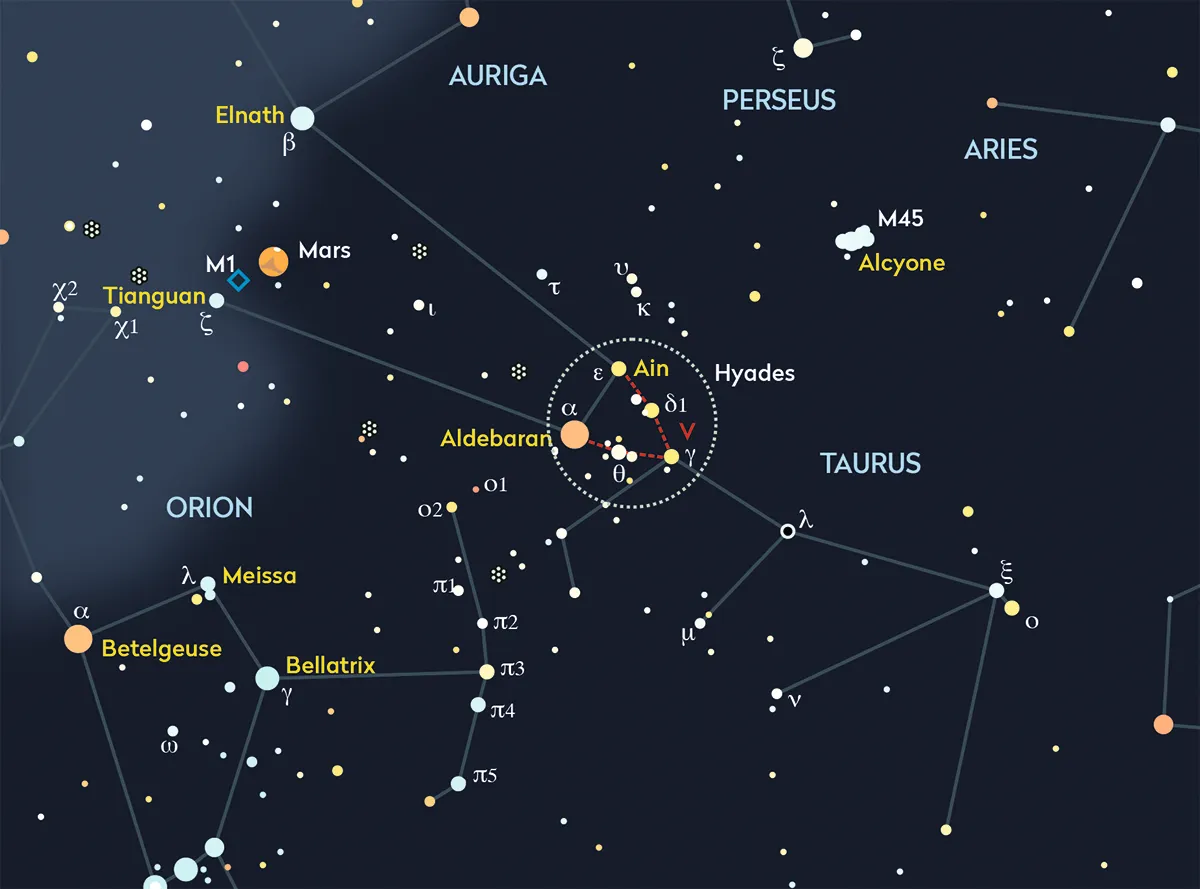
The V-shaped pattern of the face of the Bull is formed from the brightest stars of an open cluster, the Hyades (mag. +0.5, 5°30’).
It is so large because it is so close to Earth – only 151 lightyears away.
The size of the group means it’s best suited to small, short focal length telescopes and binoculars.
M1 (mag. +8.4, 4’ across), the Crab Nebula, was the first object to make it on to Charles Messier’s list.
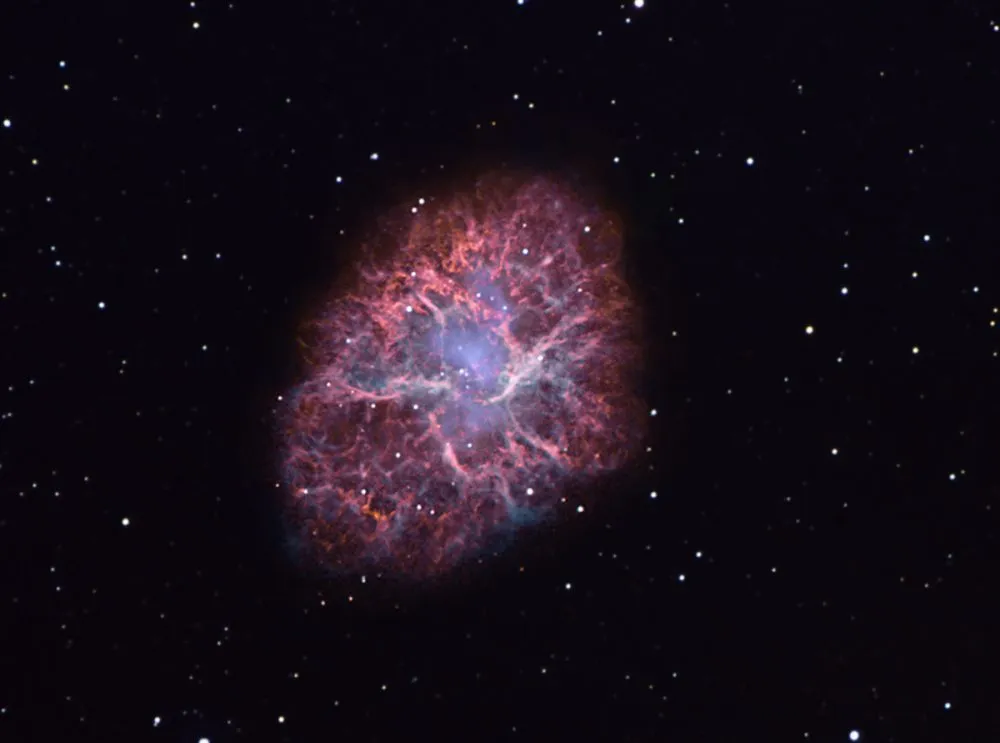
While it is easy to find, only 1° northwest of star Beta (β) Tauri, which forms one of the corners of Auriga’s pentagon, it is badly compromised by light pollution.
You don’t need a telescope or a Go-To system to locate M45 (mag. +1.2, 2°), the justly famous Pleiades – it is a brilliant open cluster.
It can be mistaken for Ursa Minor’s Little Dipper asterism; its brightest stars are arranged in a similar, vaguely dipper-like shape.
The rise of M45, the Pleiades, heralds the end of autumn and the advent of winter.
For more advice, read our guide to the constellation Taurus
Winter constellations
Auriga, the charioteer
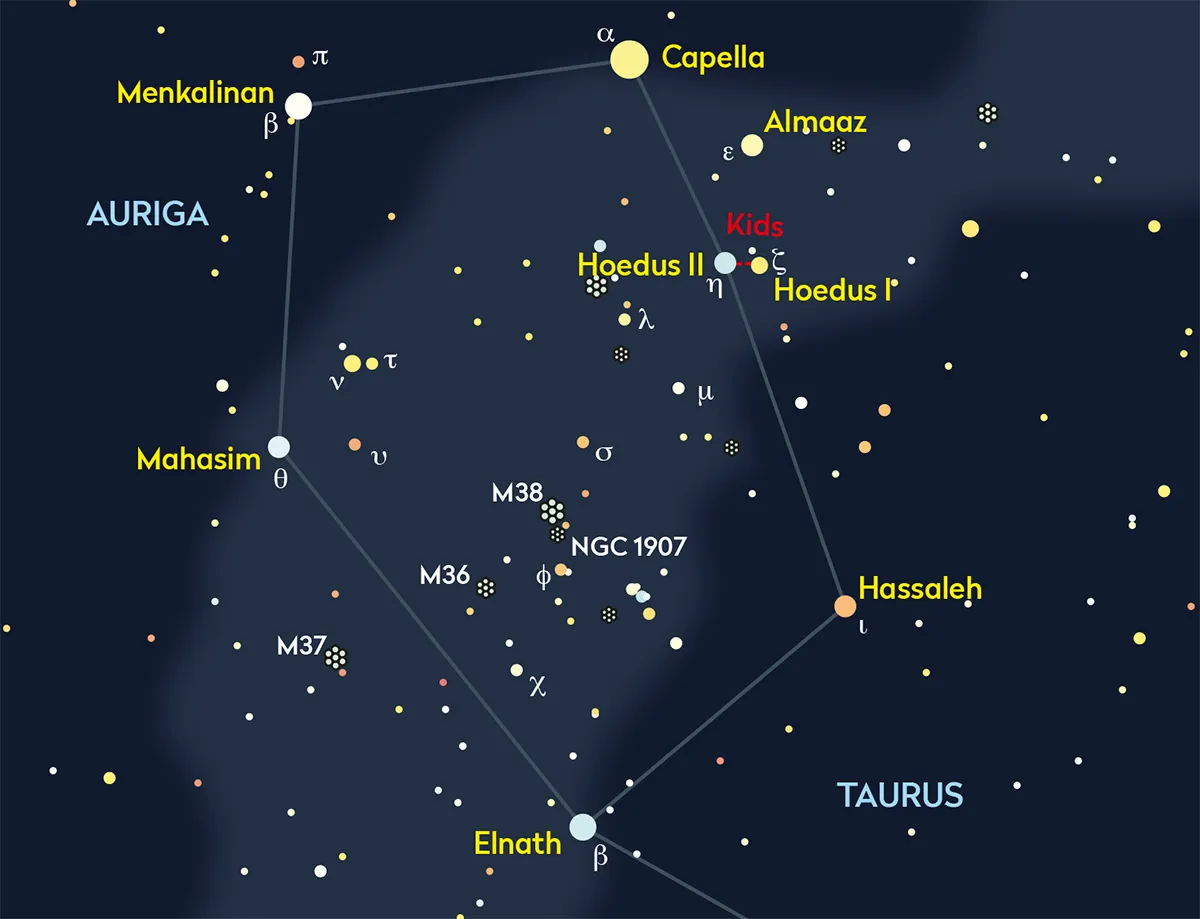
The sprawling pentagon stick-figure of Auriga is home to both open star clusters and diffuse nebulae.
All its nebulae are faint and mostly invisible to urban astronomers, but it is blessed with three beautiful Messier clusters.
The great open cluster M37 (mag. +5.6, 15’ across) is one of the few deep-sky objects that looks wonderful in any telescope under almost any conditions.
It’s not too large for medium aperture, medium-focal-length telescopes (the larger the focal length of a telescope, the smaller its field of view), but also not so small as to fade into the background in smaller, shorter-focal-length instruments.
M37 lies just outside Auriga’s stick figure to the east of a line drawn between bright Mahasim (Theta (θ) Aurigae) and Elnath (Beta (β) Tauri; this ‘fifth’ star in Auriga’s pentagon actually belongs to Taurus).
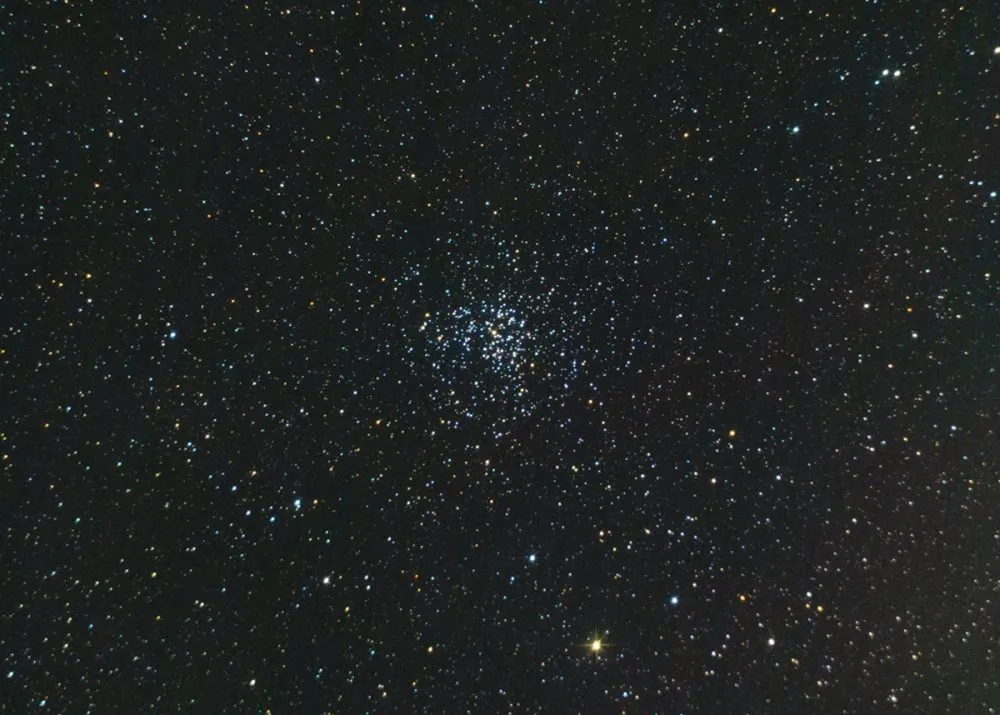
M36 (mag. +6, 10’ across) is also an impressive open cluster, 3°41’ northwest of M37. Bright and compact, it packs a lot of bright stars into a small area. In a 10-inch reflector, it is slightly oval in shape and festooned with bright suns.
A further 2°18’ northwest is the third of the Auriga Trio of open clusters, M38 (mag. +6.4, 15’ across).
M38 is rich with brilliant stars, arranged in lines and streamers extending from the centre, hence its name, the Starfish Cluster. In a low-power eyepiece, M38 looks like a cosmic starfish in a dark sea of night.
NGC 1907 (mag. +8.2, 5’ across) is a dim open cluster, located 32’ southwest of M38. With 8 inches of aperture, you’ll see it even in fairly heavy light pollution – although it will look like a nebulous spot rather than a star cluster.
For more advice, read our guide to the constellation Auriga
Orion, the hunter
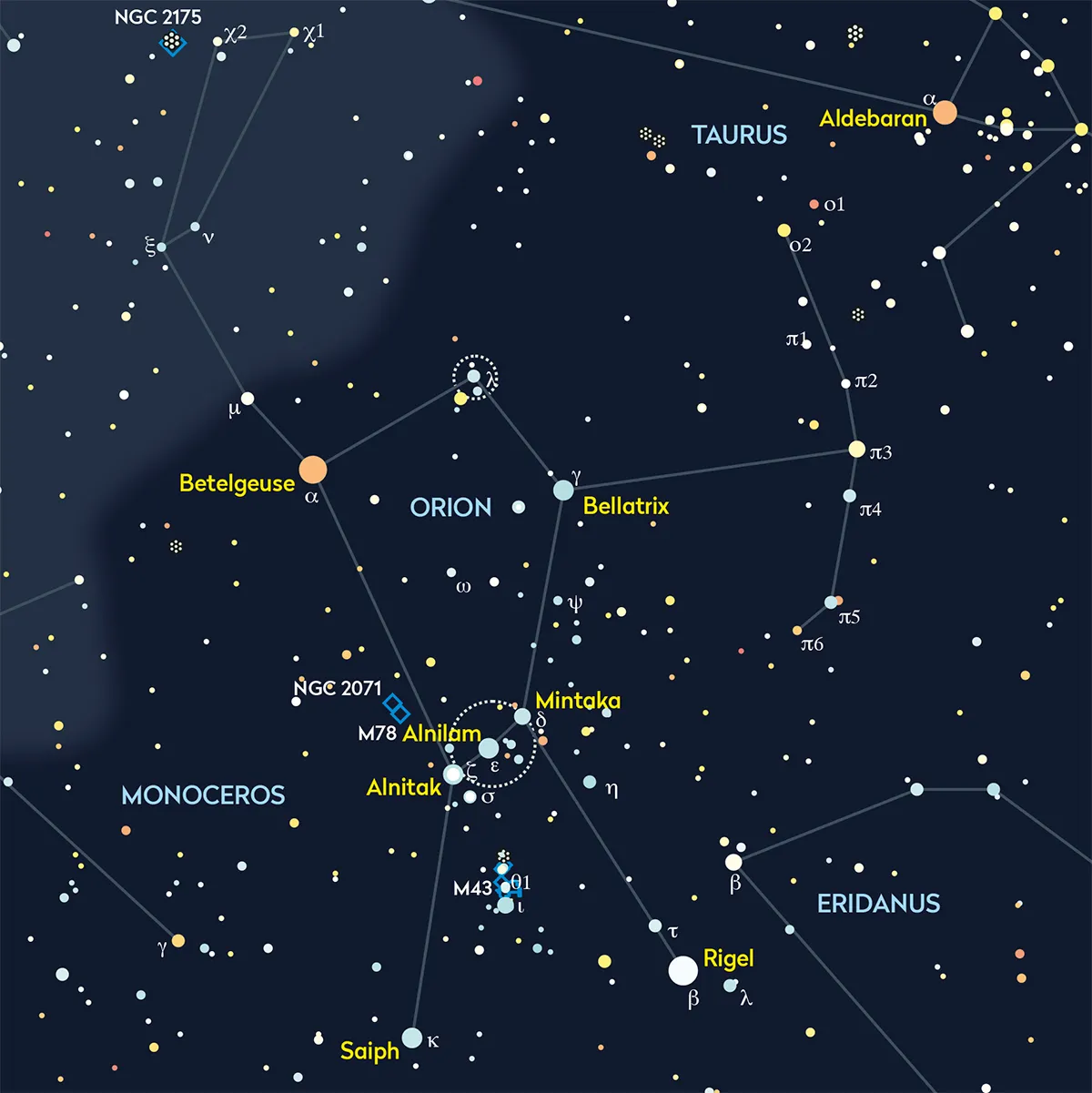
Not only does Orion, the Hunter look like what it’s supposed to depict – a huge human figure with a belt and sword – but its stars, which include bright Betelgeuse and Rigel, also show up well even in heavy light pollution.
The premier deep-sky object of the Northern Hemisphere is M42 (mag. +4, 1° x 1°30’), the Orion Nebula.
This naked-eye object in Orion’s sword is obvious even in the worst city skies.
While city observers won’t see anything close to the nebula’s extent as it is visible from dark skies, they should keep the field of the telescope wide enough to take in as much as possible of the spectacle.
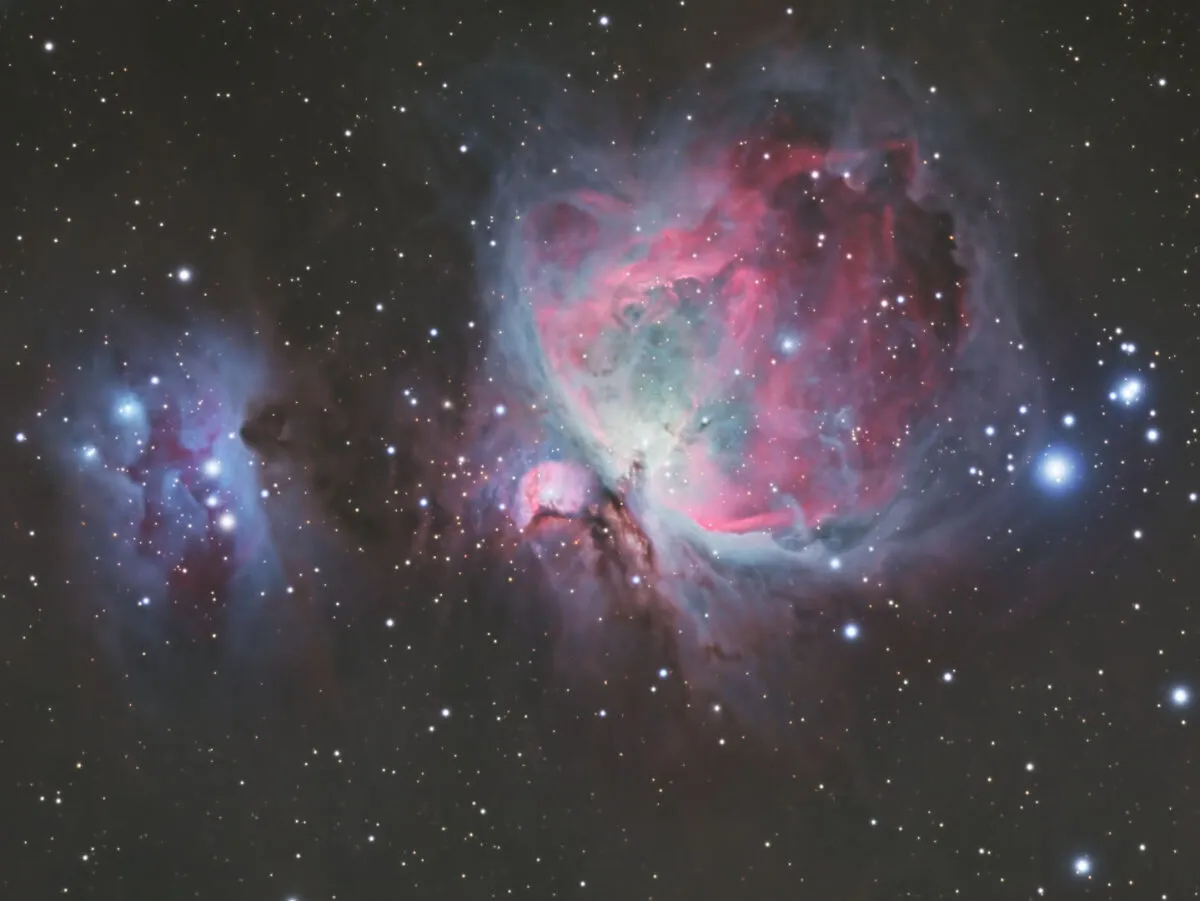
A relatively mild filter like a UHC-type can help, and an OIII filter will reveal some details that are invisible without it.
M43 (mag. +9, 20’ x 15’) is a detached portion of M42 that is bright enough to have received its own M-number.
M43 is easy to find, located on the northern side of the Orion Nebula. In the city, the most noticeable thing in the area is the bright star that M43 surrounds, mag. +6.7 Nu (ν) Orionis
Increase magnification to 100–150x, however, and some nebulosity should become visible. On the best evenings, streaks of dark nebulosity may become visible crossing M43, especially on its eastern side.
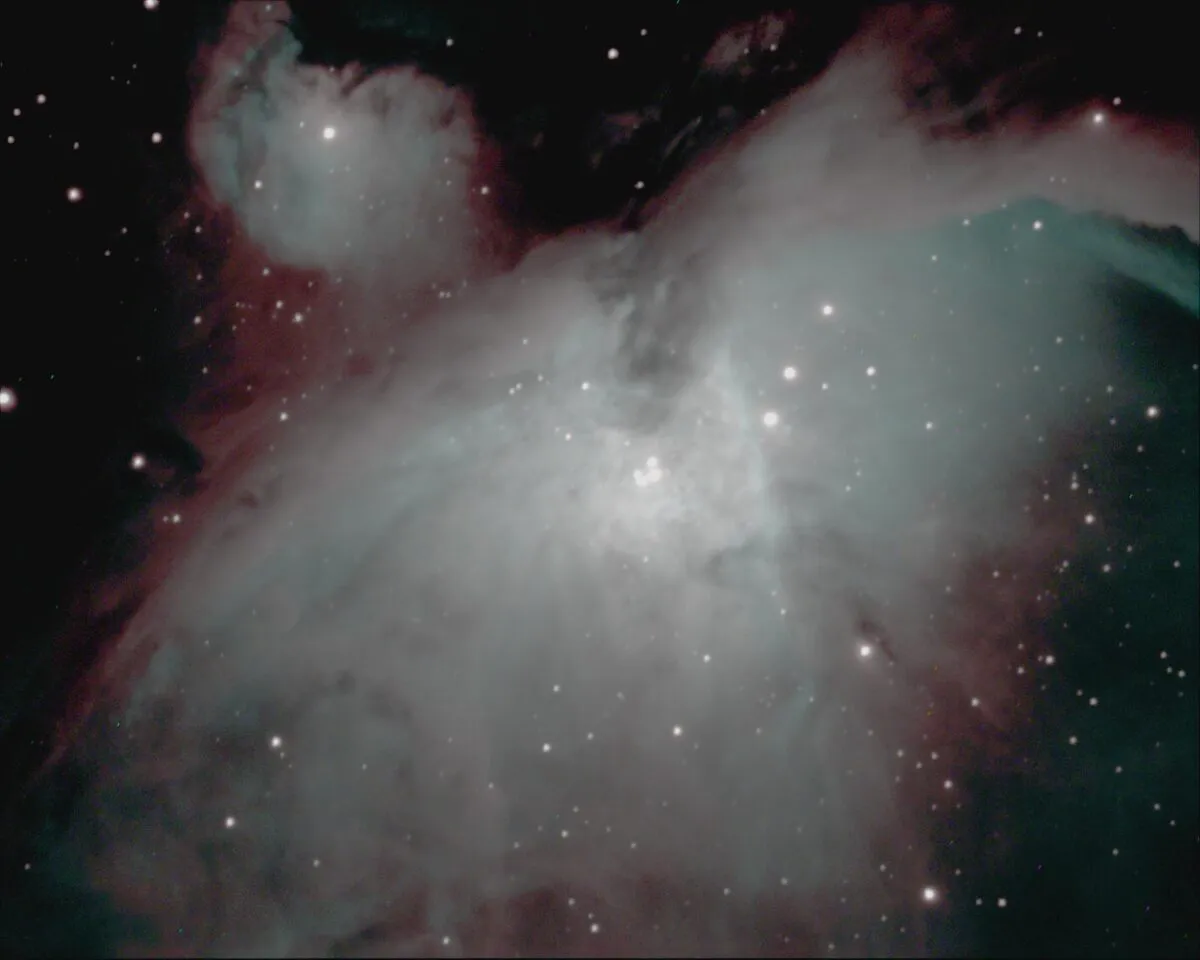
There is one other reasonably bright cloud in Orion, M78 (mag. +8, 8’ x 6’), a reflection nebula in the northeast of the constellation about 2° northeast of bright Alnitak (Zeta (ζ) Orionis), the easternmost star in Orion’s Belt.
On good evenings, M78 begins to look rectangular rather than oval, and the nebulosity extends further out from the stars.
Orion is also a place of open clusters. So many groupings crowd each other in the area that it is sometimes difficult to tell where one ends and another begins.
This is the case for NGC 2175 (mag. +6.8, 40’ x 30’) in the northeastern part of the constellation, not far from the end of the Hunter’s uplifted club.
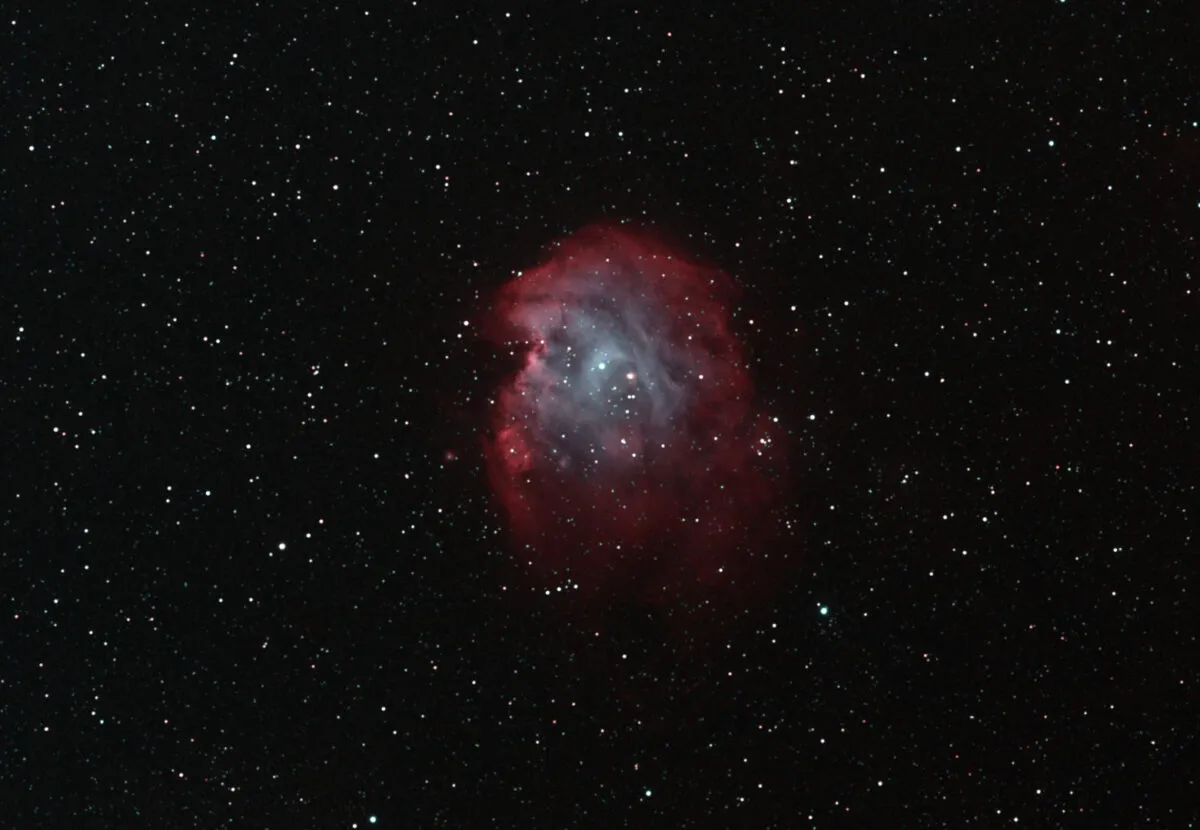
NGC 2175 is on the bland side, but the Monkey Head Nebula that envelops the cluster and extends south is not.
Finally, M42’s Trapezium Cluster, Theta1 (θ1) Orionis, is a remarkable quadruple star – four suns forming a skewed rectangle, a trapezoid. The group is located within M42’s nebulosity, 13’ southeast of Nu Orionis.
For more advice, read our guide to the Orion constellation
Monoceros, the unicorn
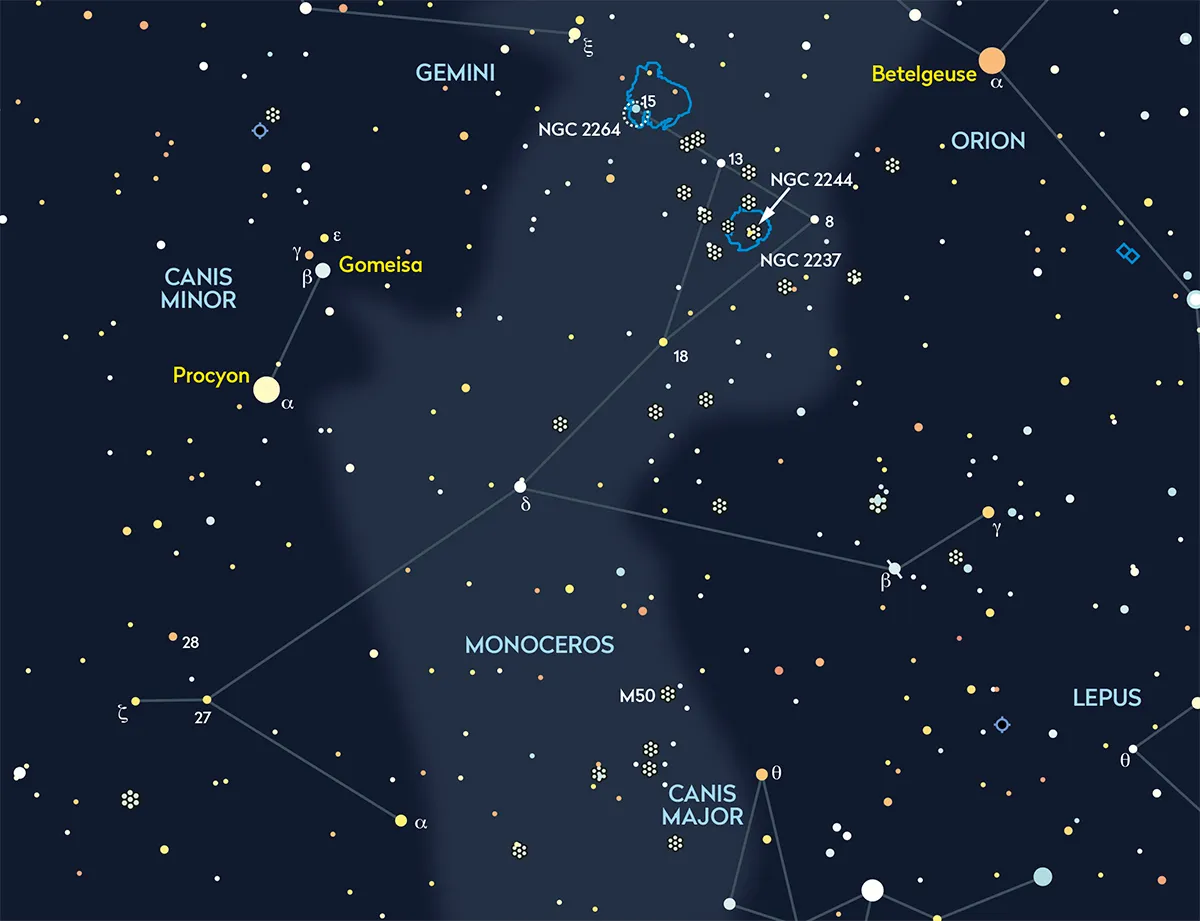
Monoceros lies just east of Orion. In heavy light pollution, its stars may be difficult to see – the brightest sun is a puny mag. +3.9. But there are deep-sky riches waiting to be teased out.
The beautiful Rosette Nebula, NGC 2237 (mag. +5.5, 1°20’ x 1°) is a great, glowing ring of emission nebulosity with a dark centre that looks like a huge Christmas wreath – but it can be challenging to see.
You’ll find that an OIII-type light pollution filter is the key to seeing the Rosette.
At the centre of the Rosette is the beautiful open star cluster NGC 2244 (mag. +4.8, 24’ across).
Unlike the nebula, the cluster is not difficult to see – a bright scattering of stars that form a roughly dipper-shaped asterism.
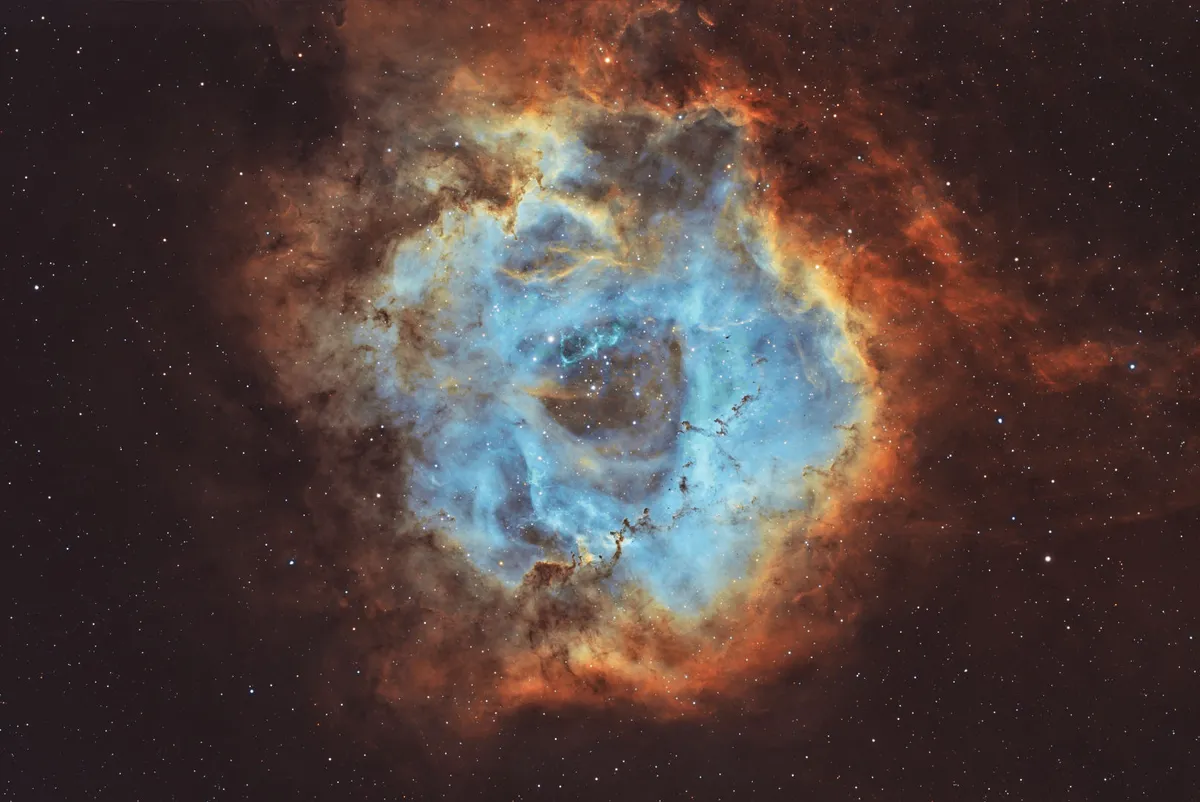
Monoceros has a Christmas tree to go with the wreath. NGC 2264 (mag. +3.9, 10’ x 7’), the Christmas Tree Cluster, is a group of 30–40 bright stars that form (with a little imagination) a recognisable tree shape.
The area of the Christmas Tree Cluster is also an area of nebulosity.
M50 (mag. +5.9, 15’ across), known as the Heart-Shaped Cluster, lies not far from the border with neighbouring Canis Major.
A red star near the cluster’s centre provides a nice contrast with M50’s many blue-white suns.
The grouping is known as the Heart-Shaped Cluster because its arcs of stars form an identifiable Valentine’s heart.
For mor advice, read our guide to the constellation Monoceros
Gemini, the twins
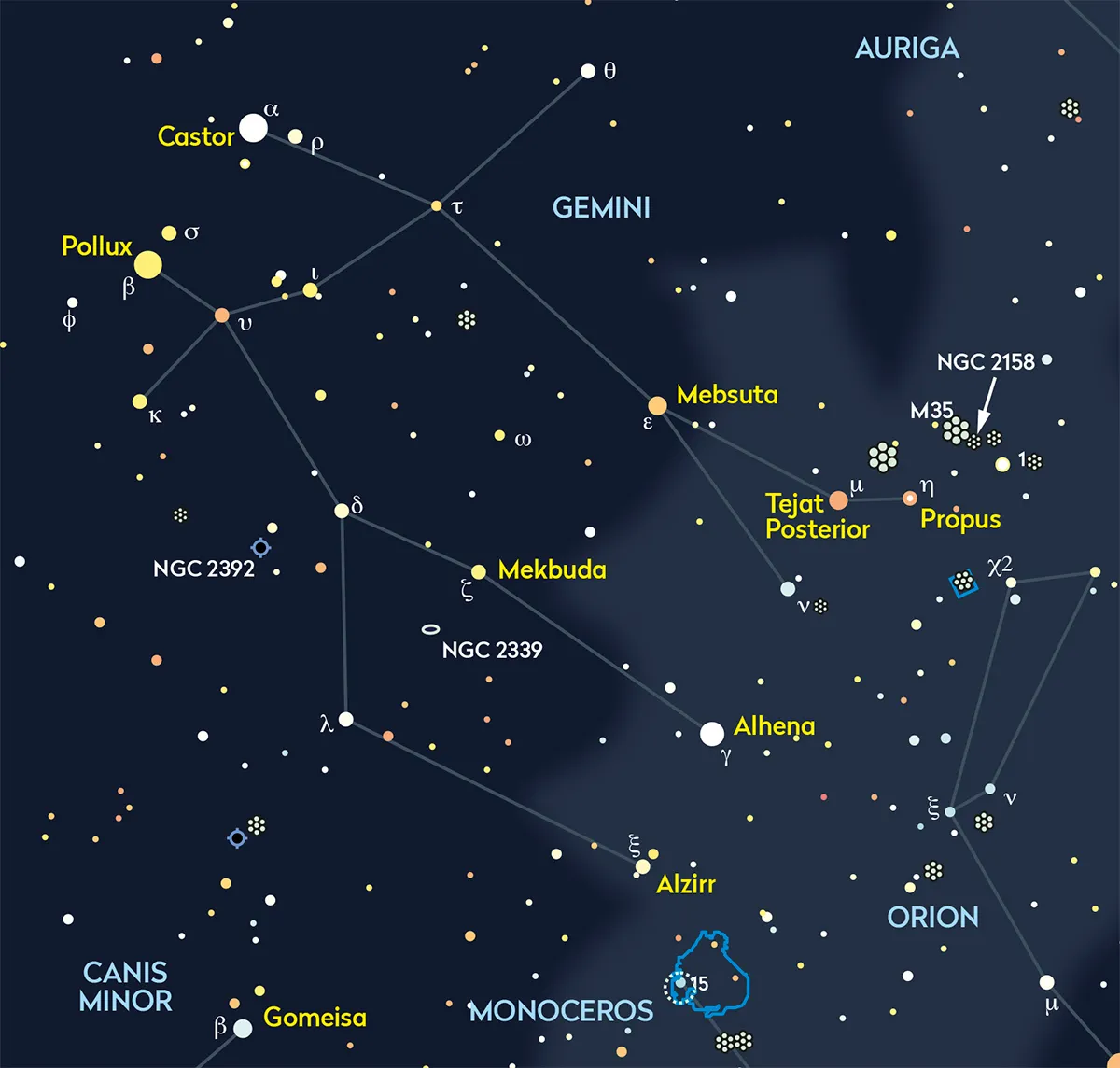
What makes Gemini stand out is the presence of two bright and beautiful stars only 4.5° apart, Castor and Pollux (mag. +1.9 and mag. +1.1, respectively).
These stars form the heads of the legendary twins, and a stream of bright stars extends south from each.
The best way to visualise Gemini is as a huge ‘U’ lying on its side.
M35 (mag. +5.2, 25’ across), located at the southern end of the constellation at the ‘foot’ of Castor, the western twin, is one of the finest star clusters in the sky.
Easy to find even with a small telescope in heavy light pollution, M35 is a round, dense crowd of bright sparklers almost as large as the full Moon – its brightest stars are mag. +8.0.
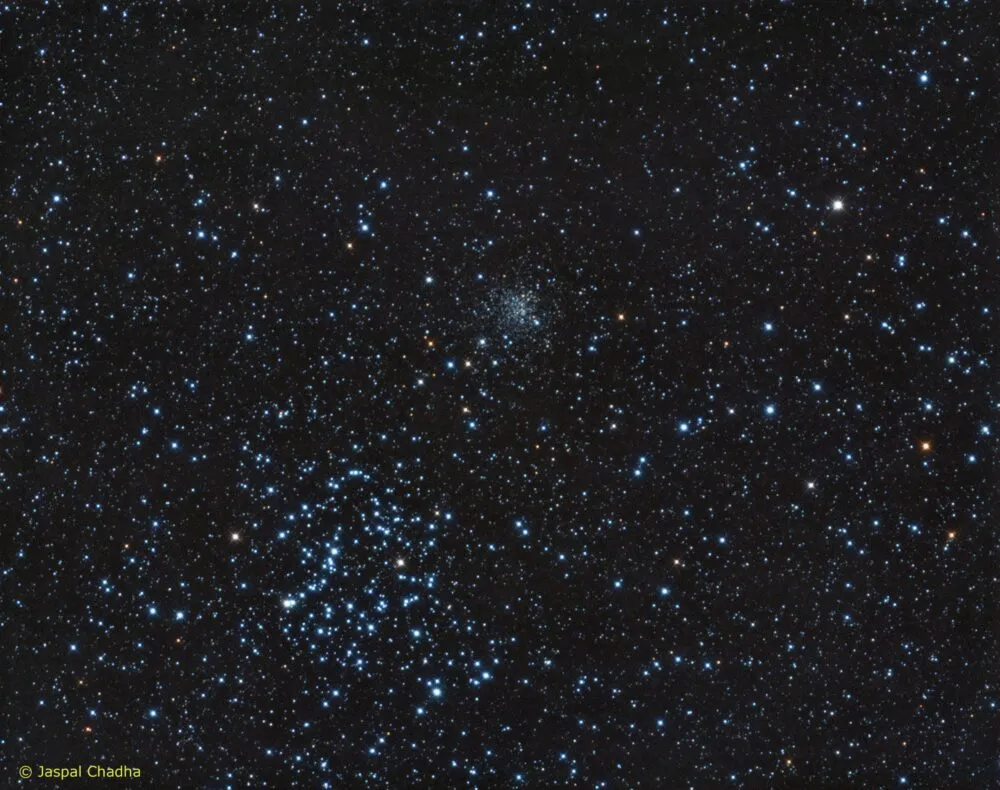
NGC 2158 (mag. +8.6, 5’ across) is an open star cluster located only 27’ southwest of the centre of M35. Despite its closeness to the big cluster, the two are not actually associated.
NGC 2158 is 13,000 lightyears out in space, compared to a distance of ‘only’ 2,800 lightyears for M35.
Their placement alongside each other is just a line-of-sight effect. NGC 2158 is a cluster that cries out for aperture.
Planetary nebula NGC 2392 (mag. +3.5, 48” across) is located a little less than halfway down the constellation, 2°21’ east-southeast of the bright star Delta (δ) Geminorum (Wasat).
Its small size means it can be mistaken for a star.
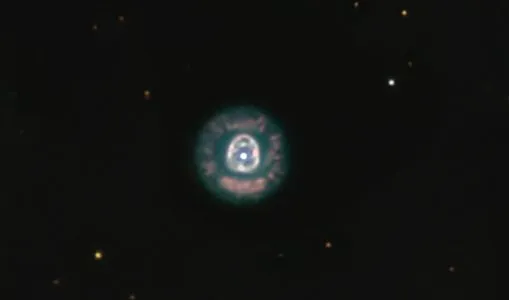
On a good night, 250x magnification will resolve the mag. +10.5 central star, while going up to 300x reveals hints of an inner ring, what’s been described as looking like the ‘furry hood’ of a parka coat, a detail that is more visible in photographs.
Spiral galaxy NGC 2339 (mag. +12.3, 2.4’ across) is on the eastern side of the constellation, 4°13’ southwest of mag. +3.5 Wasat.
Observing this galaxy requires patience, a good night in the suburbs and at least 10 inches of aperture.
For more advice read our guide to the constellation Gemini.
Canis Major, the big dog
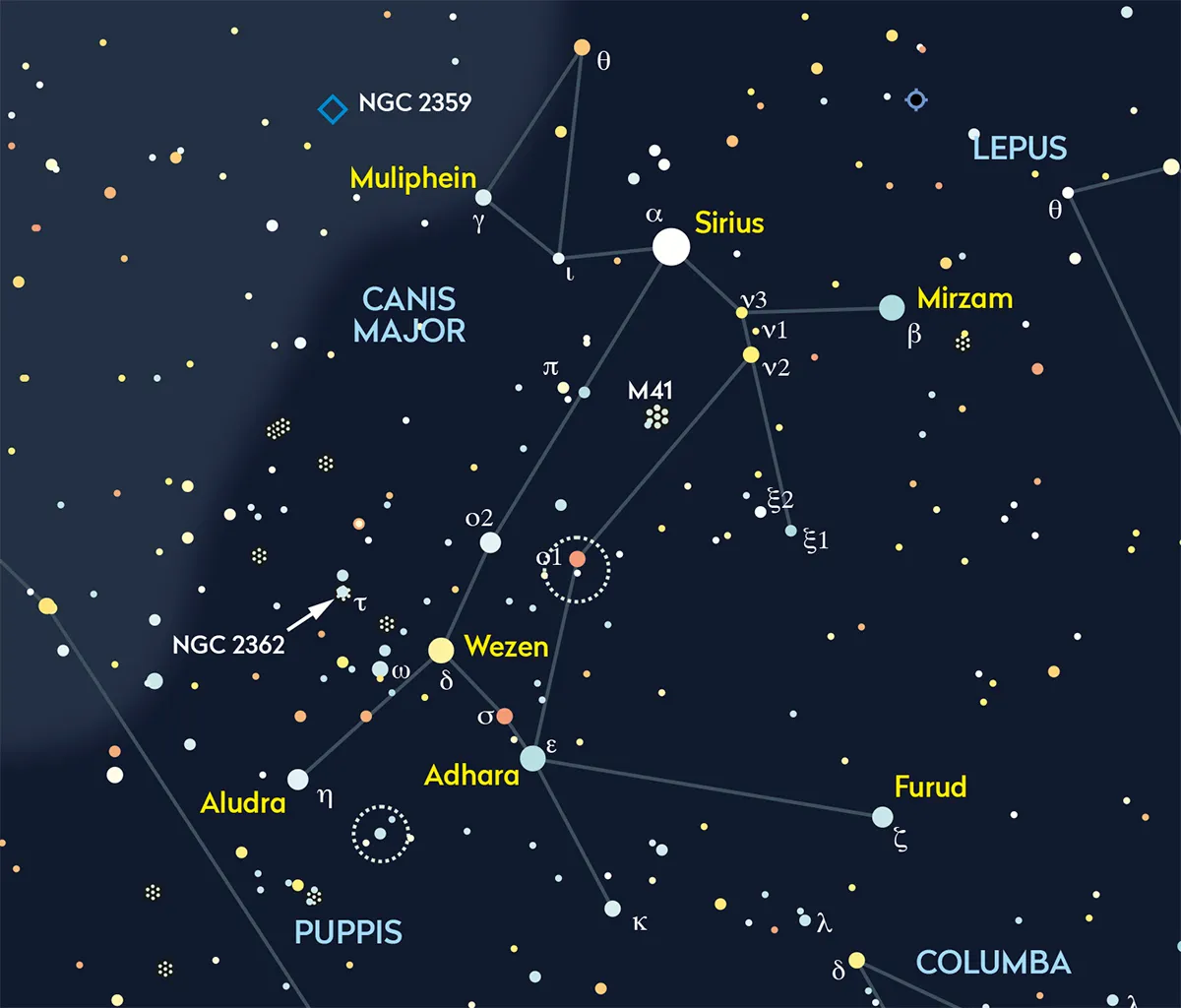
Although it never gets high enough in the sky to rival other open clusters, M41 (mag. +4.5, 39’ x 39’), the Little Beehive Cluster, is still a marvel – a large group of 60 stars spread across an area larger than the full Moon.
Most of M41’s suns are bright, making it a naked-eye object from sufficiently dark sites.
Luckily, M41 is located in the more northerly area of the constellation, 4° south of Sirius, and is somewhat away from the haze of the horizon.
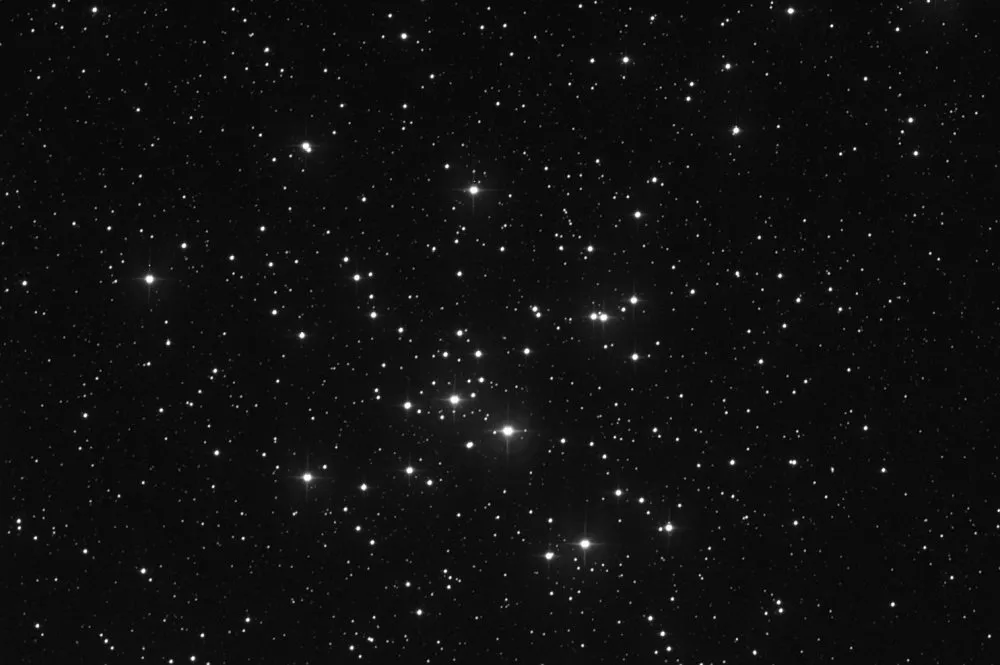
To improve the appearance of this group in the city, try using a mild light-pollution filter, a ‘Skyglow’ or ‘Deep Sky’-type filter.
This has the effect of darkening the background a bit, but not dimming the bright cluster stars too much. One of M41’s more striking features is the strongly orange-red sun near the cluster’s centre.
The outstanding nebula, NGC 2359 (mag. +11.5, 10’ x 10’), Thor’s Helmet Nebula, is a faint cloud of ionised gas.
Thrown off by a Wolf–Rayet star, this cloud of gas is just visible from urban sites using a 12-inch Dobsonian reflector and a UHC filter.
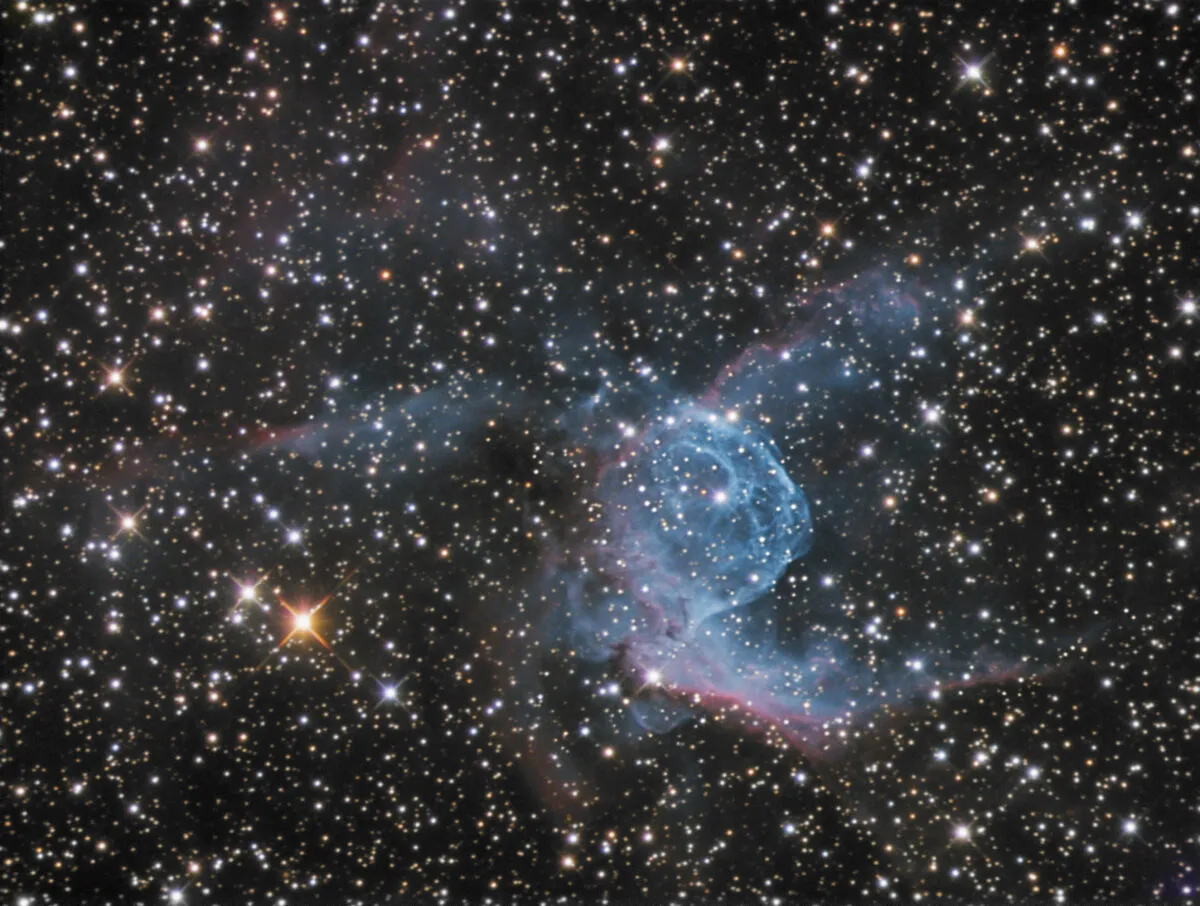
NGC 2362 (mag. +4.1, 8’ x 8’) requires a trip to the far south, to a declination of –24°57’.
At best, this cluster only climbs 13° or less into the UK skies, so wait until it is on the local meridian, when it is as high as it gets, before attempting to observe it.
Like most open clusters, NGC 2362 is not difficult to catch, and its 20 to 30 stars are obvious in the eyepiece even when it is at low altitude in the sky.
In the midst of NGC 2362 is bright-yellow mag. +4.3 Tau (τ) Canis Majoris, the Jumping Spider Star.
Due to contrast effects, when you jiggle the telescope, the halo of tiny amber suns surrounding Tau appear to move in one direction, while Tau seems to move in the opposite direction – the spider jumps!
For more advice, read our guide to the constellation Canis Major
What are your favourite constellations? Send us your thoughts and images by emailing contactus@skyatnightmagazine.com
This article originally appeared in the April 2022, July 2022, October 2022 and January 2023 issues of BBC Sky at Night Magazine.
